Arrows And Olive Shoots








The Albert And Jentje Smit Family
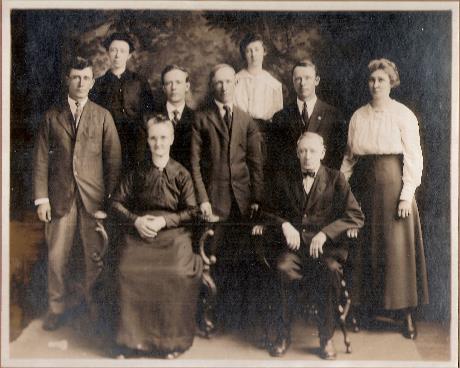
Part 1
Hoogeveen, Drenthe, Netherlands
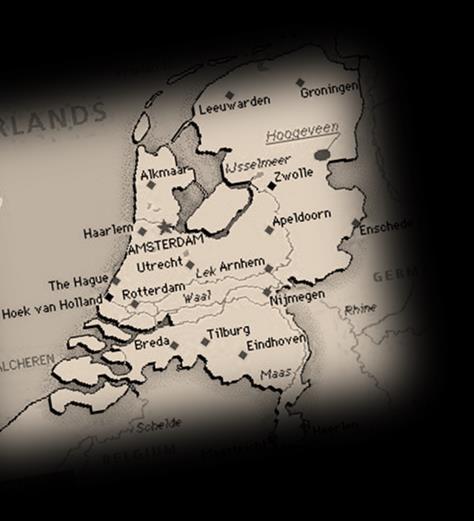
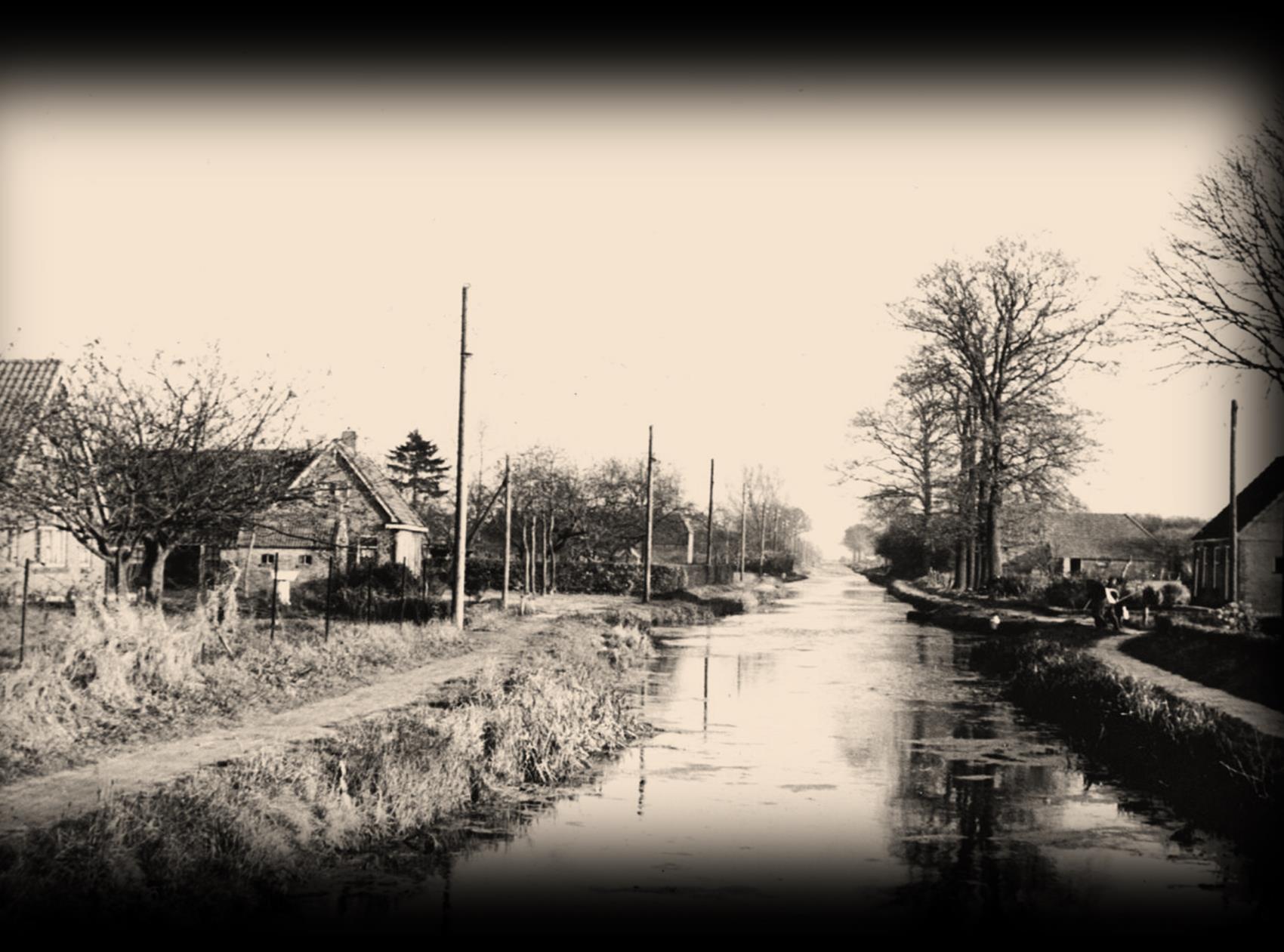 By Charles Micheals
By Charles Micheals

This book is provided free of charge. However, if you would like to make a gift to the ongoing work of the author and his work with Wycliffe Bible Translators and help cover the cost of producing this book and others like it, please go to:
Supporting Charles and Barbara Micheals' Work With Wycliffe Bible Translators
1 | Page
Arrows And Olive Shoots
Part 1 - The Albert And Jentje Smit Family



2 | Page
The Albert and Jentje Smit Family in South Africa
(Back Row L - R) Albert, Jentje, Albert Jr. (standing on the table), (Front Row L – R) Jannes (James) sitting, Garret, Susie, Alice (on Susie’s lap), John (standing) (Photo courtesy of Charles Micheals)
© 2015 Charles J. Micheals
Published by the Micheals Historical Society

All rights reserved. No part of this publication may be reproduced, stored in a retrieval system, or transmitted, in any form or by any means, electronic, mechanical, photocopying, recording, or otherwise, without prior written permission of the publisher.
ISBN: Pending
First Printing 2015 (Not for Sale)
Unless otherwise indicated, all Scripture quotations are from the ESV ® Bible, (The Holy Bible, English Standard Version). Copyright © 2001 by Crossway, a publishing ministry of Good News Publishers. Used by permission. All rights reserved.
3 | Page
Dedication
To the pastors, elders and other churchmen who taught our family the Scriptures.
4 | Page
“Children are a heritage from the LORD, offspring a reward from him. Like arrows in the hands of a warrior are children born in one’s youth. Blessed is the man whose quiver is full of them.”
Psalm 127: 3 - 4
“Your wife will be like a fruitful vine within your house; your children will be like olive shoots around your table. Yes, this will be the blessing for the man who fears the LORD.”
Psalm 128: 3 - 4

5 | Page
Arrows And Olive Shoots
Part 1 - The Albert And Jentje Smit Family
Preface
This book is the first in a series of seven books which details the family line of Charles and Barbara Micheals. This first book details the Smit family, which is the family line of my mother’s mother. A second book will detail the Mejeur family, which will detail the family line of my mother’s father. A third book will detail the Meyer family, which will detail the family line of my mother’s aunt and uncle who raised my mother. The fourth book will detail the King family, which will detail the line of my father’s mother. The fifth book will detail the Micheals family, which will deal with the detail of my father’s father. The sixth book will detail the Stapert family, which will detail the line of Barbara’s mother. The seventh and final book will detail the Smith family, which will detail the line of Barbara’s father
As for this first book of the Smit family, the first record of our family can be traced back to before the founding of Hoogeveen in the Netherlands. Evert Jans Smit is recorded as being born in the city, but his recorded birthdate is listed as happening before the actual founding of the city. As with all of the early people in the Smit ancestry line, the dates of their birth and their death are approximate. While some information may be available about these early ancestors, it would most likely be found in the library and town hall records at Hoogeveen, for the great majority of the Smits came from this town.
Many of the records found online of these ancestors are written in either one of the dialects of the Dutch language or the Dutch language itself. Likely records stored in Hoogeveen will be in the Dutch language. No effort has been made at this point for researching the family tree directly from the sources found in Hoogeveen or in other localities in the Netherlands. Cemeteries and the records contained in their archives would no doubt shed much more knowledge on the family. Sadly, much information is probably
6 | Page
lost and some information may even be inaccurate. Therefore, any further research should be carried out with as much detail as possible to ascertain the reliability of the data as possible.
Searching along with others who are looking for their ancestors may prove beneficial as well. However, caution should be given to quickly relying on such material collected. Research for this book discovered a number of other family trees that did not contain accurate information. Other research, like this often builds on what others have collected, but information needs to be verified to prevent incorrect information from being used.
The information gathered in this book is as accurate as possible. While not a perfect summary of the family can be guaranteed, the information presented is as accurate as one can make it at this point. Any incorrect information which comes to light will be corrected when it can be verified.
The format of this book will detail basic information about the people of the Smit family and the times and places where they lived. Each section not only includes the names of the Smit family, their spouses and children along with as much information about their birth (B.) and death (D.) dates and the place of these events (H.) plus their burial sites (BU.). It will also include a brief summary of the places and events that took place during the lives of the people mentioned.
It is safe to assume that there are many more dates and cities to be discovered plus other stories about the Smit family that have been recorded. Therefore, efforts need to continue to be made to add to this book as time goes on for the benefit of future generations.
My hopes are to preserve for our generation and futures ones the rich heritage we have as a family. While it may bore some to tears, others will be enriched by the people and the lives they lived and the rich and varied experiences of the places and times they lived in.
As they say in Dutch, “Ik hoop dat je geniet ervan.” I hope you enjoy it!
7 | Page
Belonging to a loving family is a longing in every person’s heart in every land and culture. Some find fleeting happiness in such a family for a short time, while some even find fulfillment for decades. However, only God can fill the true longings of the heart and once adopted into His family by grace through faith in Jesus Christ true and lasting joy can be found.
By God’s Providence, He knit the lives of many immigrant families described into his book from different places, times and circumstances into the much larger Smit family that I describe in this book. Thus, these people and their families have become the story of my family, for which I give thanks to God for.
The stories in this book have been written by people from the Smit family They tell of the hopes, aspirations and triumphs of this family. However, they also tell how some of their dreams didn’t materialize, the struggles in their lives when they left home and family, the hardships due to war and illness and their sorrow in the death of family members.
However, the main purpose of this book isn’t to tell their stories, but to give glory to God as you read them. This book, therefore, is ultimately about the goodness of God in not only giving His common grace to this family, but to testify about those who have been regenerated by the power of God by grace alone, through faith alone, in Christ alone, through the working of the Holy Spirit through His Word alone that He has also given His salvific or saving grace. Therefore, when you read these stories, do so in the light of a people who have believed and put their trust in the One who can and does save.
“But to all who did receive him [Jesus], who believed in his name, he gave the right to become children of God.” John 1: 12
As you read this book several facts stand out very clearly, although not apparent immediately nor when you look individually at each family line. The first fact is that man’s fame is fleeting. Before I began my research I of course knew my parents. Most people know that and many of us also know who our grandparents are. However, few before embarking on a journey of discovering their family ancestry, know who their great grandparents are and if they do know them they likely know them only by name. Such
8 | Page
Introduction
was my knowledge. Beyond our great grandparents almost no one knows who their great-great grandparents were nor any family members before them.
As you reflect on this fact, it is hard to imagine that their entire lives, all of their work, ambitions and dreams have vanished from our collective memory. While they were alive, they lived lives much like our own, albeit in a different time and place. Their dreams and hopes to marry, raise a family, start a business, live well and healthy, learn and aspire to greater things and care for their parents and grandparents is our own story. Yet, we know nothing about them past a few generations.
Likewise, another fact that comes to light is the fleeting memories of the work they did in life or the businesses they operated. Many in the Smit family were farmers and while we know of their homelands, we really know nothing of the actual work they toiled so long and hard in. We don’t know the people who worked for them or they worked for, the families they supported, the people they served in their businesses, etc. In fact, a quick reading of any city directory in a town like Kalamazoo, Michigan where many of the Smits started their lives in America, it will show that almost every single business that existed 100 years ago does not exist anymore. The products they sold are no longer needed or wanted. Peat, which was sold in Hoogeveen by the Smit family in the province of Drenthe in the Netherlands, was eventually replaced likely by coal or a similar product. The house I grew up in in Kalamazoo, Michigan was built to use coal, but by the time it was actually built the house was using an oil furnace, which was eventually replaced by gas. Today, we use natural gas and even solar.
Now imagine the amount of time, effort and energy we spend today in our businesses and then reflect on the fact that within 100 years, the work we are doing today will most likely not be around and will be forgotten. Certainly few of the businesses today will remain as it in 100 years and yet we place so much effort into building our businesses or work places.
Now, that leads us to the third and most important fact to consider and that is the spiritual side of life. One thing that was around in the time of the earliest Smit ancestors was the Church. By that I mean the church that Jesus Christ established. Today, I would describe that church as the Protestant, evangelical church and in the case of many of the Smit ancestors, the Reformed church. The church that grew out of the Protestant Reformation, the church fashioned after the teachings of the Apostle Paul and reformers like John Calvin and of Jesus Himself.
9 | Page
That church has two parts: Those who are part of the visible church (people who have become members of churches by virtue of their baptism) and those who are a part of the invisible church or the true church, the church of the true believers. That is the invisible church made up of those who have been called by God Himself from before the foundation of the world for this salvation (the elect) and thus have put their trust in Jesus Christ alone for salvation. It is those who have had their sins forgiven by the death of Jesus Christ on the cross, those who have been regenerated by the power of the Holy Spirit through the preaching of the Word and those who are being sanctified by that Holy Spirit and thus those whose names are written in the Book of Life.
Some families have no family members in either part of the church (visible or invisible), but there have been many Smit family members who have been a part of the visible church and by God’s grace also the invisible church and while we can trace the importance of the visible church in the Smit family from its start, the invisible members are known to others by the fruit they bear for the Kingdom of God (Galatians 5:22) and their testimony of the Gospel. More importantly, they are known by God and called by His name!
The true church is the only constant in our family which goes as far back as time records for us and that Gospel which was preached in that early church is the same Gospel that is preached in true evangelical churches today. While family names and businesses have all but been forgotten, only the true church has continued on throughout our past generations and the ones who are alive with Christ!
That Gospel has passed on from one generation to the next, and while it is unlikely that every Smit recorded in this book or alive today has had this true faith, it is certainly a faith passed on and each person in our family has the duty to believe.
Mark 1: 15, “The time is fulfilled, and the kingdom of God is at hand; repent and believe in the gospel.”
John 3: 16 – 21, For God so loved the world, that he gave his only Son, that whoever believes in him should not perish but have eternal life. For God did not send his Son into the world to condemn the world, but in order that the world might be saved through him. Whoever believes in him is not condemned, but whoever does not believe is condemned already, because he has not believed in
10 | Page
the name of the only Son of God. And this is the judgment: the light has come into the world, and people loved the darkness rather than the light because their works were evil. For everyone who does wicked things hates the light and does not come to the light, lest his works should be exposed. But whoever does what is true comes to the light, so that it may be clearly seen that his works have been carried out in God.”
Acts 16: 30 – 31, “Sirs, what must I do to be saved?” And they said, “Believe in the Lord Jesus, and you will be saved, you and your household.”
If you read this family history and miss this truth of the Gospel, you have missed the message of this book. If you read this family history and haven’t read the Bible, start today by opening the pages and reading the first four chapters of the New Testament and then go from there to read the rest. May it be said of every person in the Smit family, “I have read the Bible from cover to cover and I love God’s Word!”
If you have put your trust in the One who can and does saves, Jesus Christ, the righteous, then it is your Christian duty to pass this good news on to future Smit generations and to pray for their salvation.
Psalm 145: 4, One generation shall commend your works to another, and shall declare your mighty acts.
However, if you haven’t yet placed your trust in Jesus Christ alone, then the call of the Gospel is a call to repent of your sins and confessed Jesus as your Lord and Savior. Now is the time to do so for to wait is to face the coming day of judgment without the righteousness of Christ covering your sins. For unless we are declared righteous by Christ’s works on the cross and clothed in that righteousness, we await the judgment by God Himself for we remain under the wrath of God.
II Corinthians 6: 2, “For he says, “In a favorable time I listened to you, and in a day of salvation I have helped you.” Behold, now is the favorable time; behold, now is the day of salvation.”
Hebrews 9: 27, “It is appointed for man to die once, and after that comes judgment.”
11 | Page
My Thanks
My thanks go to the Smit, Mejeur and Micheals families who helped make this book possible A special word of thanks goes to my wife Barb for her patience with me during the time it took to collect material and to write this book. She encouraged me to keep working on this project and gave advice on many practical things. Without her help, this work would not have been completed. Many others, too numerous to fully name also helped with various remembrances for which I am grateful.
All Bible texts quoted are from the English Standard Version of the Bible.
Joshua 24: 13- 15
Choose Whom You Will Serve
13 “I gave you a land on which you had not labored and cities that you had not built, and you dwell in them. You eat the fruit of vineyards and olive orchards that you did not plant.
14 “Now therefore fear the LORD and serve him in sincerity and in faithfulness. Put away the gods that your fathers served beyond the River and in Egypt, and serve the LORD.
15 And if it is evil in your eyes to serve the LORD, choose this day whom you will serve, whether the gods your fathers served in the region beyond the River, or the gods of the Amorites in whose land you dwell. But as for me and my house, we will serve the LORD.”
12 | Page
Where We Begin – Hoogeveen, Drenthe, Netherlands
Our story begins with the founding of the city of Hoogeveen located in the province of Drenthe in the Netherlands. The city dates its initial beginnings to the date of December 20, 1625. That was when a Drenthe Nobleman Roelof van Echten bought a large piece of land from the local farmers with a plan to harvest its peat. The property at the time was deserted swap area and difficult to get into. The town of Hoogeveen, however, owes is real start to Peter Joostens Warmont [see photo] and Johan van der Meer who in 1636 formally established the city 1
Evert Jans Smit was born in area of what became known as the village of Hoogeveen in 1615. Hoogeveen is located in the province of Drenthe in the country of the Netherlands For the next four centuries this small village would be home for the Smit family.

By the end of the 17th century, Hoogeveen was still just a small village with only 31 homes and 248 inhabitants. The small town did not grow much for several centuries, but by 1811 it had grown into a city with 4,794 inhabitants. By 1840, the city grew to 7,339 residents and has continued to grow. In 2012 it had 54,787 inhabitants.2
1 http://dieluydenvanthoogeveene.nl/canonvanhoogeveen/index.php?P=pages/1636
2 http://www.bruinsadministratie.nl/waar/de-stad
13 | Page
Chapter 1
From the founding of the city to the beginning of the 19th century, the small village had as its main income from the peat that was harvested. The people lived simple lives and were largely farmers. However, by the end of the 19th century peat was less important and the city developed into an agricultural and industry base.3
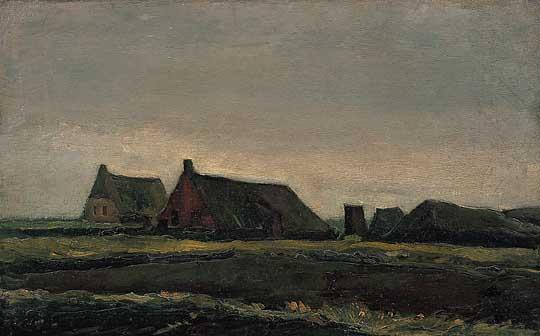
During the Second World War, Hoogeveen became a stronghold of resistance to the occupying German Nazi forces. After the war, Hoogeveen became one of the fastest growing areas in the Netherlands. In the 1960s, the city fathers filled in most of the canals and have worked to make the area into an area for tourist.
Today, a number of well-known buildings in Hoogeveen exist that are worth seeing if you should visit the city. These buildings are the Great Church (construction started in 1651 and was mostly completed in 1664), the Jewish cemeteries of Echtenstraat (founded in 1725) and the Zuiderweg (founded 1829), the
3 http://www.makelaarsoffice.nl/makelaar_hoogeveen.htm
14 | Page
Huts in Zwartschaap, on the way between Hoogeveen and Pesse, painted by Van Gogh in 1883 (Public Domain)
Hall Hoogeveen, the mill known as ‘The Swallow’, the Vincent van Gogh House stayed here a few weeks (1883), the Synagogue at Schutstraat, the Union Baptist church at Schutse and the Remonstrant Church
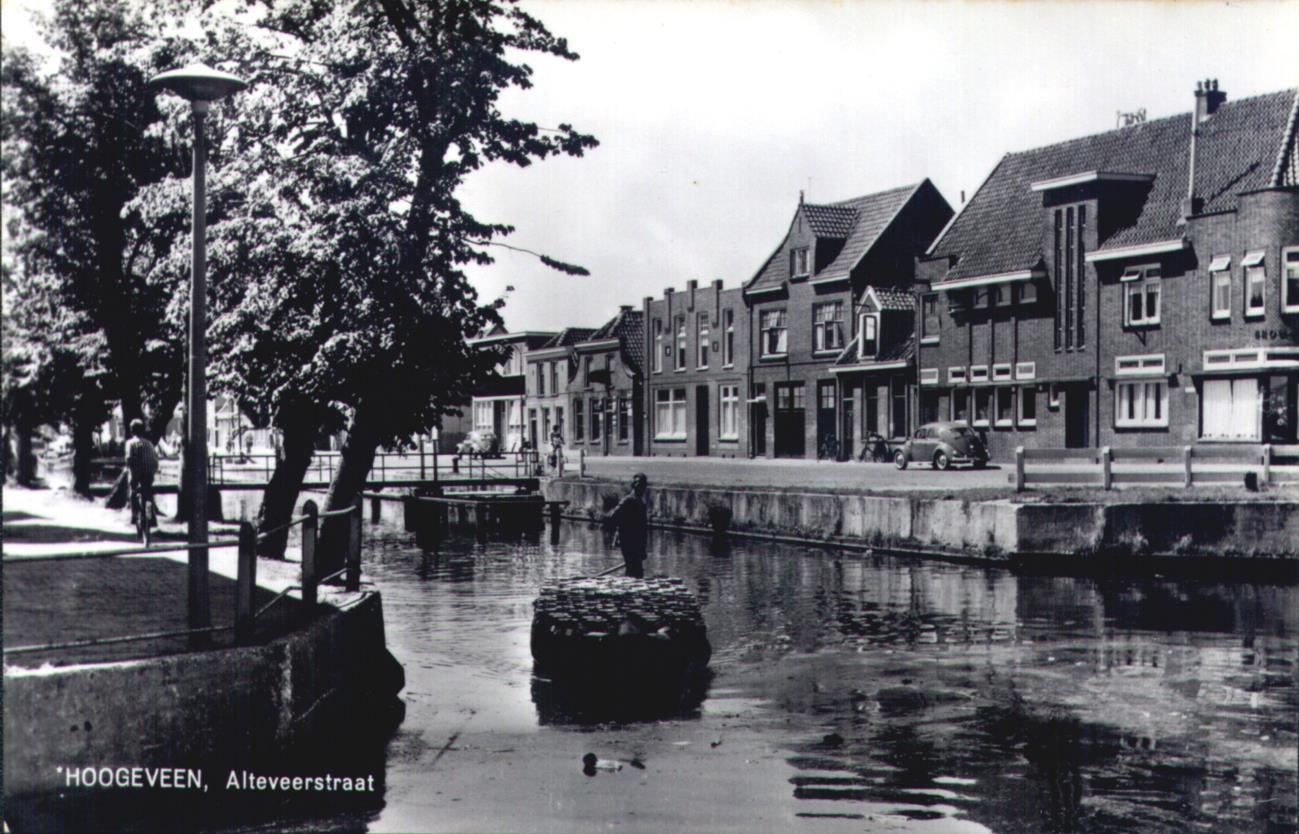
15 | Page
Hoogeveen before World War II (Public Domain)


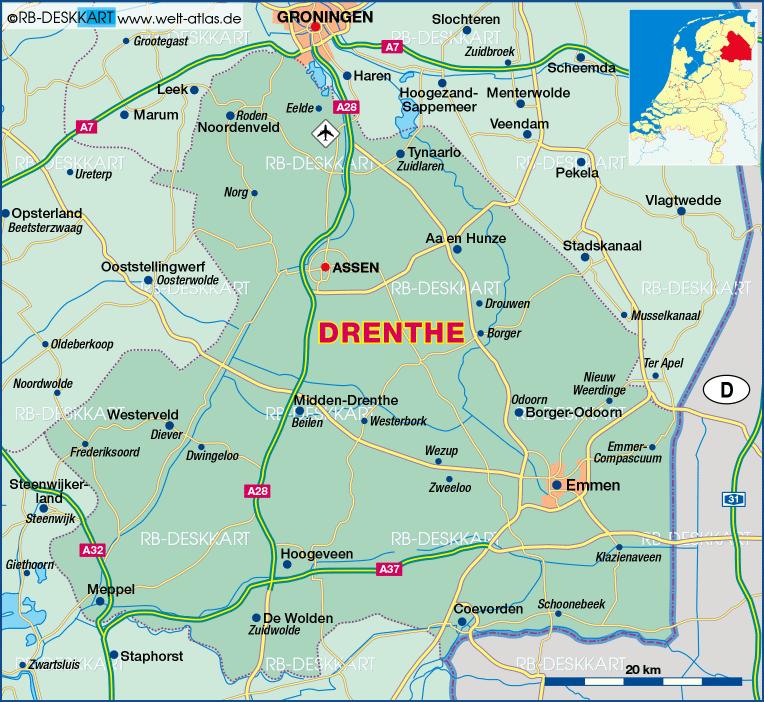
16 | Page
Hoogeveen today. (Photo courtesy of Wikimedia)
(Map courtesy of Familypedia)
(Map courtesy of Welt-Atlas Atlas of the World)
The First Smit Generation Recorded – Our Family (noted
in red)
1615 A.D. – 1776 A.D.
Who really knows where the first family with the Smit name originated from? If you are Dutch, you believe it was first found in the Netherlands. However, the Germans and Prussians also lay claim to the name. It is difficult to trace the family name because there are many variations of the spelling of the name such as Smitt, Smitte, Smites, Smitts, Smiit, Smitts, van Smit, Smut, Smutts, van Smutts, Schmit, Schmidt, van Schmidt and many more. 4 This book traces the Smit family using standard name with the spelling of ‘Smit’.
The first recorded Dutch use of the name ‘Smit’ was in Utrecht, a city and province in the Netherlands. The first recorded use of the name ‘Smit’ in the United States was on November 29, 1641 when Lucas Smit landed in New Amsterdam (New York), NY from Jehansberg, East Prussia. 5 However, the family line we are concerned with does not come from this Smit from Prussia, but rather the ‘Smit’ name from the Netherlands.
Smit Coat of Arms
The beginning of the Smit family written about in this book has its start with a man by the name of Jans Everts Smit. Little is known about him. He lived in the city of Hoogeveen and was recorded to have been born around the year 1615. We know he was a blacksmith by trade and that he married a woman by the name of Trijntje, but her last name is unknown as are the name of Evert’s parents. We do know that Evert and Trijntje had three children.
4 http://www.houseofnames.com/smit-family-crest/Dutch
5 http://tinyurl.com/n3amh5s

17 | Page
Chapter 2
The Smit family tree that connects to the Smits who lived initially in the USA in Kalamazoo, Michigan Birnamwood, Wisconsin. This family today connects to the wider Smit family spread around the world and also the families that married into it. They are the Mejeurs, Meyers, Micheals, Posts and a host of many other family names.
A simple key will help readers understand the recorded family tree: (a.) = approximate, B. = Date of Birth, BT. = Baptism, BU. = Burial Date and Place, D. = Death, F. = Female (if unclear by the name), H. = Place of either Birth or Death, M. = Male (If unclear by the name), and M.N. = Maiden Name.
The Smit family being traced in this book comes through the Evert Jans Smit line recorded through the book in red font.
18 | Page
Evert Jans Smit
Evert Jans Smit
B. 1615 (a) H. Hoogeveen, Drenthe, Netherlands
D. 1704 (a) H. Unknown
BU. Unknown
Evert was a blacksmith by profession.6 His father possibly could have been Jan Jansen Smit, born around 1590.
Married: Trijntje (maiden name is unknown). Date (a. 1640) and location of the marriage is unknown.
Trijntje (M.N. Unknown)
B. 1610 (a.) H. IJhorst, Staphorst, Overijssel, Netherlands
D. 1684 (a ) H. Unknown
BU. Unknown
Evert and Trijntje had three children (a son Jans Everts, a daughter Femmetjen Everts and another son Lubbert Everts).
The Smit family being traced in this book comes through the Jans Everts Smit line.
Children of Evert Jans and Trijnte Smit:
1. Jan Everts
B. 1640 (a.) H. Staphorst, Overijssel, Netherlands
D. 1690 (a.) H. De Wijk, Drenthe, Netherlands
BU. Unknown
Jans was a blacksmith by profession.7
6 http://www.genealogieonline.nl/stamboom-vries/kwartierstaat/I7642/20140126.pdf
7 http://www.genealogieonline.nl/stamboom-vries/kwartierstaat/I7642/20140126.pdf
19 | Page
Married: Grietje (M.D. Reynts) on October 28, 1666 in IJhorst, Overijssel, Netherlands
Grietje (M.N. Roeleffs)
B. 1640 (a.) H. Hoogeveen, Drenthe, Netherlands
D. Unknown H. Unknown
BU. Unknown
Greintje’s parents were Reijnt Roeleffs (B. 1620 – D. 1670) (M.) and Aeltjen Jans (B. 1620 – D. 1680) (F.)
Jan Everts and Grietje had five children (one daughter Trijntje Jans (F.) and four sons – Jans Reijnt (M.), Roeleffs (M.), Jans (M.), Evert Jans (M.) and Jan Jans (M.)).
The Smit family being traced in this book comes through the Jans Reijnt Smit line.
Children of Jan Everts and Grietje Smit:
1. Trijntje Jans (F)
B. October 13, 1667 H. De Wijk, Drenthe, Netherlands
D. Unknown H. Unknown
BU. Unknown
2. Jans Reijnt (M)
B. 1668 (a.) H. De Wijk, Drenthe, Netherlands
D. January 1760 (a.) H. De Wijk, Drenthe, Netherlands
BU January 18, 1760 in Hoogeveen, Drenthe, Netherlands
Married: Geessien Jans (M.N. Pieters) in December 1693 in Hoogeveen, Drenthe, Netherlands.
20 | Page
Geessien (Geesje) Jans (M. N. Pieters)
B. 1665 (a ) H. Hoogeveen, Drenthe, Netherlands
D. October 1752 (a.) H. Hoogeveen, Drenthe, Netherlands
BU. October 12, 1752 in Hoogeveen, Drenthe, Netherlands
Jans Reijnt and Geesje had six children (three sons – Jan Reints (M.), Pieter Reints (M.), Jan Reints (M.) and three daughters Aaltien Reints (F.), Grietje (F.), Aattien Reints (F.)
Children of Jans Reijnt and Geesje Smit:
1. Jan Reijnt (M.)
B. 1695 (a ) H. Unknown
D. 1756 (a.) H. Unknown
BU. Unknown
Married: Annechin Aalderts (M.N. Bloemberg). Date and location of the marriage is unknown.
2. Pieter Reijnt (M.)
B. 1700(a.) H. Unknown
D. Unknown H. Unknown
BU. Unknown
Married: Klaassien (M.N. Lensen) (F). Date and location of the marriage is unknown.
3. Greitje Reijnt (F.)
B. November 1705 (a ) H. Unknown
D. Unknown H. Unknown
BU. Unknown
21 | Page
The Smit family being traced in this book comes through the Aaltien Reijnts Smit line.
Married: Pieter Fass (M.). Date and location of the marriage is unknown.
4. Aaltien Reijnt (F)
B. 1700 (a.) H. Unknown
D. May 1788 H. Unknown
BU. May 29, 1788 in Hoogeveen, Drenthe, Netherlands
Married: to Geert Klaas Seepen in 1723.
It is unsure exactly how Aaltien Smit being a female, retained the Smit family name after being married. It is believed that because the name ‘Geert’ was noted in various places as being ‘poor’, it may be likely that the ‘Smit’ family name was retained to help provide economically for the family needs.
Geert Klaas Seepen
B. 1700 (a ) H. Unknown
D. July 29, 1786 H. Hoogeveen, Drenthe, Netherlands
BU. Unknown
Geert was baptized on April 8, 1742 in Hoogeveen, Drenthe, Netherlands.
They had two children. The Smit family being traced in this book comes through the Evert Smit line.
Children of Geert and Aaltien’s Smit’s (Seepen):
1. Pieter (M.) Smit
B. 1737
H. Hoogeveen, Drenthe, Netherlands
D. 1786 H. Hoogeveen, Drenthe, Netherlands
BU. Unknown
He was baptized on October 14, 1737 in Hoogeveen, Drenthe, Netherlands.
22 | Page
2. Evert (M.) Smit
B. April 8, 1742 H. Hoogeveen, Drenthe, Netherlands
D. July 29, 1786 H. Hoogeveen, Drenthe, Netherlands
BU. Unknown
Married: Annigie Albert (M.N. Vos). Date and location of the marriage is unknown.
Annigie Albert (M.N. Vos) (F.)
B. 1742 (a.) H. Unknown
D. 1786 (a.) H. Unknown
BU. Unknown
The Smit family being traced in this book comes through the Pieter Everts Smit line.
Children of Evert and Annigie Smit:
1. Pieter Everts Smit (M.)
B. August 9, 1776 H. Buiksloot, North Holland, Netherlands
D. 1812 (a.) H. Harlingen, Friesland, Netherlands
BU. Unknown
Married: Geesje Jans (M.N. de Graff) on May 3, 1807 in Hoogeveen, Drenthe, Netherlands.
Geesje Jans (de Graff) (F)
B. September 7, 1783 H. Hoogeveen, Drenthe, Netherlands
D. January 14, 1859 H. Hoogeveen, Drenthe, Netherlands
BU. Unknown
23 | Page
5. Annigien Reijnt (F)
B. May 1708 (a ) H. Unknown
D. September 10, 1779 H. Unknown
BU. Unknown
Married: Jan Seijnen (M). Date and location of the marriage is unknown.
6. Evert (M.)
B. April 26, 1711 H. Unknown
D. Unknown H. Unknown
BU. Unknown
3. Roelof Jan (M.)
B. August 8, 1675 H. De Wijk, Drenthe, Netherlands
D. Unknown H. Unknown
BU. Unknown
4. Evert Jan (M.)
B. August 15, 1680 H. Hoogeveen, Drenthe, Netherlands
D. Unknown H. Unknown
BU. Unknown
Married: Aaltien Willems (B. Unknown – D. 1737 (a) (M.N. ten Kleij) Date and location of the marriage is unknown.
Aaltien (F.) (M.N. Willems)
B. Unknown H. Unknown
D. Unknown H. Unknown
BU. Unknown
They had two children (Two sons – Herman Everts (M.) (B. Unknown – D. Unknown), Willem Everts (M.) (B. Unknown – D. Unknown)
24 | Page
5. Jans Jan (M.)
B. November 2, 1682 H. Hoogeveen, Drenthe, Netherlands
D. November 2, 1762 H. Hoogeveen, Drenthe, Netherlands
BU. Unknown
Married: Femmigie Gosen. Date and location of the marriage is unknown.
Femmigie (M.N. Gosen)
B. 1690 H. Hoogeveen, Drenthe, Netherlands
D. September 1737 (a.) H. Hoogeveen, Drenthe, Netherlands
BU. Unknown
They had four children (Three sons - Grietien (M.) (B. 1712 (a.) – D. Unknown), Jantien (M.) (B. 1714 (a.) – D. Unknown), Aaltien Jans (M.) (B. 1722 (a.) – D. Unknown) and one daughter (Grietje Jans Troost (F.) (B. 1716 (a.) – D. 1794 (a.) – Married: Berend Roelofs Hutte).
2. Femmetjen Everts (F.)
B. 1640 (a.) H. Staphorst, Overijssel, Netherlands
D. 1690 (a.) H. De Wijk, Drenthe, Netherlands
BU. Unknown
Married: Klass Willems (M.) on January 22, 1665 in IJhorst, De Wijk, Drenthe, Netherlands
Klass Willems
B. Unknown H. Unknown
D. Unknown H. Unknown
BU. Unknown
They had seven children (Three sons – Jan Klass (M.) (B. 1666 (a.) – D. Unknown), Evert Klaas (M.)
(B. 1669 (a.) – D. Unknown), Willem Klass (M.) (B. 1669 (a.) – D. Unknown) and four daughters
25 | Page
(Hilligie Klass (F.) (B. 1685 (a.) – D. Unknown), Trijntje Klass (F.) (B. 1672 (a.) – D. Unknown), Jentjen
Klass (F.) (B. 1674 (a.) – D. Unknown), Trijntje Klass (F.) (B. 1677 (a.) – D. Unknown)
3. Lambert Evert
B. 1660 (a.) H. Staphorst, Overijssel, Netherlands
D. 1730 (a.) H. De Wijk, Drenthe, Netherlands
BU. Unknown
Married: Aaltje Jans (M.N. Bosch) on July 1, 1674.
Aaltje Jans (M.N. Bosch)
B. 1650 (a.) H Unknown
D. 1730 (a.) H. Unknown
BU. Unknown
26 | Page
Chapter 3
The Smit Family Tree – The Pieter Everts
Smit Family
1776 A.D. – 1859 A.D.
Not much is known our descendent, Pieter Everts Smit. We only know that God placed Pieter in the town of Buiksloot in the province that was called North Holland, Netherlands. It was the area where the people speaking the Frisian language lived and where people referred to themselves as Hollanders.
Geesje was born into a family called De Graffs who were placed there by the Lord in the town of Hoogeveen in the province of Drenthe of the Netherlands where people spoke the Drèents dialect.
The year of Pieter’s birth was significant for people from the United States because this was the year that the colonies formally declared its independence from British rule.
Pieter Everts Smit (Seepen)
B. August 9, 1776
D. 1812 (a.)
BU. Unknown
H. Buiksloot, North Holland, Netherlands
H. Harlingen, Friesland, Netherlands
Married: Geesje Jan (M.N. de Graff) on May 3, 1807 in Hoogeveen
27 | Page
Geesje Jans (de Graff)
B. September 7, 1783 H. Hoogeveen, Drenthe, Netherlands
D. January 14, 1859 H. Krakeel, Hoogeveen, Drenthe, Netherlands
BU. Unknown
Geesje was the granddaughter of daughter of Paulus de Graaf (B. 1695 D. Unknown) and his wife Catharina (B. 1695 – D. Unknown). Paulus and Catharina had several children.
One of Paulus and Catharina de Graff’s Children:
The purpose of pointing out this one child, Geesje, of Paulus and Catharina at this time is because this family shows up in the story of a later generation of Smits (Albert and Jentje Smit) and their immigration from the Netherlands to South Africa as noted below.
One of Paulus and Catharina’s children was Koeret Jurgen (B. 1720 in Hoogeveen, Drenthe, Netherlands – D. September 23, 1788 in Hoogeveen, Drenthe, Netherlands). He was married to Geesje Jan Smit (B. July 28, 1726, Hoogeveen, Drenthe, Netherlands – D. December 11, 1809 in Hoogeveen, Drenthe, Netherlands).
Koert and Geesje had a number of children among whom was Jan Koert who married Annechin Gerrits Huisjes (B. February 15, 1756 in Hoogeveen, Drenthe, Netherlands – D. June 12, 1828). They were married on January 27, 1781 in Meppel, Drenthe, Netherlands. They had five children noted below:
1. Geesje Jans – (F.) (Married Pieter Everts Smit)
B. September 7, 1783 H. Hoogeveen, Drenthe, Netherlands
D. January 14, 1859 H. Krakeel, Hoogeveen, Drenthe, Netherlands
BU.
2. Gerrit Jans (M.)
B. September 3, 1786 H. Hoogeveen, Drenthe, Netherlands
D. November 27, 1864 H. Hollandschveld, Drenthe, Netherlands
BU. Unknown
28 | Page
3. Egbertje Jans – (F.)
B. October 18, 1789 H. Hoogeveen, Drenthe, Netherlands
D. October 7, 1865 H. Hoogeveen, Drenthe, Netherlands
BU. Unknown
4. Aaltjen Jans – (F.)
B. May 27, 1792 H. Hoogeveen, Drenthe, Netherlands
D. May 11, 1831 H. Hoogeveen, Drenthe, Netherlands
BU. Unknown
5. Koert Jans (M.)
B. January 30, 1796 H. Hoogeveen, Drenthe, Netherlands
D. May 28, 1856 H. Hoogeveen, Drenthe, Netherlands
BU. Unknown Children of Pieter and Geesje Smit:
1. Geesje Pieters (F.)
B. 1796 (a.) H. Unknown
D. Unknown H. Unknown
BU. Unknown
Married: Jacob Koert Timmerman in 1815
Jacob Koert Timmerman (M.)
B. 1788 (a.)
H. Unknown
D. Unknown H. Unknown
BU. Unknown
They had 6 children: Pieters Jacobs (M.), Roelof Jacobs, Hendrik Koerts, Margien Koeerts, Henrdik Koewrts, Margie Koerts (F.))
29 | Page
B. November 11, 1807 H. Hoogeveen, Drenthe, Netherlands
D. September 29, 1895 H. Hoogeveen, Drenthe, Netherlands
BU. Unknown
Married: Susje (M.N. Blokzijl) on November 16, 1828 in Hoogeveen, Drenthe, Netherlands.
Susje [Susie or Susse] (Blokzijl, Blokzijl or Blakzye)
B. October 15, 1806 H. Hoogeveen, Drenthe, Netherlands
D. December 3, 1880 H. Hoogeveen, Drenthe, Netherlands
BU.
Children of Jans and Susje to be detailed in the next chapter.
B. November 24, 1809 H. Hoogeveen, Drenthe, Netherlands
D. July 8, 1883 H. Hoogeveen, Drenthe, Netherlands
BU. Unknown
B. April 12, 1812 H. Hoogeveen, Drenthe, Netherlands
D. April 26, 1874 H. Hoogeveen, Drenthe, Netherlands
BU. Unknown
Married: Aaltje (M.N. Gruppen) on December 24, 1858.
Wife: Aaltje (M.N. Gruppen)
B. June 11, 1834 H. Hoogeveen, Drenthe, Netherlands
D. July 14, 1886 H. Hoogeveen, Drenthe, Netherlands
BU. Unknown
30 | Page
2. Jans Pieter (M.)
3. Anna Pieters
4. Pieter
Children of Pieter and Aaltje Smit
1. Jacob
B. June 24, 1859 H. Hoogeveen, Drenthe, Netherlands
D. December 22, 1861 H. Hoogeveen, Drenthe, Netherlands
BU. Unknown
2. Jan (M.)
B. March 6, 1861 H. Hoogeveen, Drenthe, Netherlands
D. April 5, 1865 H. Hoogeveen, Drenthe, Netherlands
BU. Unknown
3. Margie (F.)
B. October 31, 1862 H. Hoogeveen, Drenthe, Netherlands
D. Unknown H. Unknown
BU. Unknown
4. Aaltje (F.)
B. February 12, 1865 H. Hoogeveen, Drenthe, Netherlands
D. April 10, 1865 H. Hoogeveen, Drenthe, Netherlands
BU. Unknown
5. Jan (M.)
B. February 12, 1865 H. Hoogeveen, Drenthe, Netherlands
D. Unknown H. Unknown
BU. Unknown
6. Aaltje (F.)
B. June 22, 1866 H. Hoogeveen, Drenthe, Netherlands
D. July 7, 1866 H. Hoogeveen, Drenthe, Netherlands
BU. Unknown
31 | Page
7. Jan (M.)
B. September 25, 1867 H. Hoogeveen, Drenthe, Netherlands
D. Unknown H. Unknown
BU. Unknown
8. Aaltje (F.)
B. September 25, 1867 H. Hoogeveen, Drenthe, Netherlands
D. August 1, 1867 H. Hoogeveen, Drenthe, Netherlands
BU. Unknown
9. Jan (M.)
B. February 18, 1870 H. Hoogeveen, Drenthe, Netherlands
D. Unknown H. Unknown
BU. Unknown
10. Petronella (F.)
B. May 15, 1893 H. Hoogeveen, Drenthe, Netherlands
D. Unknown H. Unknown
BU. Unknown
Geesje remarried after Pieter’s death to Albert Jans Veld (B. April 18, 1790 in Hoogeveen, Drenthe, Netherlands – D. June 5, 1876 in Hoogeveen, Drenthe, Netherlands) on January 31, 1818 in Hoogeveen, Drenthe, Netherlands. They had three children:
1. Aaltje Everts (F.)
B. 1772 H. Unknown
D. 1817 H. Unknown
BU Unknown
32 | Page
33 | Page 2. Unknown B. Unknown H. Unknown D. Unknown H. Unknown BU. Unknown 3. Unknown B. Unknown H. Unknown D. Unknown H. Unknown BU. Unknown
Chapter 4
We Begin To Know Our Family
Generation 3
Jans Pieters Smit
B. November 22, 1807 H. Hoogeveen, Drenthe, Netherlands
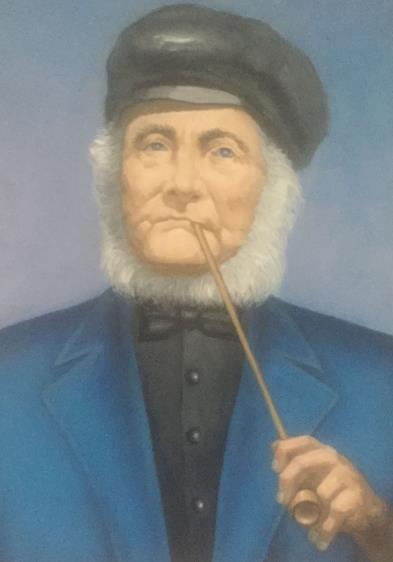
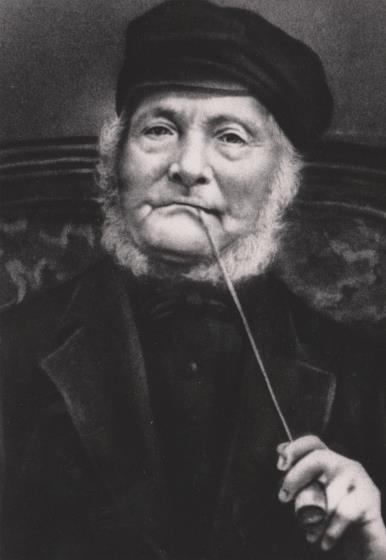
D. September 29, 1895 H. Hoogeveen, Drenthe, Netherlands

BU. Unknown
Father’s Name: Pieter Everts Smit
Mother’s Name: Geesje (Jans de Graaf)
Pieter was a farmer in Hoogeveen and also a boat skipper.
34 | Page
Jans Pieters Smit (Photos courtesy of Charles Micheals) Middle painting hangs in the house of Bob and Donna Mejeur in Kalamazoo, Michigan and was painted by an exchange student living with them. He took great care To ensure the colors in the painting were authentic to that time period for his profession.
Married: Susje (M.N. Blokzljl) on November 16, 1828 in Hoogeveen, Drenthe, Netherlands.
Susje [Susie or Susse] (Blokzijl, Blokzijl or Blakzye)
B. October 15, 1806 H. Hoogeveen, Drenthe, Netherlands
D. December 3, 1880 H. Hoogeveen, Drenthe, Netherlands
BU. Unknown
Susje was baptized on October 15, 1806.
Father’s Name: Jan Jans Blokzijl
Mother’s Name: Lammigje Fredriks (Friezen)
Susje’s family also had a small farm in Hoogeveen. The many women with the name Sue in the larger Smit family can be traced back to this Susje!
Children of Jans Pieters and Susje Smit:
1. Pieter Jans (M.)
B. April 4, 1829
D. November 3, 1898
BU. Unknown
H. Hoogeveen, Drenthe, Netherlands
H. Hoogeveen, Drenthe, Netherlands
Married: Hillegonda (Troost) on March 20, 1852.
Hillegonda (Troost)
B. 1829
D. November 27, 1902
BU. Unknown
H. Hoogeveen, Drenthe, Netherlands
H. Zuidwolde, Drenthe, Netherlands
35 | Page
Children of Pieter Jans and Hillegonda Smit
1. Susje Pieters (F.)
B. October 13, 1852 H. Hoogeveen, Drenthe, Netherlands
D. March 3, 1892 H. Hoogeveen, Drenthe, Netherlands
BU. Unknown
2. Roelofje Pieters (F.)
B. April 23, 1855 H. Hoogeveen, Drenthe, Netherlands
D. Unknown H. Unknown
BU. Unknown
Married: Jans (John) Koster who is noted in the diary of Alice (Smit) Meyer)
Jans (John) Koster
B. Unknown H. Unknown
D. Unknown H. Unknown
BU. Unknown
3. Jan Pieters (M.)
B. October 1, 1858 H. Hoogeveen, Drenthe, Netherlands
D. November 13, 1860 H. Unknown
BU. Unknown
4. Jantje Pieters (F.)
B. October 1, 1861 H. Hoogeveen, Drenthe, Netherlands
D. May 22, 1884 H. Hoogeveen, Drenthe, Netherlands
BU. Unknown
36 | Page
5. Geesje Pieters (F.)
B. June 1, 1864 H. Hoogeveen, Drenthe, Netherlands
D. June 17, 1893 H. Hoogeveen, Drenthe, Netherlands
BU. Unknown
6. Femmigje Pieters (F.)
B. July 19, 1867 H. Hoogeveen, Drenthe, Netherlands
D. August 25, 1878 H. Hoogeveen, Drenthe, Netherlands
BU. Unknown
7. Hillegonda Pieters (F.)
B. January 6, 1871 H. Hoogeveen, Drenthe, Netherlands
D. March 9, 1871 H. Hoogeveen, Drenthe, Netherlands
BU. Unknown
8. Hillegonda Pieters (F.)
B. March 17, 1872 H. Hoogeveen, Drenthe, Netherlands
D. Unknown H. Unknown
BU. Unknown
9. Jan Pieters (M.)
B. March 26, 1875 H. Hoogeveen, Drenthe, Netherlands
D. February 22, 1878 H. Hoogeveen, Drenthe, Netherlands
BU. Unknown
10. Jan Pieters (M.)
B. May 4, 1879 H. Hoogeveen, Drenthe, Netherlands
D. Unknown H. Unknown
BU. Unknown
37 | Page
2. Lammigje (F.)
B. November 11, 1831 H. Hoogeveen, Drenthe, Netherlands
D. May 8, 1832 H. Hoogeveen, Drenthe, Netherlands
BU. Unknown
3. Jan Jans (M.)
B. March 20, 1833 H. Hoogeveen, Drenthe, Netherlands
D. January 1, 1912 H. Altveer, Drenthe, Netherlands
BU. Unknown
Member of the Christian Reformed Church. He was a farmer.
Married: Hendrikje (Botter) on April 29, 1858 in Hoogeveen, Drenthe, Netherlands..
Hendrikje (Botter)
B. January 9, 1834 H. Hoogeveen, Drenthe, Netherlands
D. July 14, 1904 H. Hoogeveen, Drenthe, Netherlands
BU. Unknown
Children of Jan Jans and Hendrikje Smit
1. Susje Jans (Susje) (F.)
B. January 25 1859 H. Hoogeveen, Drenthe, Netherlands
D. November 25, 1890 H. Hoogeveen, Drenthe, Netherlands
BU. Unknown
Married: To Roelof Hartman on February 16, 1884 in Hoogeveen, Drenthe, Netherlands.
2. Roelof (M.)
B. September 11, 1860 H. Hollandscheveld, Drenthe, Netherlands
D. 1863 H. Unknown
BU. Unknown
38 | Page
3. Roelof Jans (M.)
B. January 5, 1863 H. Hollandscheveld, Drenthe, Netherlands
D. 1866 H. Unknown
BU. Unknown
4. Roelof Jans (M.)
B. June 9, 1866 H. Hollandscheveld, Drenthe, Netherlands
D. 1867 H. Unknown
BU. Unknown
5. Roelof Jans (M.)
B. May 2, 1867 H. Hollandscheveld, Drenthe, Netherlands
D. August 8, 1939 H. Unknown
BU. Unknown
6. Aaltje Jans (M.)
B. December 14, 1869 H. Hollandscheveld, Drenthe, Netherlands
D. Unknown H. Unknown
BU. Unknown
Married: To Roelof Strijker on May 1, 1897.
Roelof Strijker
B. Unknown H. Unknown
D. Unknown H. Unknown
BU. Unknown
Married: On April 3, 1920 to Jan Scholing
39 | Page
Jan Scholing
B. Unknown H. Unknown
D. Unknown H. Unknown
BU. Unknown
7. Jantje Jans (F.)
B. March 28, 1872 H. Hollandscheveld, Drenthe, Netherlands
D. Unknown H. Unknown
BU. Unknown
8. Jan (John) Jans Jr. (M.)
B. May 11, 1874 H. Hollandscheveld, Drenthe, Netherlands
D. May 22, 1944 H. Kalamazoo, Michigan
BU. March 28, 1944, Riverside Cemetery – Plot: 200,04
A member of the Christian Reformed Church. He was a farmer.
He immigrated to America on likely in 1902 to Kalamazoo, Michigan and lived for a time with John Smit, son of Albert and Jentje Smit who arrived in the country in 1901
Married: To Harmina or Minnie (M.N. Modderman) on July 27, 1905 in Kalamazoo, Michigan.
Harmina (Minnie) (M.N. Modderman)
B. February 12, 1881 H. Oostwald, Netherlands
D. October 16, 1963 H. Kalamazoo, Michigan
BU. Riverside Cemetery – Plot: 200, 03 – October 19, 1963
40 | Page
Children of John and Minnie Smit
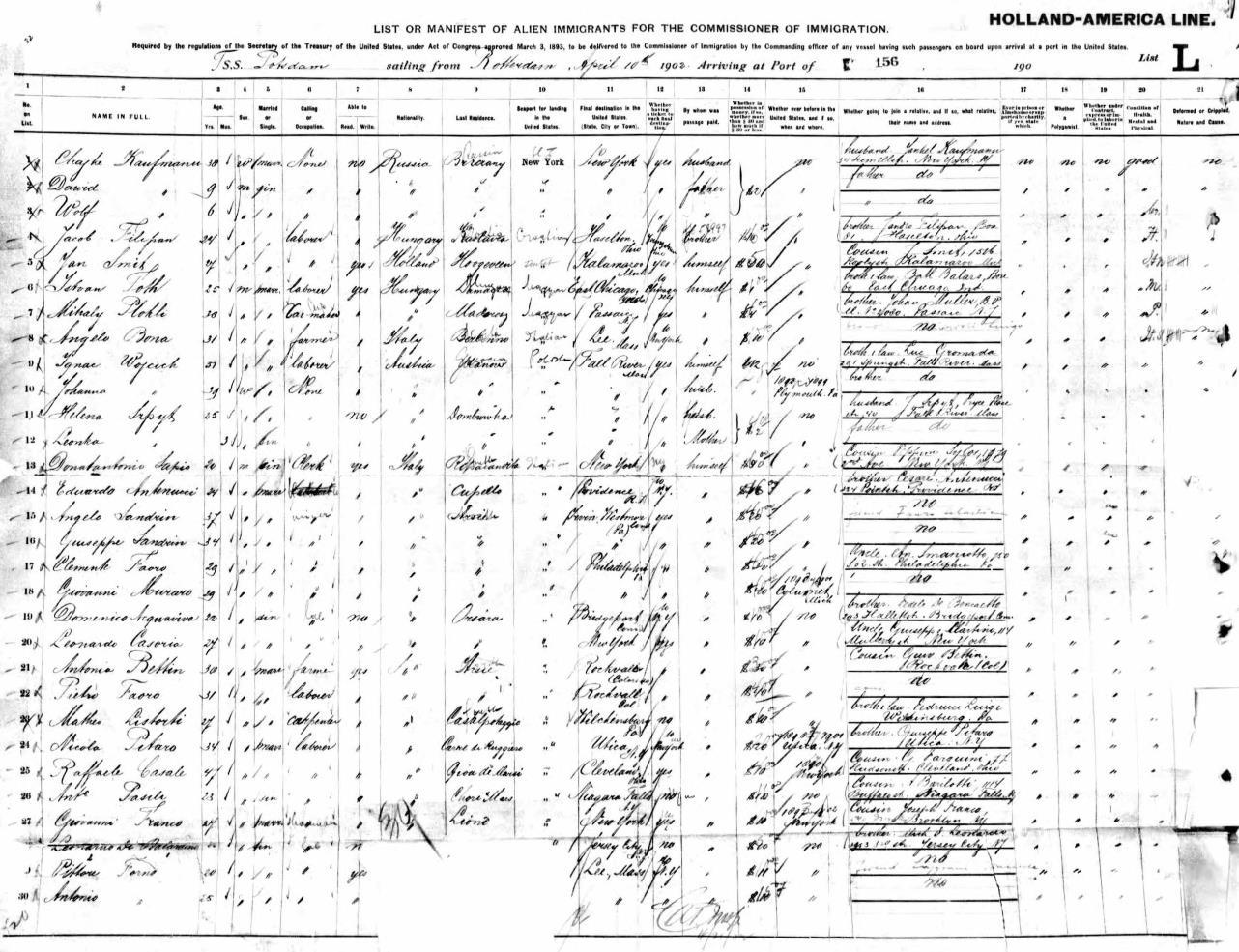
41 | Page
The ship manifest for Jan (John) Jans Smit – Arriving in New York City on August 28, 1902 on the T.S.S Potsdam. (Photo courtesy of Ellis Island)
1. James
B. Unknown H. Unknown
D. Unknown
H. Unknown
BU. Unknown
Married: Jody Collar on ???
Judy (M.N. Collar)
B. Unknown H. Unknown
D. Unknown H. Unknown

BU. Unknown
B. December 20, 1909 H.
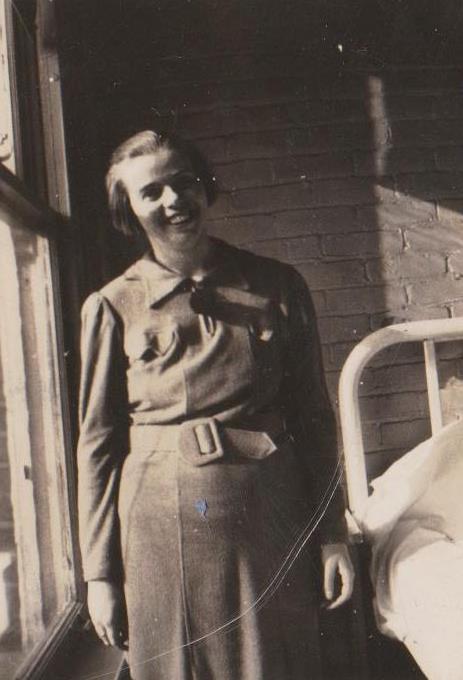
D. January 18, 1969 H. Kalamazoo, Michigan
BU. Riverside Cemetery, Kalamazoo, Michigan
Never married.

42 | Page
2. Effie Smit
Effie Smit (Photo courtesy of Charles Micheals)
(Photo Courtesy of Find A Grave – Deb Britten)
3. John III
B. Unknown H. Unknown
D. Unknown H. Unknown
BU. Unknown
Married: Dena (M.N. Sportel) on February 25, 1935
Dena (M.N. Sportel)
B. 1912 H. Kalamazoo, Michigan
D. Unknown H. Unknown
BU. Unknown
4. Sue (Hoekman)
B. November 17, 1917 H. Kalamazoo, Michigan
D. January 11, 1996 H. Kalamazoo, Michigan
BU. East Cooper Cemetery, Cooper, Michigan
Married: Peter Hoekman on October 4, 1946.
Peter Hoekman
B. Unknown H. Kalamazoo, Michigan
D. Unknown H. Unknown
BU. Unknown
They were members of Second Christian Reformed Church, Kalamazoo, Michigan.
43 | Page
Children of Peter and Sue Hoekman
Children of Dennis and Nancy Althuis
44 | Page
1. Beth Ann B. Unknown H. Unknown D. Unknown H. Unknown BU. Unknown 2. Nancy B. Unknown H. Unknown D. Unknown H. Unknown BU. Unknown Married: Dennis Althuis on Dennis Althuis B. Unknown H. Unknown D. Unknown H. Unknown BU. Unknown
1. Jessica B. Unknown H. Unknown D. Unknown H. Unknown BU. Unknown 2. Justin B. Unknown H. Unknown D. Unknown H. Unknown BU. Unknown
5. Henrietta (Medema)
B. 1906 H. Kalamazoo, Michigan
D. Unknown H. Unknown
BU. Unknown
Married: John Medema on October 16, 1925.
John Medema
B. February 12, 1907 H. Kalamazoo, Michigan
D. November 19, 1963 H. Kalamazoo, Michigan
BU. Portage Central Cemetery, Portage, Michigan
Children of John and Henrietta Medema
1. Janet
B. Unknown H. Unknown
D. Unknown H. Unknown
BU. Unknown
Married 1st Husband John Plooster, 2nd Husband Charles Horton
John Plooster
B. Unknown H. Unknown
D. Unknown
BU. Unknown Charles Horton
B. Unknown
D. Unknown
BU. Unknown
45 | Page
H. Unknown
H. Unknown
H. Unknown
2. Marilyn
B. 1929 H. Unknown
D. Unknown H. Unknown
BU. UnKnown
Married: Clayton Russel on September 19, 1947.
Clayton Russel
B. September 27, 1927 H. Unknown
D. 2013 H. Unknown
BU. Unknown
3. Herman John
B. April 22, 1931 H. Kalamazoo, Michigan
D. November 19, 2010 H. Kalamazoo, Michigan
BU. Mount Ever-Rest Memorial Park – South, Kalamazoo, Michigan
Married: Maya Eunice (M.N. Travis) on April 5, 1958
Attended: Southridge Reformed Church, Kalamazoo, Michigan
Maya Eunice (M.N. Travis)
B. 1925 H. Worksop, England
D. January 2, 2003 H. Kalamazoo, Michigan
BU. Mount Ever-Rest Memorial Park – South, Kalamazoo, Michigan
4. John
B. 1935 H. Unknown
D. December 7, 1953 H. Unknown
BU. Unknown
Married: To Dorothy (M.N. Medema) on ???
46 | Page
Attended: Prairie Edge Christian Reformed Church, Kalamazoo, Michigan
Dorothy (M.N. Medema)
B. December 18, 1935
D. December 14, 2009
BU. Unknown
Unknown
5. Paul
B. 1937
D. Unknown
Married: Irene (M.N. Medema) on
Attended: First Reformed Church, Portage, Michigan
Irene (M.N. Medema)
B. Unknown
47 | Page
H. Unknown
H.
H.
Unknown
H.
Unknown BU. Unknown
H.
H. Unknown
Unknown D. Unknown
BU. Unknown
B.
H. Unknown
H. Unknown BU. Unknown
B. 1942 H. Unknown
Unknown H. Unknown
Unknown
6. Bernard
1939?
D. Unknown
Married: ??? 7. Ken
D.
BU.
Married: Karen (M.N. Vander Roest) on June 23, 1961.
Attended: Prairie Edge Christian Reformed Church, Kalamazoo, Michigan
Karen (M.N. Vander Roest)
B. 1942 H. Unknown
D. Unknown H. Unknown
BU. Unknown
4. Albert
B. January 30, 1836 H. Hoogeveen, Drenthe, Netherlands
D. September 2, 1846 H. Hoogeveen, Drenthe, Netherlands
BU. Unknown
5. Lambertus
B. November 10, 1838 H. Hoogeveen, Drenthe, Netherlands
D. June 12, 1898 H. Hoogeveen, Drenthe, Netherlands
BU. Unknown
Married: Elisabeth (Stoter) on February 28, 1863. Elizabeth was the daughter of Albert and Stoter (Wubbigje) Veldman
6. Koert
B. November 30, 1841 H. Hoogeveen, Drenthe, Netherlands
D. May 9, 1920 H. Pretoria, South Africa
BU. Unknown
Koert was a Peat Farmer. He immigrated to Transvall, South Africa on March 18, 1889. They lived on 81 Visagie Street in Pretoria. They became members of the Gereformeerde Kerk in Pretoria in July 5, 1899. They are mentioned in the diary of Alice Meyer. This was the family that hosted the Albert & Jentje Smit family in Transvaal.
48 | Page
Married: Roelofje (Doldersum) on April 7, 1883 in Hoogeveen, Drenthe, Netherlands. Roielofje was born on August 17, 1855 in Hoogeveen, Drenthe, Netherlands and died (unsure of date) in Pretoria, South Africa.

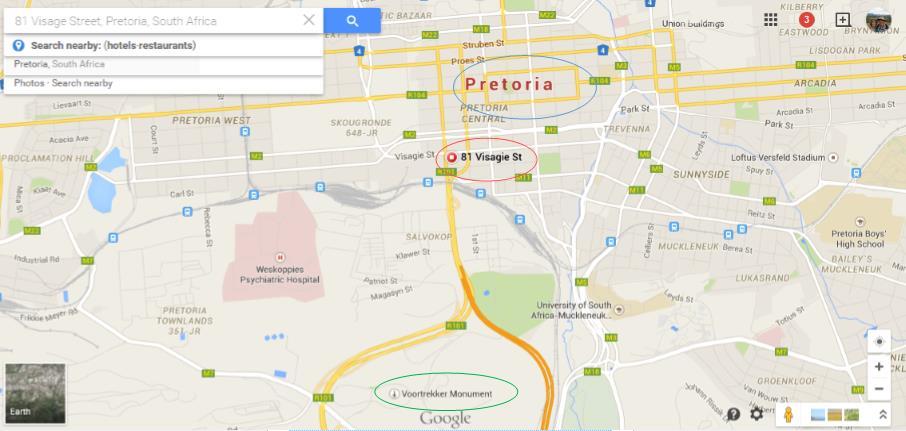
49 | Page
2015 – Blue circle 9 (Church Square), Red Circle (Koert Smit’s Home), Green Circle (Vootrekkers Monument) (Photo courtesy of Google Maps)
2013 - 81 Visagie Street, Pretoria, South Africa (Photo courtesy of Google Earth)
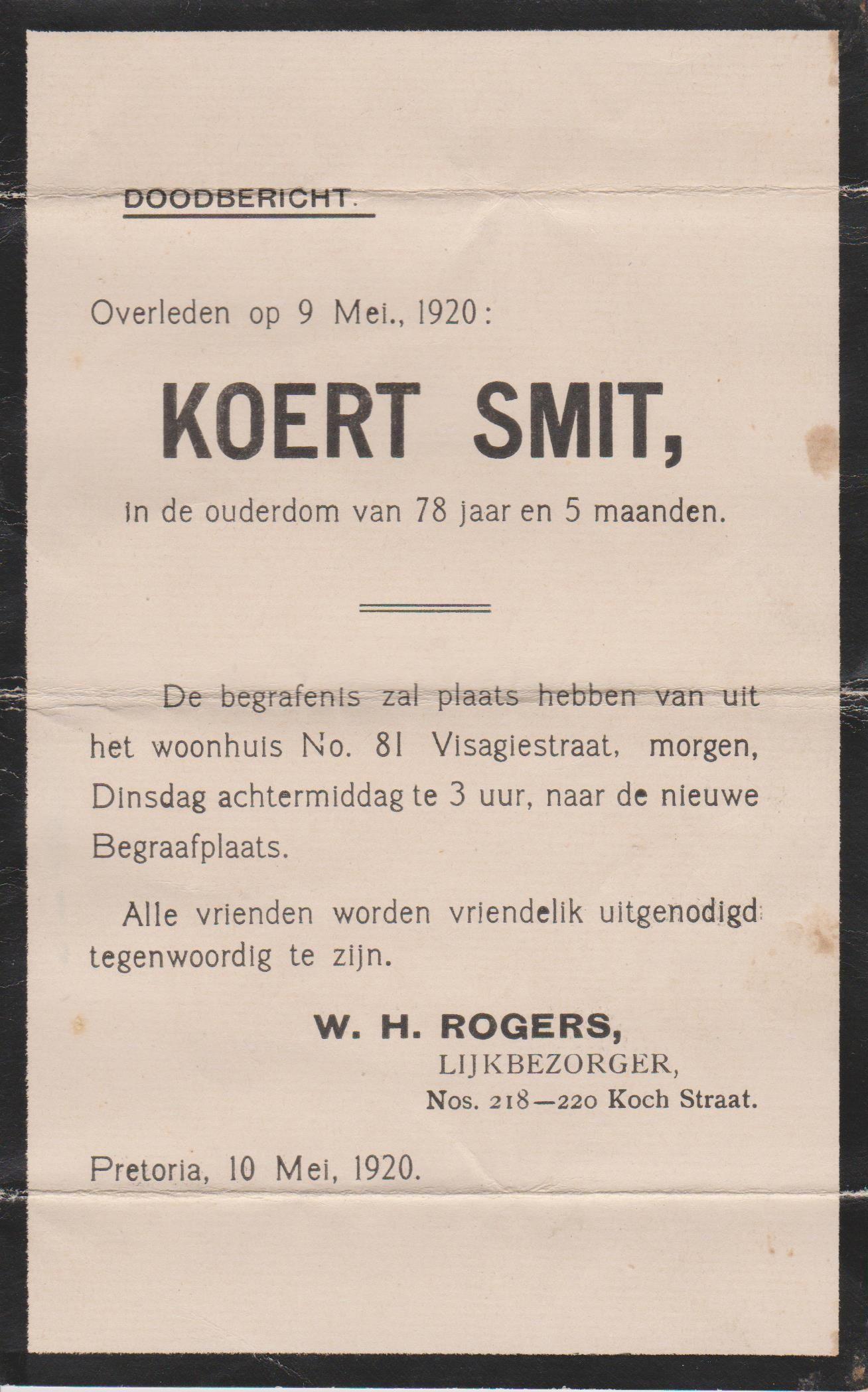
50 | Page
Notice of Koert Smit’s death sent to Albert Smit (Photo courtesy of Charles Micheals)
Children of Koert and Roelofje
1. Jan (John) Koerts (M.)
B. June 3, 1883 H. Hoogeveen, Drenthe, Netherlands
D. Unknown H. Unknown
BU. Unknown
He likely came to America and lived with Albert & Jentje Smit when they lived in their house on Woodward Ave. in Kalamazoo, Michigan.
2. Hendrika Elizabeth (F.)
B. June 24, 1885 H. Hoogeveen, Drenthe, Netherlands
D. Unknown H. Unknown
BU. Unknown
3. Susje (F.)
B. December 17, 1887 H. Hoogeveen, Drenthe, Netherlands
D. Unknown H. Unknown
BU. Unknown
Married: To Bastiaan Pieter Landa on May 31, 1905.
4. Jans (M.)
B. October 29, 1890 H. Pretoria, South Africa
D. Unknown H. Unknown
BU. Unknown
5. Albert (M.)
B. December 26, 1892 H. Pretoria, South Africa
D. Unknown H. Unknown
BU. Unknown
51 | Page
6. August (M.)
B. April 10, 1895 H. Pretoria, South Africa
D. Unknown H. Unknown
BU. Unknown
7. Roelina (Lina) (F.)
B. September 10, 1898 H. Pretoria, South Africa
D. August 8, 1957 H. Grahamstown, Western Cape, South Africa
BU. Unknown
Married: To James Joseph Cooke in 1932.
James Joseph Cooke
B. 1871 H. Ipswich, Suffolk, England
D. 1956 H. Grahamstown, Western Cape, South Africa
BU. Unknown
He was mayor of Pretoria from 1938 to 1939 at the time of the centenary of the Great Trek celebrations which culminated in the South African capital December 16, 1938. During his time as Mayor he presided over the cornerstone laying of the Voortrekker Monument in Pretoria. The monument was a memorial to the Voortrekker pioneers who left the Cape Colony between 1835 and 1854 and headed in the Great Trek to establish the Transvaal Republic
Construction on the memorial began July 13, 1937 on Monument Hill before Mayor Cooke took office. However, while James Cooke was mayor, on December 16, 1938 the cornerstone was laid by three descendants of the Great Trek leaders: Mrs. J.C. Muller (granddaughter of Andries Pretorius, who was instrumental in the founding of Transvaal and who the city of Pretoria is named after), Mrs. K.F. Ackerman (great- granddaughter of Hendrik Potgieter, a major Great Trek leader) and Mrs. J C Preller (great granddaughter of Piet Retief, a major Great Trek leader). The celebration was held in Pretoria with 250,000 people in attendance
52 | Page
It was completed in 1949 at the cost of R720,000 and is a 130 foot high colossal structure of granite which sits 200 feet above the crest of the hill on which it stands. It is 130 foot square. It is roughly four miles from Pretoria on the Johannesburg Road.

The chief architect was Gerard Moerdijk who was the architect of 80 Protestant churches in South Africa. He use the architect of the Reformed church tradition and his Renaissance trademark using as Greek-cross floorplan which focused on the pulpit and preacher. In Reformed theology, the Word of God is central. The monument's huge upper dome features Egyptian backlighting to simulate the sky or the heavenly abode of God. Through the dome a sun ray penetrates downwards, highlighting words on December 16 at noon which was the Day of the Vow
The Day of the Vow had its origin as an annual religious day to commemorate the Battle of Blood River fought on December 16, 1838. On that day the besieged Voortrekkers took a public vow together before the battle in which they pledged that in return for God's help in obtaining victory, they would build a church and forever honor this day as a holy
53 | Page
–
1963
Voortrekkers Monument – Pretoria (Photo courtesy of Hilton T - Flickr)
day of God. During the battle a group of about 470 Voortrekkers defeated a force of about ten thousand Zulu warriors. Only three Voortrekkers were wounded, and some 3,000 Zulu warriors died in the battle.8
In the monument there are 32 symbolic sun rays that can be seen on the inside floor. These sun rays simulate a connection between the words on the Cenotaph and the heavenly abode above, a communication between God and man. On December 16 the sun rays shine directly onto the stone in the midst of the abyss, which publically highlights the creation of a new civilization in Africa. The sky oriented words highlighted in bright sunlight read from the literal translation from Afrikaans, "WE FOR THEE SOUTH-AFRICA". The words are taken from the former national anthem of South Africa, Die Stem van SuidAfrika (The Call of South Africa), which state in Afrikaans “We will live, we will die. We for Thee, South Africa.” The same anthem ends in Afrikaans, "It will be well, God reigns."9
The Call of South Africa
1st Verse
Ringing out from our blue heavens, From our deep seas breaking round, Over everlasting mountains, Where the echoing crags resound, From our plains where creaking wagons, Cut their trails into the earth, Calls the spirit of our country, Of the land that gave us birth. At thy call we shall not falter, Firm and steadfast we shall stand, At thy will to live or perish, O South Africa, dear land.
8 http://en.wikipedia.org/wiki/Day_of_the_Vow
9 http://en.wikipedia.org/wiki/Voortrekker_Monument
54 | Page
2nd Verse
In our body and our spirit, In our inmost heart held fast; In the promise of our future, And the glory of our past; In our will, our work, our striving, From the cradle to the graveThere's no land that shares our loving, And no bond that can enslave. Thou hast borne us and we know thee, May our deeds to all proclaim Our enduring love and service To thy honour and thy name.
3rd Verse
In the golden warmth of summer, In the chill of winter's air, In the surging life of springtime, In the autumn of despair; When the wedding bells are chiming, Or when those we love do depart, Thou dost know us for thy children
And dost take us to thy heart
Loudly peals the answering chorus; We are thine, and we shall stand, Be it life or death, to answer To thy call, beloved land.
4th Verse
In thy power, Almighty, trusting, Did our fathers build of old; Strengthen then, O Lord, their children
55 | Page
To defend, to love, to holdThat the heritage they gave us For our children yet may be; Bondsmen only to the Highest And before the whole world free. As our fathers trusted humbly, Teach us, Lord to trust Thee still; Guard our land and guide our people In Thy way to do Thy will.
B. October 26, 1934 H. Pretoria, South Africa
D. October 29, 1934 H. Pretoria, South Africa
BU. October 29, 1934
B. September 30, 1935 H. Unknown
D. February 5, 1995 H. Unknown
BU: Unknown
B. December 23, 1936 H. Unknown
D. August 8, 2008 H. Unknown
BU. Unknown
B. May 28, 1844 H. Hoogeveen, Drenthe, Netherlands
D. January 31, 1892 H. Hoogeveen, Drenthe, Netherlands
BU. Unknown
56 | Page
Children of James and Roelina Cooke
1. Teresa
2. Michael James Anthony Cooke
3. Helen Theresa Cooke
7. Geesje (F.)
Married: Klaas Botter, brother of Hendrikje (Botter) who married Jan Jans Smit (# 3 above) on May 8, 1869. Second marriage to Lambert Botter on August 24, 1872
8. Susje Jans (F.)
B. September 30, 1847 H. Hoogeveen, Drenthe, Netherlands
D. December 28, 1876 H. Hoogeveen, Drenthe, Netherlands
BU. Unknown
9. Albert Jan
B. September 10, 1851 H. Hoogeveen, Drenthe, Netherlands
D. September 7, 1934 H. Kalamazoo, Michigan
BU. Riverside Cemetery, Kalamazoo, Michigan
He was a member of the Christian Reformed Church. He was a farmer and in one directory noted as a beer bottler, although it is more likely he was a grocer as per Alice Smit’s diary. The family moved on May 11, 1887 to the city of Sleen in the province of Drenthe. They eventually moved to South Africa and then came back to Sleen, but left Sleen on August 13, 1901 when they moved to the city of Erica, Drenthe, Netherlands. The family immigrated to the USA on August 28, 1902 and immigrated to Kalamazoo, Michigan.

More about Albert and his wife are found in the next chapter.
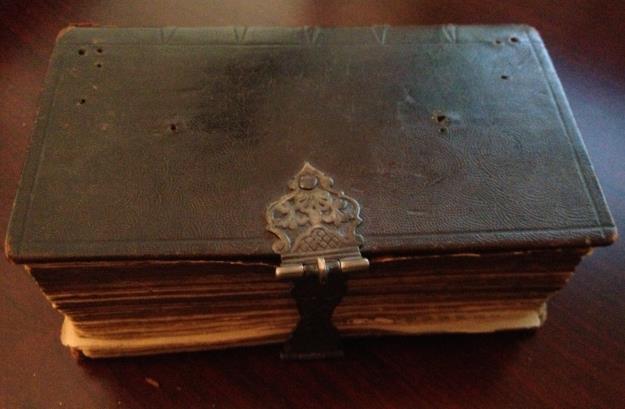
57 | Page
Albert Smit’s Bible- Inscribed with his birth date and the date of the death of his second child Jan Johannes Smit (Photos courtesy of Charles Micheals)
Chapter 5
– The Third Generation
The Family Moves To South Africa
Albert Jan Smit
B. September 10, 1851 H. Hoogeveen, Drenthe, Netherlands
D. September 7, 1934 H. Kalamazoo, Michigan
BU. September 10, 1934 - Riverside Cemetery, Kalamazoo, Michigan. (Lot: KK, 078, 02)
Albert became a USA Citizen on May 5, 1908.
Married: To Jentje Jans (M.N. Koster) April 27, 1878 in Hoogeveen, Drenthe, Netherlands They were married in a double wedding with Jans (John) Jan Koster (Jentje’s older brother) and Roelofje Pieters (M.N. Smit)
Jentje - Jennie (Koster)
B. November 1, 1856 H. Hoogeveen, Drenthe, Netherlands
D. July 4, 1919 H. Kalamazoo, Michigan
BU. July 9, 1919, Riverside Cemetery, Kalamazoo, Michigan (Lot: KK, 078, 05)
58 | Page
Jentje’s Parents
Father
Jan (John) Geerts Koster (Son of farmer Geerts Jans (John) Koster and Hilligje Willems Scheeper.)
B. October 13, 1811 H. Zuidwolde, Drenthe, Netherlands
D. June 19, 1878 H. Hoogeveen, Drenthe, Netherlands
BU. Unknown
Jan owned a ship in the Netherlands.
Married: To Aaltje (Prins) on March 2, 1839 in Hoogeveen, Drenthe, Netherlands
Mother
Aaltje (Prins)
B. February 11, 1816 H. Hoogeveen, Drenthe, Netherlands
B. December 8, 183810 H. Hoogeveen, Drenthe, Netherlands
D. January 3, 1898 H. Hoogeveen, Drenthe, Netherlands
D. April 19, 189811 H. Hoogeveen, Drenthe, Netherlands
BU. Unknown 10 https://www.genealogieonline.nl/en/stamboom_klavers/I29267.php
59 | Page
11 Ibid.
five children. Grietje Prins, Hendrik Prins (m) , Jantje Prins, Jan
and Aaltje Prins. It is likely that one of these two Prins boy’s children or grandchildren came to America and Mr. Prins came to live with them. (Photo Courtesy of Janis Clapp Vehanen)
Children of Jans Geerts and Aaltje Koster:
1. Helen (Hilligje)
B. December 8, 1839 H. Hoogeveen, Drenthe, Netherlands
D. April 19, 1895 H. Hoogeveen, Drenthe, Netherlands
BU. Unknown
Married: Aaldert Streutker on March 9, 1871 (Possibly September 3, 1872) in Hoogeveen, Drenthe, Netherlands. Aaldert had married a Jentje Pols in 1868, but she died. Aaltje the

60 | Page
Kalamazoo, Michigan (L-R) Minnie (Moderman) Smit, Susie Smit, Albert and Jentje (Koster) Smit, Mr Prins (from the Netherlands) and his daughter Mrs De Kraker, Alice, Helen & Albert Smit The Prins noted here is the Prins related to Jentje Smit. Jentje's father was Jan Geerts Koster and her mother was Aaltje Prins. Aaltje's (Prins) Koster parents were Gerrit Prins and Jantien (Kroes). Gerrit and Jantien had
Prins (m)
Koster lived with them after her husband John Koster died. Aaltje died in this home in 1898.
Aaldert Streutker
B. 1839 H. Hoogeveen, Drenthe, Netherlands
D. 1933 H. Hoogeveen, Drenthe, Netherlands
BU. Unknown
They had a maid by the name of Femmigie Stoefzand. After Jentje Smit and the children returned from Africa, they stayed with Aaldert until Jentje Smit delivered her daughter Helen in the bed of her mother in Aaldert’s home. The children slept in beds made of hay which was in a room attached to the cattle shed.
Children Of Aaldert and Helen Streutker
1. Aaltje (Alice)
B. 1873 H. Hoogeveen, Drenthe, Netherlands
D. Unknown H. Unknown
BU. Unknown
Married: Albert Koster
Albert Koster
B. 1873 H. Unknown
D. Unknown H. Unknown
BU. Unknown
Albert was a skipper.
61 | Page
Children Of Albert and Alice Koster
1. Jantje (Jennie)
B. May 29, 1896 H. Hoogeveen, Drenthe, Netherlands
D. Unknown H. Unknown
BU. Unknown
B. 1897 H. Hoogeveen, Drenthe, Netherlands
D. Unknown H. Unknown
BU. Unknown
B. 1899 H. Hoogeveen, Drenthe, Netherlands
D. 1890 H. Unknown
BU. Unknown
4. Unknown
B. Unknown H. Hoogeveen, Drenthe, Netherlands
D. Unknown H. Unknown
BU. Unknown
B. 1875 H. Unknown
D. 1917 H. Unknown
BU. Unknown
B. February 10, 1843 H. Hoogeveen, Drenthe, Netherlands
D. September 12, 1929 H. Emmen, Drenthe, Netherlands
BU. Unknown
Owned a ship and lived on the boat.
62 | Page
2. Hilligje (Helen)
3. Hermanna Roelofje (F)
2. Magcheltje
2. Gerrit
Married: To Johanna Hendrika (M.N. Kamperman) on ???
Johanna (M.N. Kamperman)
B. 1847 H. Unknown
D. 1919 H. Unknown
BU. Unknown
Children of Gerrit and Johanna Koster
1. Jan (John) (M.)
B. 1870 H. Unknown
D. 1938 H. Unknown
BU. Unknown
2. Willem (M.)
B. 1872 H. Unknown
D. Unknown H. Unknown
BU. Unknown
3. Aaltje (Alice) (F.)
B. 1875 H. Unknown
D. Unknown H. Unknown
BU. Unknown
4. Geert (M.)
B. 1877 H. Unknown
D. Unknown H. Unknown
BU. Unknown
63 | Page
5. Gezina (F.)
B. 1879 H. Unknown
D. 1881 H. Unknown
BU. Unknown
6. Dirk (M.)
B. 1882 H. Unknown
D. Unknown H. Unknown
BU. Unknown
7. Garrit (M.)
B. 1884 H. Unknown
D. Unknown H. Unknown
BU. Unknown
3. Geert Jan (M.)
B. June 21, 1846 H, Hoogeveen, Drenthe, Netherlands
D. April 9, 1934 H. Hoogeveen, Drenthe, Netherlands
BU. Unknown
He was a boat skipper.
Married: Petronela Gerrit Scholten
Petronella Gerrit (M.N. Scholten) (F.)
B. July 27, 1852 H. Hoogeveen, Drenthe, Netherlands
D. January 13, 1920 H. Hoogeveen, Drenthe, Netherlands
BU. January 17, 1920
Had fifteen children (Jan, Johanna, Johanna, Aaltje, Jan, Gerrit, Aaltje, Johanna, Jantine, Garrit, Jan, Geert, Petronella, Geert, Unknown)
64 | Page
4. Jan (John) Jans (M.)
B. April 2, 1853
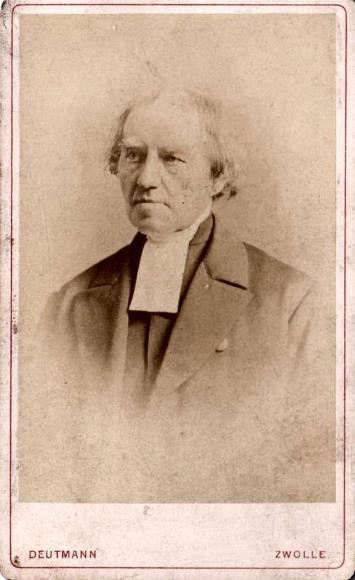

D. Unknown
BU. Unknown
He had a ship.
H Hoogeveen, Drenthe, Netherlands
H. Unknown
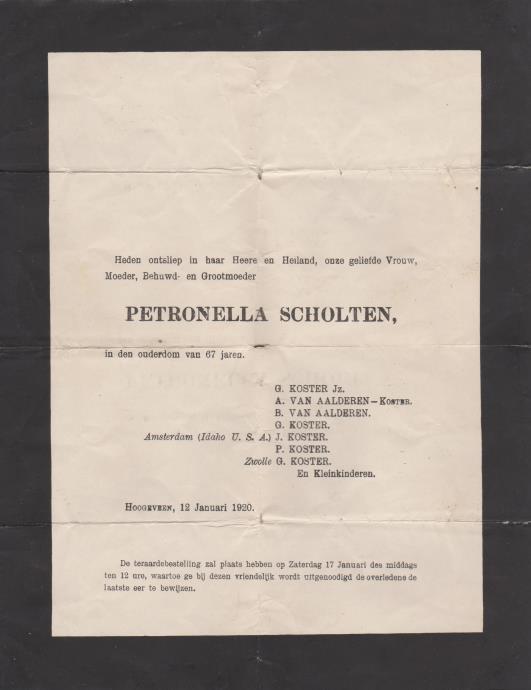
65 | Page
Notice of death sent to Albert Smit Family (Photo courtesy of Charles Micheals)
(Photo courtesy of Charles Micheals)
Married: To Roelofje (M.N. Pieters) in 1878. They had a double wedding with Albert and Jentje Smit.
Roelofje Pieters (M.N. Smit) (F.)
B. 1853 H. Unknown
D. Unknown H. Unknown
BU. Unknown
They had eight children (Aaltje, Hillegonda, Jan Jans, Pieter Jans, Jan Jans, Zusje Jans, Jan Jans, Unknown)
5. Jentje Jans
B. November 1, 1856 H. Hoogeveen, Drenthe, Netherlands
D. July 4, 1919 H. Kalamazoo, Michigan
BU. July 9, 1919, Riverside Cemetery, Kalamazoo, Michigan (Lot: KK, 078, 05)
They had a double wedding with Jan (John) Jans and Roelofje Pieters Smit in 1878
Jentje’s Grandparents On Father’s Side
Grandfather Grandmother
Geert Jan Koster Hillechin (Willems)
Jentje’s Grandparents On Mother’s Side
Grandfather Grandmother
Gerrit Prinsen (Prins) Jentien (Hendriks)
66 | Page
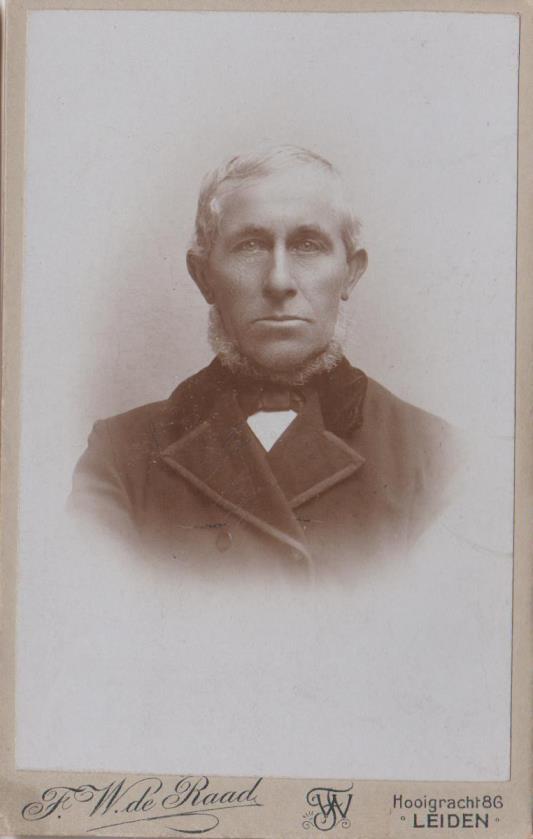
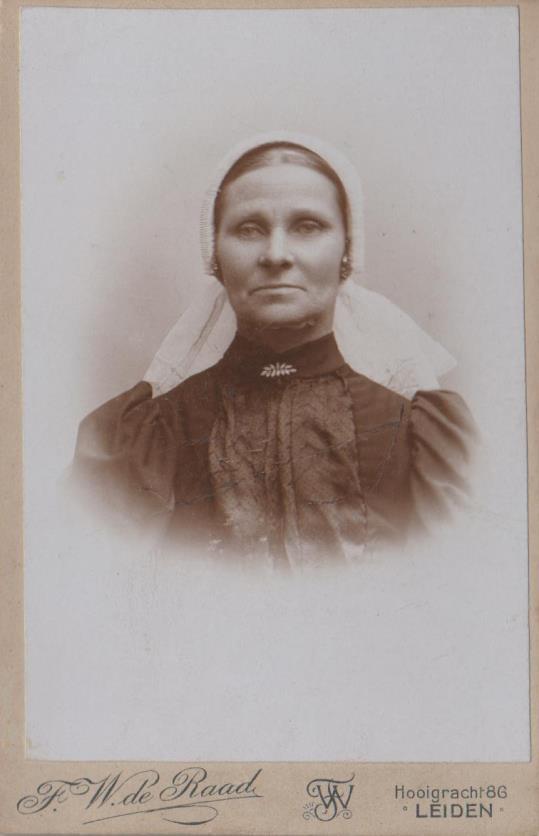
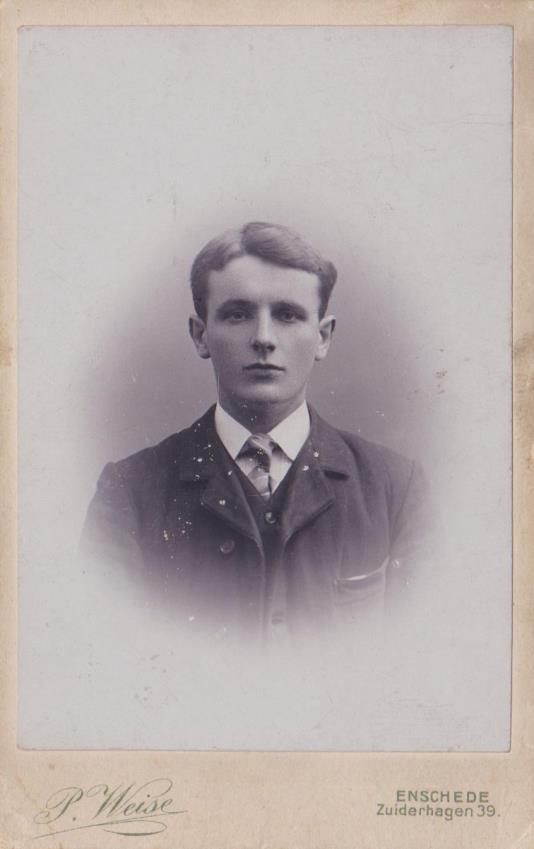
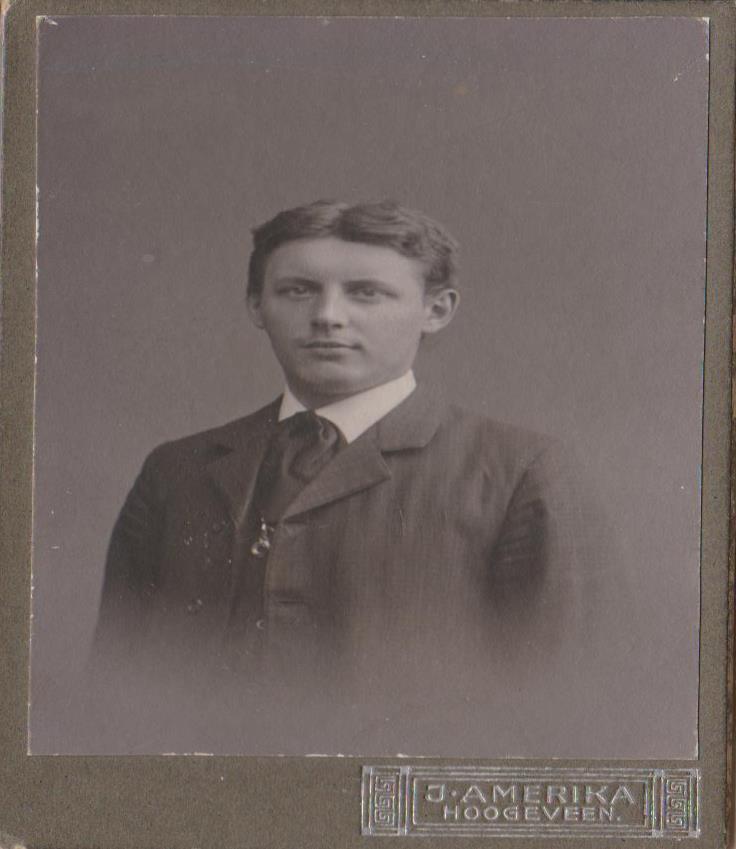
67 | Page
John and Aaltje Koster (Photos courtesy of Charles Micheals)
John Koster as a young man (Photos courtesy of Charles Micheals)
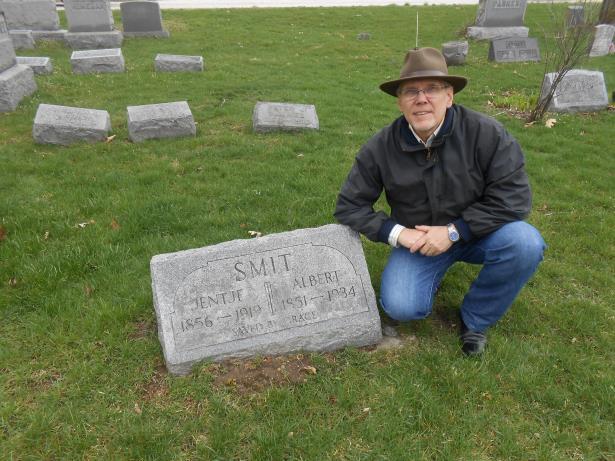
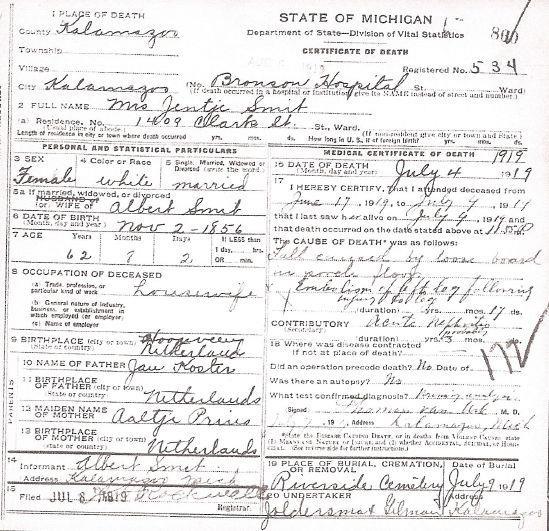
68 | Page
2013 - Charles Micheals at Albert and Jentje (Jennie) Smit’s Gravestone, Riverside Cemetery, Kalamazoo, Michigan (Photo courtesy of Charles Micheals)
Jentje Smit’s Death Certificate (Photo courtesy of James Smit)
Soon after Albert and Jentje were married they moved to New Amsterdam, also in Drenthe, and started a grocery business in New Amsterdam, which they greatly enjoyed. Just after a year of marriage, Albert and Jentje had their first child, John. In the next eighteen years, they would have a total of nine children all of whom would be born in New Amsterdam, except Helen. Seven of their children lived into well into their adult life (John, Jannes (James), Susje, Garret, Alice, Helen and Albert Jr.) while a son, Jan Johannes died just seven months after birth and a daughter Jennie died the day she was born.
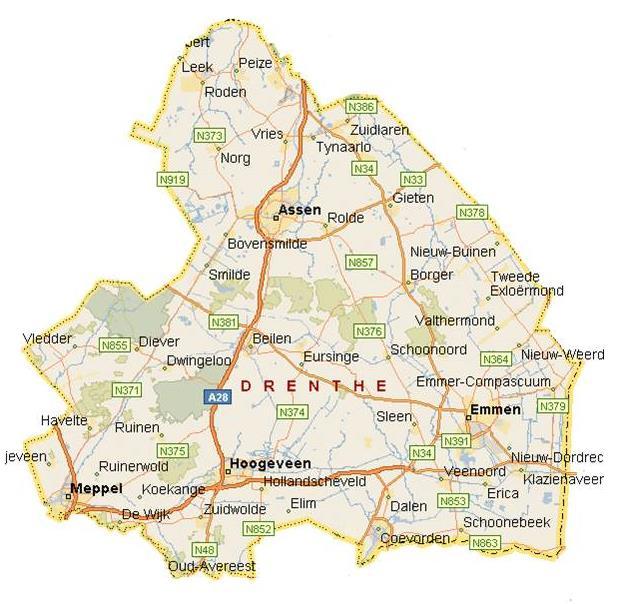

69 | Page
Province of Drenthe
New Amsterdam is near the town of Veenoord
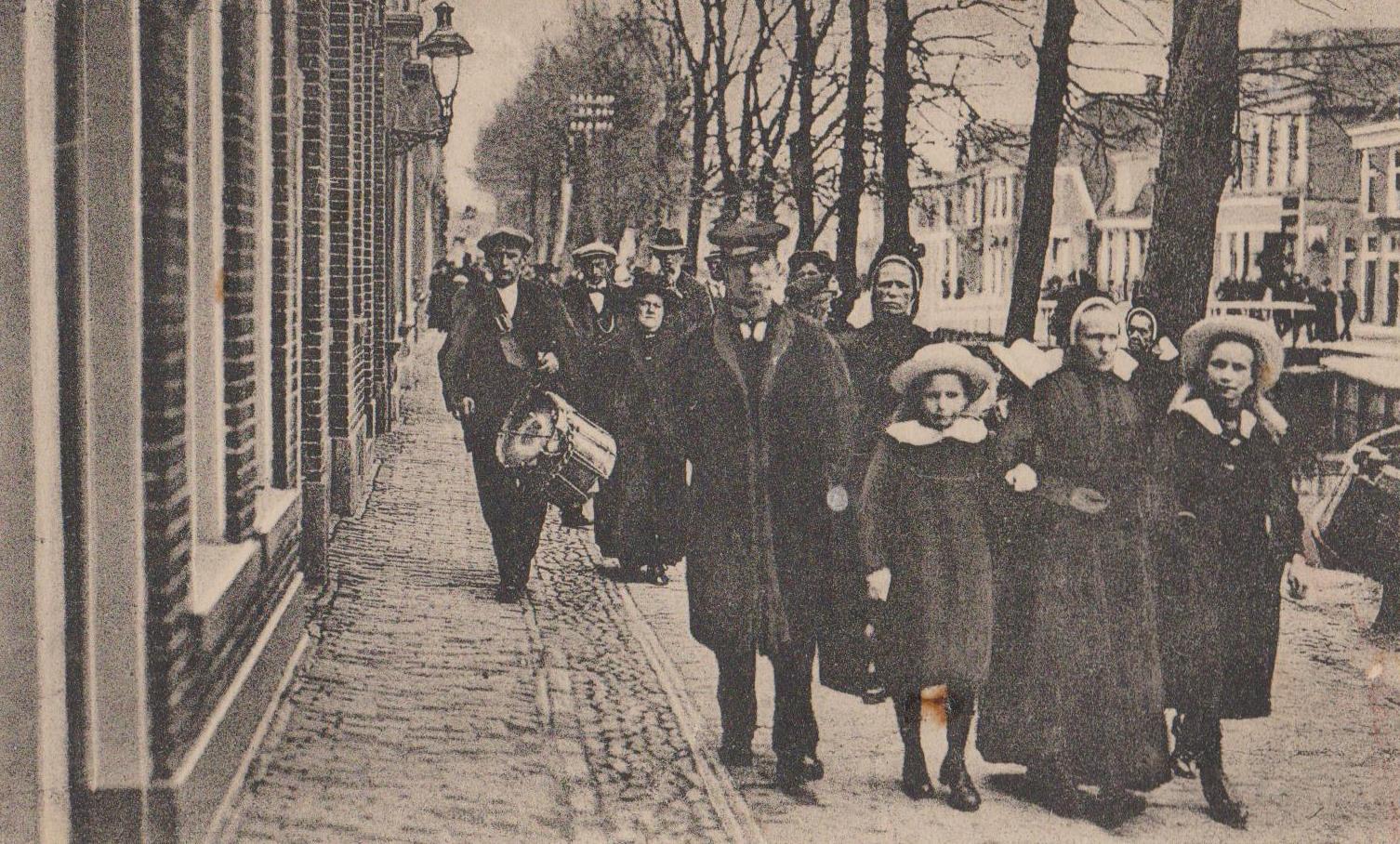
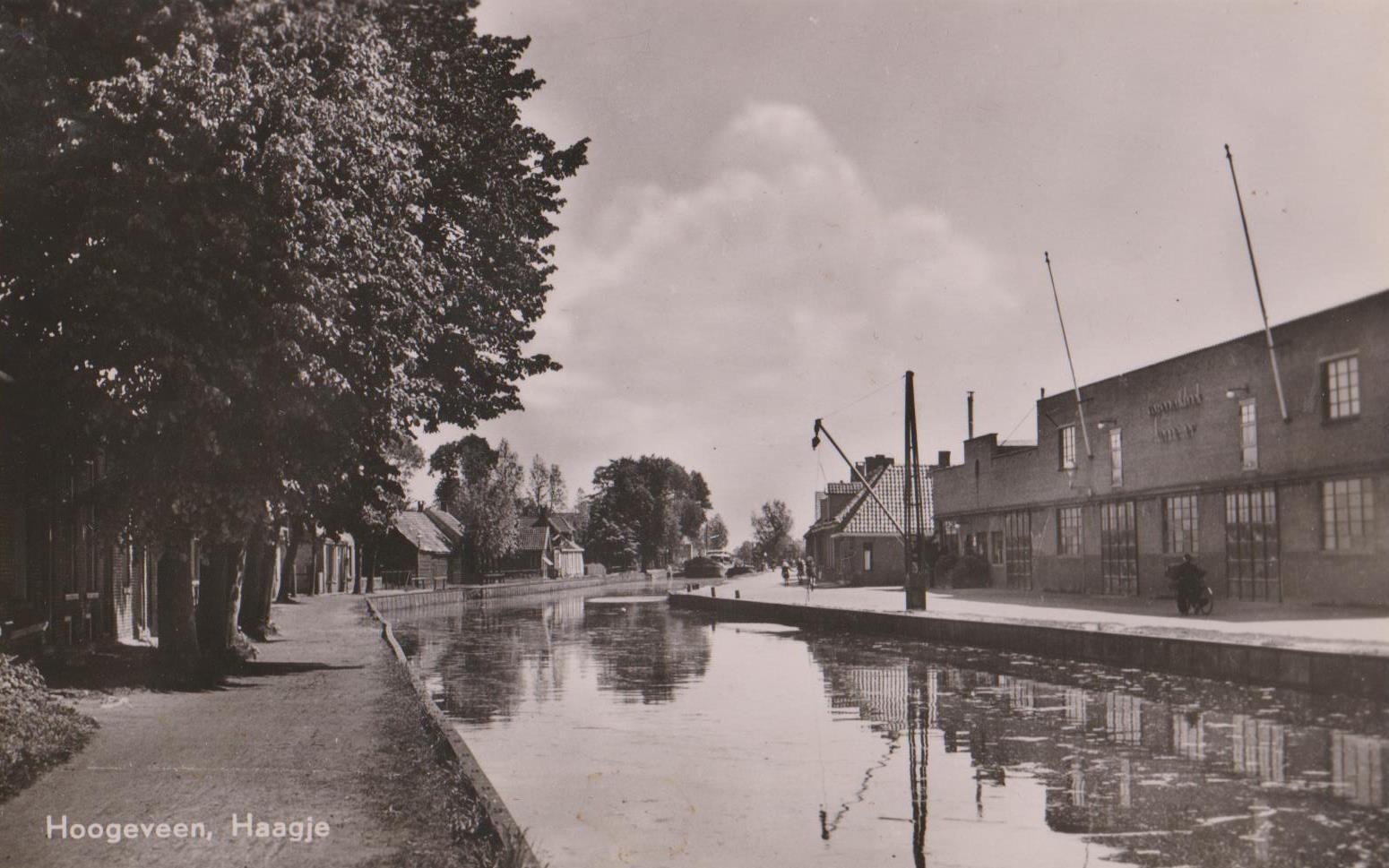
70 | Page
1927 Postcard - Walk to Church in Hoogeveen (Photo courtesy of Charles Micheals)
1954 Postcard – Hoogeveen, Haagje Canal (Photo courtesy of Charles Micheals)
In the mid-1890s Albert Sr. began to decline in health, stricken with rheumatism which left him in such poor health that he was unable to feed or care for himself and could not work in the grocery store. Without Albert’s working in the store, a significant burden was placed on the family of nine. Jentje had to tend the store as well as look after the children.
One of Albert’s brothers, Koert, who had immigrated to South Africa in 1889, heard about his illness and invited the family to move there. He felt the climate there might help Albert’s situation and the long boat ride he thought might also possibly also help his condition.
After much discussion and just after Albert Jr. was born in 1895, the family decided to sell their grocery business in New Amsterdam and move to Pretoria, South Africa. After they sold the store and before they left for Africa, Albert and Jentje and their children stayed at one of Jentje’s sister Helen’s home. There they packed their trunks for Africa and made their plans for the long sea journey. [Author’s Note: One of these wooden trunks is located at the author’s home]
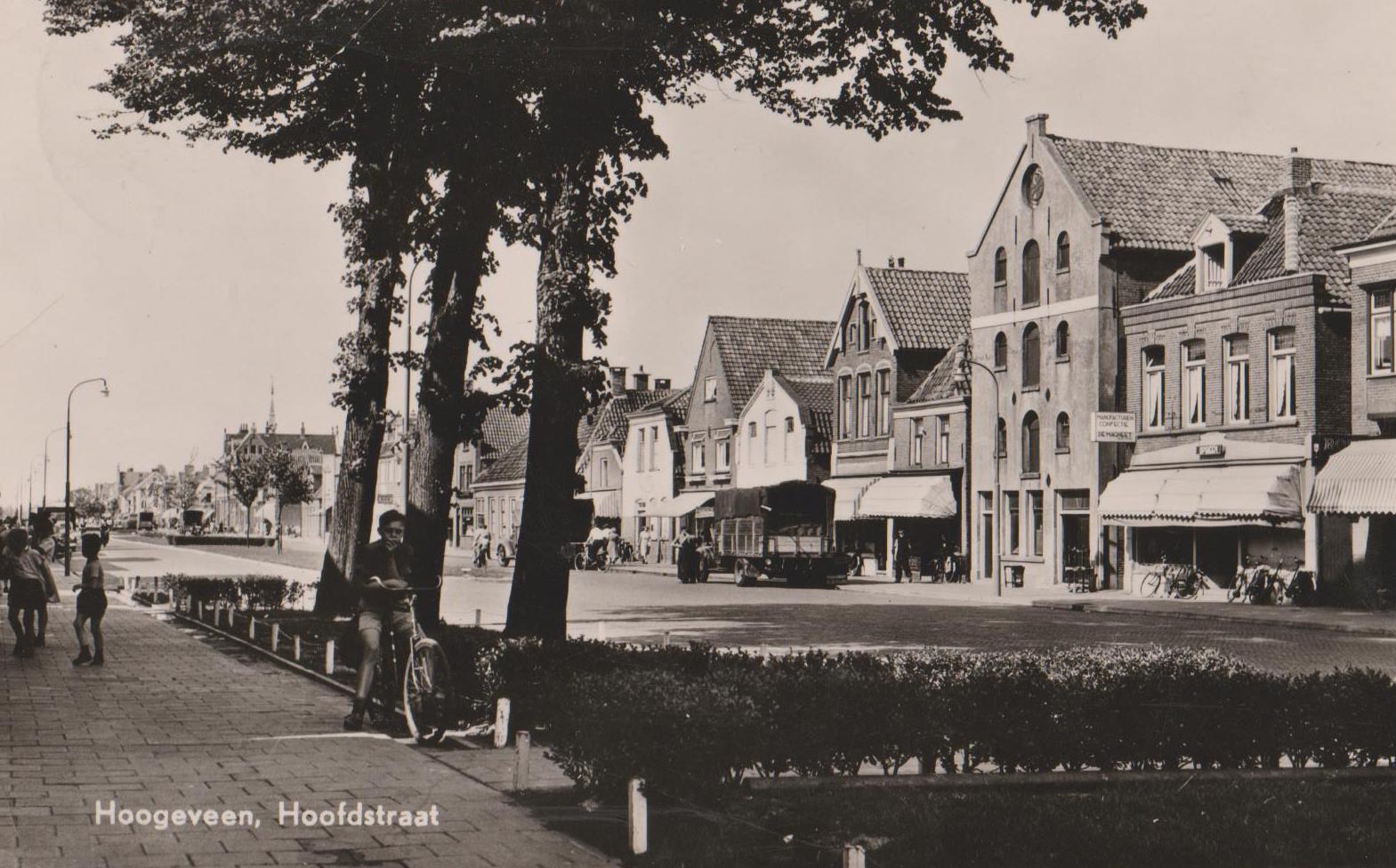
71 | Page
1954 Postcard - Hoogeveen – Hoofdstraat Street (Photo courtesy of Charles Micheals)
Just before moving to South Africa, Jentje’s sister Helen passed away, which made the journey difficult. However, the hardest part of the journey was leaving Jentje’s widowed mother Aaltje, as Jentje’s father Jan Koster had died in 1878. Aaltje had also been living with Albert and Jentje and so there were many tears and they departed for Africa, knowing they would not see each again.
When they left the Netherlands is not known, but likely it was sometime in the middle of 1895 or toward the later part of the year. The Smits first travelled from Hoogeveen by ship and then by train to Rotterdam where they boarded a large ocean liner, likely on an ocean liner owned by the Union Shipping Company. Once on board they lived in small room with an upper and lower berth The trip took several weeks and during the time on the ship the children were given strict orders to stay away from the sides of the ship.
The family was happy to eventually see land. There before them stood Durban, the port city in the British province of Natal. After disembarking from the big ocean liner they were lowered into smaller boats to be taken on shore where the black South Africans dock workers climbed on board ship to help offload the cargo. Their minimal dress, consisting of only a small cloth on the front and backsides (which the children called aprons) and their dark colored skin at first made the children afraid. However, the ship passengers enjoyed the scene and would toss silver coins into the bay where dock workers would dive from the top of the ship and recover with the coins in their mouths.
Once they parted the ship, they were taken by the Nederlandsche Zuid-Afrikaansche SpoorwegMaatschappij (Netherlands-South African Railway Company) train to Heidelberg (a town near Pretoria).
The railroad had not yet been completed to Johannesburg yet. It only reached there in late December 1895, but it had reached Heidelberg by October 10, 1895. That is as far as the Smit family could travel by rail.
While the newly open railway lines to Heidelberg made the journey fairly easy, there was at least one time of excitement along the way. Jentje had taken a small alcohol stove onboard the train to warm up the baby, Albert’s Jr.’s milk. Along the way on the railroad it caught on fire! Thankfully it was quickly put out and the journey continued on safely.
72 | Page
After being picked up in Heidelberg by Albert’s oldest brother Koert, they soon arrived in Pretoria and again met Koert’s wife Roelofje and their four children. How grateful they all were for the safe trip and to see each other again after six years.
Once they settled into Pretoria they discovered that life there was not at all like their home in the Netherlands. There were no canals, no store for Albert to work in and at first only a small house with a dirt floor to live in. They thought back to their nice brick home in New Amsterdam and soon Jentje became homesick. The children too thought at first that life in Pretoria seemed terrible. However, in time things improved.
The Koert Smit family that invited them to come to Africa had five children when Albert and his family arrived. While the parents knew each other, it took some time before the children felt at home there since Koert and Roelofje’s children had all been born in Pretoria, except his oldest son John who was born in the Netherlands. Soon, the children all became good friends

73 | Page
1891 - South Africa – Koert and Roelofje Smit with their four children John, Hendrika, Susje, Jans (Photo courtesy of Martha (nee Jager) Bronsink)
Koert was a busy man in Pretoria. He sold fruits and vegetables as a peddler going through the town and door to door with his produce carried on a cart drawn by a donkey. Although Koert was a hot tempered man, he took good care of his family.
Albert soon found work as an overseer at a government plantation, but it took him away from home for two months during his first time on the job. The oldest son John found work at the Nederlandsche Zuid Afrikaansche Spoorweg Maatschappij (Netherlands South African Railway Company) railway company while koster (James) at age 12 found employment as a printer’s apprentice. He was so small they had to make a bench for him to stand on to work! Alice stayed home helping Jentje take care of baby Albert Jr. Susie and Garret, the older two went to school.
After Albert spent two months at the plantation, he finished his contact work and headed back home. However, he had to walk the long distance carrying his food, water and a sack of clothes. He walked the first night until dark not seeing another person or a house. At bed time he stepped off the path to make his bed using his sack of clothes as a pillow. Being alone and in a new place, the first night he was a little fearful. However, the Lord watched over him and in the morning he set off again. By noon his canteen of water was gone as the day was hot and the trail dusty. Soon his mouth was parched as the noonday sun beat over his head. Albert knelt down and prayed and asked the Lord to provide him with much needed water. After walking for some time, there he came upon a spring of water. He stopped to drink and fill his canteen. Three times he continued his return trip home from this place, but each time he returned to the spring to take more of its’ refreshing supply.
He again walked all day without seeing another person or house and so he began to become worried if indeed he had been on the right path. He had been told that the path would lead him to Pretoria, but he was beginning to have his doubts. Finally at dusk, he saw a house with lights on in the distance. Not
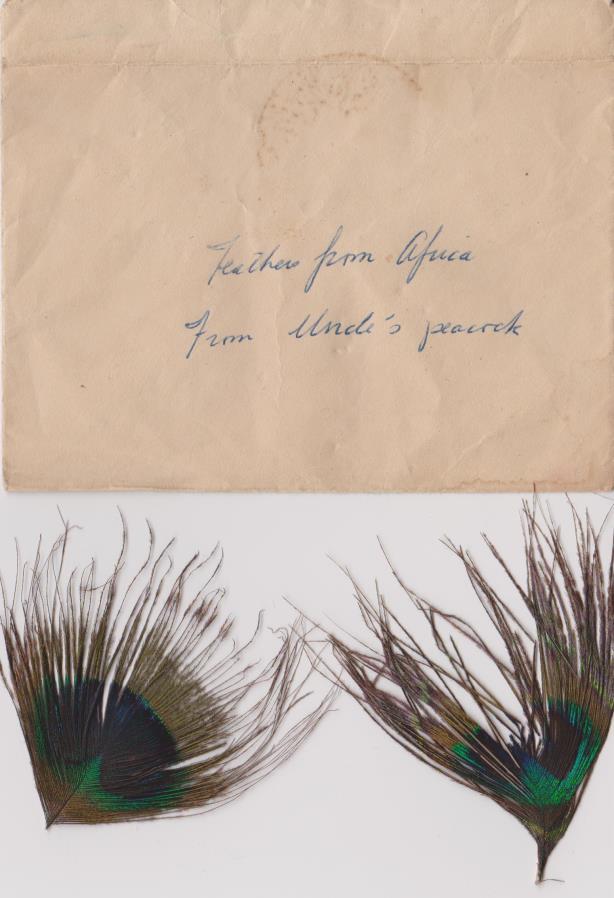
74 | Page
knowing if it would be friend or foe, he hid some of his clothes and shoes and much of the money he had earned. Slowly he approached the house and was greeted by two snarling dogs. From the house came a black South African. Again, afraid of the situation, he cautiously approached the house. Thankfully he found a friendly family who took him in, fed him a meal of corn mush and gave him a straw bed on the floor where the children slept. As he retired to a night of rest, Albert again prayed for the Lord’s protection as he had heard of people who had been robbed and killed in situations like this.
In the morning he realized the Lord had again provided for him. The family gave him a warm meal of more corn meal mush and set him on his way. Albert paid the family for their hospitality, left them some of his clothes and set off for home. On the third day toward evening Albert returned to a home. Jentje and the children were all happy to have him home.
Eventually Albert also got a job as a time keeper at the railroad his son John worked at. He made good wages and the work was easy. Albert and Jentje saved up their money and were able to purchase a piece of land near his brother’s home. The home they built was larger enough for their family. It had a large
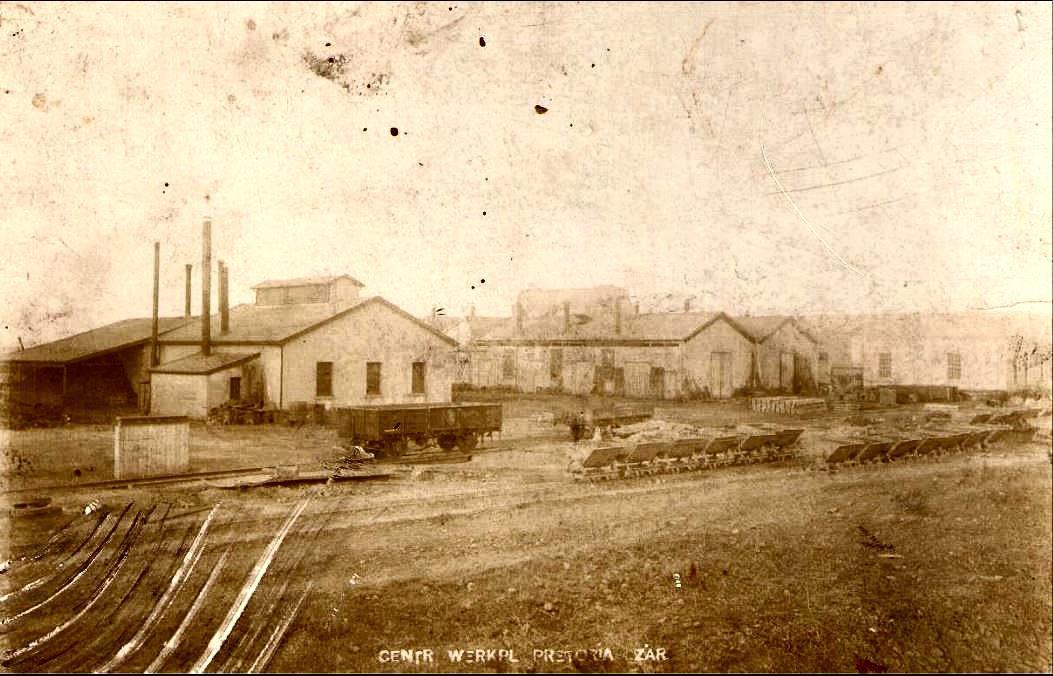
75 | Page
Nederlandsche Zuid Afrikaansche Spoorweg Maatschappij (Netherlands South African Railway Company) central rail yard in Pretoria, South Africa where Albert and John worked. (Photo courtesy of Charles Micheals)
living room, a good sized kitchen, one bedroom for the younger boys and another bedroom for the girls, another bedroom for Albert and Jentje and one for the older son John, with a door to the outside and the kitchen. There was even a bedroom for the houseboy who worked in the house, but he wouldn’t sleep there. He asked Albert to build him a small hut near the garden where he slept on a bed of straw and ate. The back yard of the house had enough room for a vegetable garden and also for a small pond where ducks swam. The backyard was also home to the first banana tree the Smit family had seen.
One day, a South African came to the house to sell fruits and vegetables, which were carried in a basket balancing on her head. She has a small naked baby slung on her back in a net bag. The baby was crying and so when Jentje inquired, she discovered that the baby had a ruptured naval. Jentje offered to care for the baby and so as she bought the produce from the woman. Jentje was able to carefully wrap the baby with clean cloth and cover up the naval. Jentje was happy that she was able to provide care for others after all the help others had given to the Smit family.
After some time has passed, Jentje received a letter from her mother Aaltje Koster. Aaltje had included a recent photo of herself and Jentje could not believe how much her mother had aged. However, the letter told of plans by Aaltje to come and visit. Joy filled the Smit house at the thought of a visit by her.
However, before the plans were realized, the Smits received another letter. This one had a black band on it. Sorrow flooded Jentje’s heart as she looked at the letter and knew what the black mark meant. Inside the letter, it told of Aaltje’s death and soon the house was filled with tears as the last connection to her family back home was gone! The homesickness for Jentje grew.
Rules for medical assistance for personnel of the South African Railway Company
Finally, after five years had passed, Alice was allowed to go to school. On the way to school, the children passed by a fruit orchard with a small stone wall. Over the years, children had eyed the fruit and finally found a way to dig a small tunnel under the wall. On occasion, children would be caught by the owner’s dogs and they put into a pit to scare them off.

76 | Page
One day Alice decided to venture under the wall and pick some apricots. She ate some on the way to school and then tucked some into her apron to carry home at night. As Jentje put Alice to bed that night, the Lord pricked the conscience of Alice and reminded her that was she had done was to steal the neighbor’s fruit. Alice confessed to her mother at bedtime what she had done.
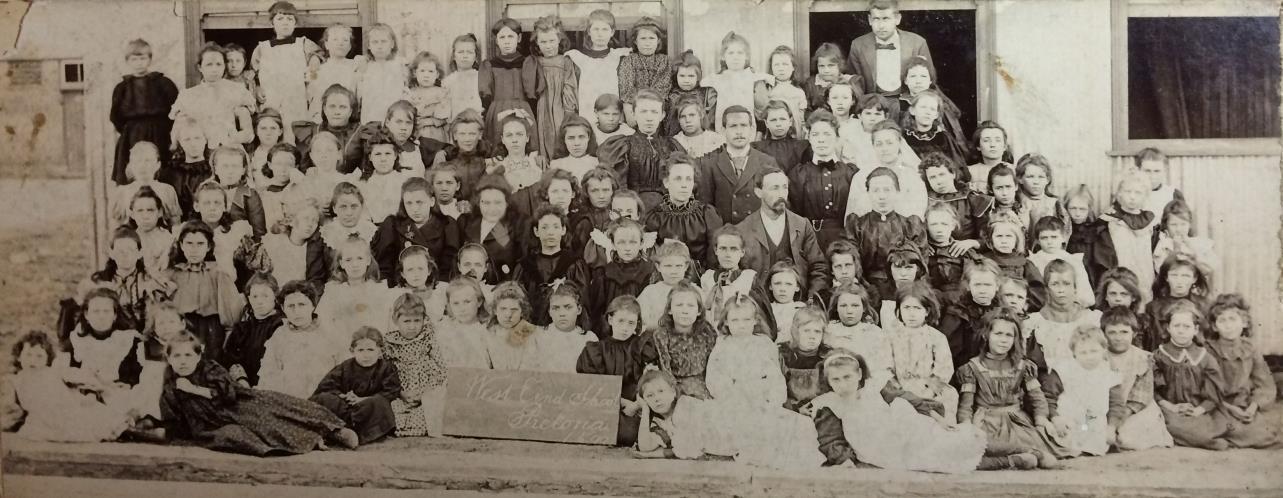
In the morning Jentje and Alice went to the neighbor’s house for Alice to apologize and for the Smits to pay for the fruit. The owner was grateful that they had come and said that because the fruit was picked off the ground, no payment was necessary. After that, the fruit never had the appeal it did before as Alice was reminded her that stealing was a sin and that God always knew what they were doing.

77 | Page
1899 - Garret Smit at West Eind Grade School, Pretoria, Transvaal (Photo courtesy of Charles Micheals)
1899 – Alice Smit at West Eind Grade School, Pretoria, Transvaal (Photo courtesy of Charles Micheals)
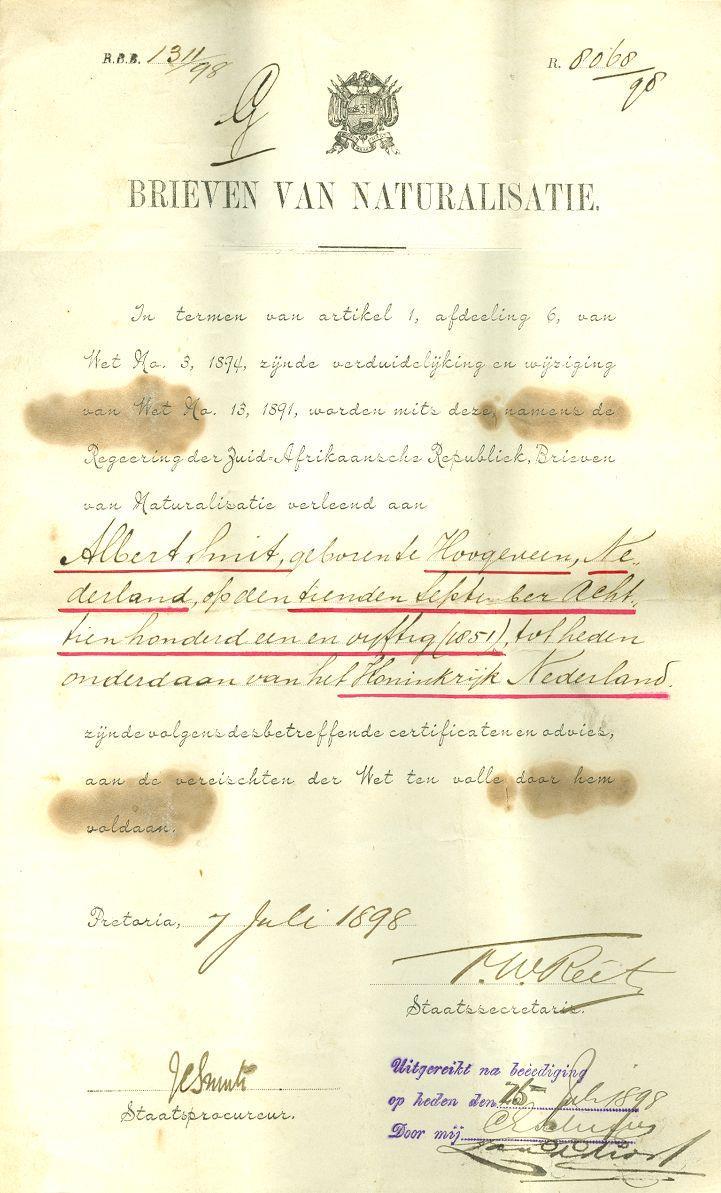

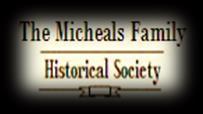
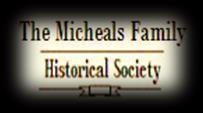
78 | Page
July
7, 1898 - Albert Smit’s Transvaal (Republic of South Africa) citizen paperwork (Photo courtesy of Charles Micheals)
Chapter 6 The Boer Wars
The Boers were staunch Calvinist farmers from the Netherlands, Germany or of French Hugenot decent, who immigrated to South Africa. After intially immigrating to the Cape Town region in the 1600s, they eventually spread out throughout the country. They were often hostile to the indigenous African people and fought frequent wars with them and they resisted the control over them by the government in Cape Town. They believed that their life was like those of the Biblical Hebrews and they saw themselves as children of God who were divinely ordained to rule the land. Today the Boers are known as Afrikaners.
In 1806, the Cape Colony in South Africa became a British possession and soon the Boers grew to be very unhappy with the liberal policies of the British and control over their lives. The situation was eased in 1854 when the Bloemfontein Convention was signed that recognized the Orange Free State and Transvaal (South African Republic), where the Smit family lived, as a fully free and indepnedent nation. However, in 1867, the discovery of diamonds and gold in the Vaal River area near Johanneaburg changed the landscape of southern Africa forever. A reciepe for war began to be written.
The British government laid claim on the wealth produced by the minerals as it was discovered. The Boers resisted giving rights to British immigrants who travelled to work in the gold and diamond fields. A two stage war soon developed over these issues
The First Boer War, after more than a century of conflict between the Boers and the British Empire, was only a one year war (1880 – 1881). It was fought mainly over which group of people (the British or the Boers) would control and benefit most from the profitable Witwatersrand gold mines. The war quickly came to an end and resulted with Boer self-government and the Boer’s acceptance of the British Queen’s nominal rule. However, the issues related to the ownership of the rich minerals in South Africa were never
79 | Page
fully settled and eventually the Second Boer War broken out in early October 1899 and lasted until late May 1902.
The Smit family immigrated to South Africa between the two Boer wars wars and how much they knew of the conflict is unknown. Certainly the Koert Smit family who had immigrated to Transvaal earlier knew of the conflict, but must have felt the issue was resolved enough for Albert and Jentje and family to come in 1895.
Paul Kruger, the influental and internationaly renown leader of the gurrilla resistence in the First Boer War had become the President of the South African Republic, largely known as Transvaal, in 1883. He reamined in power the entire time Albert & Jentje Smit and family stayed in the country. He was initially a member of the Dutch Reformed Church, but became a founding member of Reformed Church in South Afrcia that was formed in 1859. These two churches operated at a time when the Dutch Calvinist did not believe in the seperation of church and state and so it was not unusual at the time for the church to have its say in the way the government was run. Paul Kruger fled the country a few days before Lord Robert’s British army invaded Pretoria in May 1899.
1897 Map12
When the second Boer war broke out, the British fought directly against the Orange Free State and Transvaal and the railroad Albert Smit and his son John Smit had been working at played a critical role in the Boer’s losing the war eventually in 1902.
12 http://alabamamaps.ua.edu/historicalmaps/africa/central-southafrica_2_1896-1900.htm
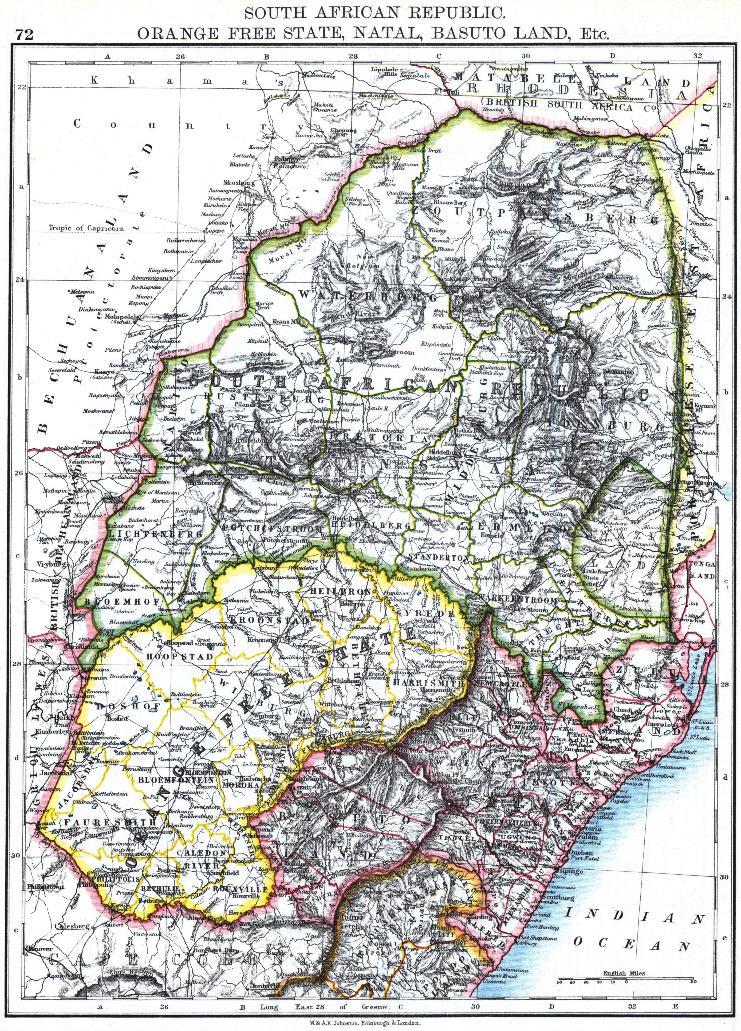
80 | Page
The war was largely started after the President of Transvaal, Paul Kruger would not let the British workers in the diamond mines have voting rights unless they lived in the country for fourteen years Then it was proposed to lower that to just four years with only a certain number of British born citizens could hold political office. That unsettled the British government in Cape Town and the British citizens working in Transvaal. When it appeared the British might take military action, the Boers launched military action on October 11, 1899 and tried to take the port city of Durban. Albert and Jentje’s eldest son John was called into military service on behalf of the Boers.
The British resisted the Boer’s attacks and fought by staging military action from both Cape Town to the south and from Durban to the east. While the Boers won some early battles in the fall of 1899, the tide of war had shifted and by late February 1900 the British won a number of very important battles. One battle was the Battle of Paardeberg, to the south of Transvaal. After a short scrimmage, the Boers surrendered on February 27, 1900. Ironically the surrender was on the same date as a major victory that the Boers won in the First Boer war. In that battle in the first war on February 27, 1891, known as the Battle of Majuba Hill, the Boers won a stunning military victory. After that victory the Boers commemorated that victory yearly as the “Majuba Day” which became a major Boer celebration.
To make the surrender on February 27, 1900 even worse was that the fact that the Boer leader in the Battle of Paardeberg, General Pieter Arnoldus Cronjé (known as Piet Cronjé) had been the Boer general that had successfully defended the Boers in the Jameson Raid (December 29, 1895 – January 2, 1896). That failed raid on the Transvaal Republic was carried out by the British statesman Leander Starr Jameson, who eventually became the 10th Prime Minister of the Cape Colony. At the time of the raid he was the appointed the leader a private army of Bechuanaland policemen and the British South Africa Company which Cecil Rhodes co-owned of the British South Africa Company along with Alfred Beit. At the time Cecil was also the Prime Minister of the Cape Colony.
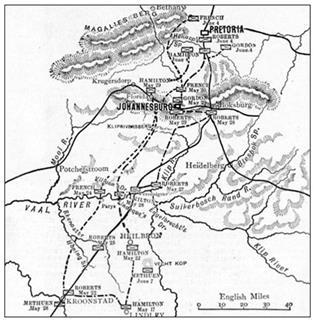
81 | Page
(Map Courtesy of H. W. Wilson, With the Flag to Pretoria, 1902)
Cecil created the army whose main goal was to create unrest among the Uitlanders (foreign workers) in Transvaal which would eventually bring down the Boer government of Transvall. His goal was to put all of the Transvaal area under the control of the British government and for his mining business ventures to have control of a larger region.
The plans did now go as drawn up and so Jameson grew impatient. Later on it was found out , that with the blessing of Cecil Rhodes, Jameson prematurely launched what was to became known as the Jameson Raid in late December 1895. His army managed to come within twenty miles of Johannesburg before he was pushed back by the Boer military led by Piet Cronjé. That victory gave great notoriety to Piet and confidence in his military abilities.
Thus, when Piet’s military troops fought in the Battle of Paardeberg, the Boers expected another great victory. When the Boers lost the battle on Majuba Day (February 27, 1900), it caused the Transvaal President Paul Kruger to state, "The English have taken our Majuba Day away from us "13
From that point on, the Boers, while continuing to resist the British, had for all practical purposes lost all their will to fight. Within two weeks, on March 13, 1900, the British walked unchallenged into Bloemfontein, the capital of the Orange Free State and brought that republic under the control of the British government. They quickly renamed the province to the Orange Rover Colony. Now, only the town of Johannesburg stood in the way of capturing Pretoria, the capital of Transvaal.
While a few other battles were fought in the next two months, the British had not only won in February Bloemfontein, to the south of Pretoria, but also won a decisive battle against the Boers in Ladysmith to the east. This was on the path of the railroad from Durbin to Johannesburg. The British now controlled the railways in both directions into Pretoria and Transvaal’s fate was sealed. It was now only time before the British rode into Pretoria on the railway with their plumed hats and guns slung over their shoulders.
82 | Page
13 Judd, Denis; Surridge, Keith (2013). The Boer War: A History. I.B.Tauris. p. 168. Retrieved February 28, 2015.
The city of Johannesburg (1900 population of 106,000 of which 60,000 were white14) fell first. Then the city of Pretoria (1900 population of 12,500 of which 10,000 were white15) fell Not a shot was fired In either city by either side.
On Tuesday, June 5, 1900 at 2:00 pm the British rode into a largely deserted Pretoria with the Smit family watching them come in by rail and the Boers surrendered. Many Boers had previously fled north and east and a trainload of Boer soldiers had left earlier in the morning to continue fighting a guerrilla war which would last another two long gruesome years. Earlier, at 8:47 am that day, an advanced party of British officers came to prepare the grounds. Leading that procession was Charles Richard John SpencerChurchill, the Duke of Marlborough. He paraded with a large number of British soldiers on foot and by horse in front of the Dutch church in the Church Square on his way to the prison holding over 3,000 British prisoners-of-war. Next to the Duke was his cousin, Winston Churchill, the future Prime Minister of the United Kingdom. He had been a war correspondent in the conflict and had been held for one month in the same prison in November 1899, before escaping.
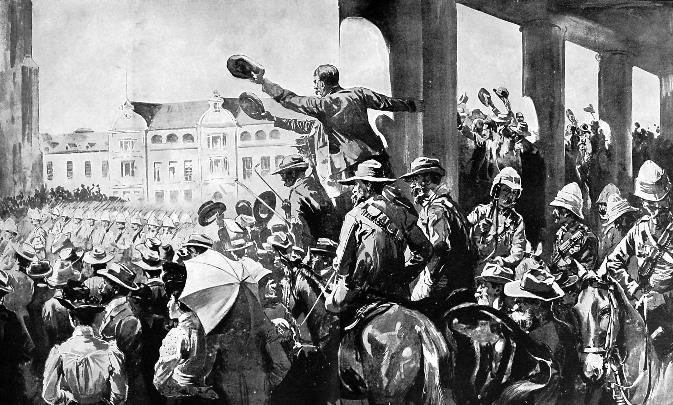
83 | Page
14 The New International Year Book: 1900,p. 868 http://tinyurl.com/mkpe8dg Retrieved February 28, 2015 15 Ibid.
June 5, 1900 - The scene in Church Square, Pretoria when Lord Robert’s British troops enter the town (Sketch from W.B. Wollen)
At 2:00 pm, the Duke cried, “Surrender” to the Boer commander and the British took control. Upon the Dukes orders, the Dutch sentries open the prison doors and threw down their rifles which the prisoners picked up. Quickly the Union Jack was raised on the Transvaal Republic legislative building and now only the formal surrender of Pretoria awaited, which went off without any problems.
June 5, 1900 - The final print in Bacon's series of South African Battle Pictures. The New South Wales Lancers are depicted in a parade with Field Marshall Lord Roberts and General Lord Kitchener (South Africa 1899-1902) watching on. The troops depicted include British Army Guards, Naval Brigade, City Imperial Volunteers, Lancers, New South Wales Lancers, Canadian Artillery, Highland Brigade, Royal Horse Artillery, New Zealand Contingent, Imperial Yeomanry, Dublin Fusiliers and the parade is watched by citizens of Pretoria and officers and men released from Boer prisoners of war camp. The parade was celebrating the capture of the Transvaal Republic capital of Pretoria by British and Commonwealth forces. The Union Jack was hoisted up in front of the Boer Legislative building as a mark of triumph; it was thought that taking Pretoria would end the War. (Photo is Public Domain –Secured from the Australian War Memorial, G.W. Bacon & Co. Ltd - Publisher)
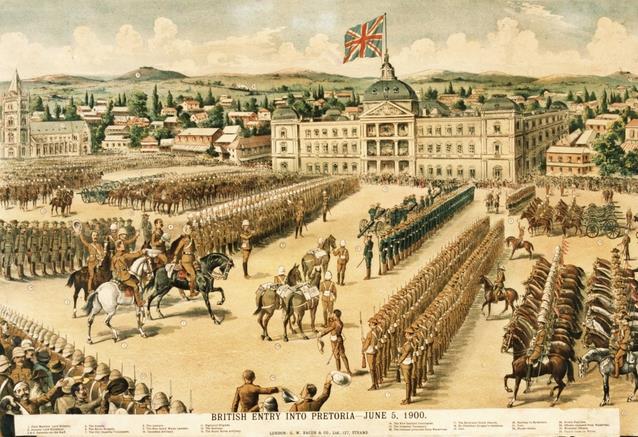
While the British eventually defeated the Boers after two more years of a bitter guerilla warfare, tens of thousands of Boers would be put into concentration camps. In all, tens of thousands of troops on both sides died and many more indigenous Africans died.
The war officially fully ended with the Treaty of Vereeniging being signed on May 31, 1902. As part of the settlement the Boers were given £3,000,000 for reconstruction. The two former Boer republics were given
84 | Page
limited self-government in 1906 and 1907 as part of the British Empire. The united provinces became known as the Union of South Africa, which was established as a member of the Commonwealth in 1910.
The war left an indelible mark on others living in the area and they suffered a significant human cost. Over 75,000 lives were lost; 22,000 British and other allied soldiers (7,792 killed in battle, the rest through disease), between 6,000 and 7,000 Boer fighters. In the concentration camps, between 20,000 to 28,000 Boer civilians died (mainly women and children) and perhaps 20,000 black Africans also died (both on the battlefield and in the concentration camps)16 .
The war also left an indelible mark on the Smit family. Not only did they see an end to their way of life in South Africa, but their son John who had gone off to war with the Boers was told he could not leave. As the British took over their homeland in Pretoria, the two Dutch republics no longer existed and so Albert was separated from his pregnant wife (by order of the British government) and also made to stay.
After the British took over Pretoria, Jentje Smit and her children were ordered to immediately leave and return to the Netherlands. Albert was ordered to stay back because of his work at the railway and son John had to stay back to finish out his time of service, now in the British military.
There was little time for Jentje and the children to pack. The trunks that had been brought over were repacked and in July 1900 Jentje, who was five months pregnant, boarded the train headed for Durbin with five children in tow (Jannes, Susie, Garret, Alice and Albert Jr.). The train ride was long and difficult as Albert and their oldest son John were not along to help with the younger children. In Durbin they boarded a ship with each older child being given strict instruction to watch the younger ones on the ship
The ocean voyage was long and hard for Jentje, but to the younger children another adventure. The days grew long and as the ship crossed the equator and the days were very hot, water had to be thrown on the ship’s deck to make it bearable for the passengers. After spending several days to pass through the Suez Canal, the ship made stops in Palestine and Naples, Italy In Naples vendors came aboard the ship to sell various items and Jentje bought a special sea shell that the children kept for many years and often put it
16 http://en.wikipedia.org/wiki/Second_Boer_War
85 | Page
by their ears to hear the sounds of the ocean. Sadly, in all the moves that were ahead for the Smit family, the shell was eventually lost.
Once arriving back in Rotterdam Jentje and the children boarded trains and returned home to Hoogeveen, Netherlands. At first they stayed with Jentje’s sister Helen’s husband Aaldert Streutker’s home Helen as noted earlier had passed away five years earlier and Jentje’s mother Aaltje Koster had also died. Jentje was given her mother’s room and the children all had beds in nearby rooms. While the family barn was under the same roof as the house, the barn was so clean it never smelled.
When the time came for Jentje to give birth, sadly her husband Albert was still in South Africa. However, the larger Smit family in Hoogeveen helped out during this time. Therefore, Jentje was able to have her daughter Hilligje (Helen) on October 27, 1900 in the same bed that her mother had died in.
A few months later, likely around Christmas 1900, Albert was able to travel back to the Netherlands The British had forced him to leave South Africa at that time so quickly he had no time to sell their house or furniture. Therefore, Albert had his brother Koert sell and dispose of these things
While in South Africa John Smit had been corresponding with Anje (Anna) Huisman, who lived in the Dutch town of Termunten in the province of Groningen. When he was released from military sometime before Albert was released, he traveled to Termunten and married Anna on October 31, 1900 in Termunten.
Very soon after the marriage, Anna become pregnant. Before the baby was born, John and Anna decided that they would immigrate to the United States. John sailed for America leaving Rotterdam on July 25, 1901 and headed to Kalamazoo, Michigan where he was met by his uncle G. Smit. Anna stayed back in Termunten after she delivered their first child Jentje (Jennie) Smit on June 26, 1901. At some unknown point of time, likely a number of months after Jentje was born, Anna made her way with Jentje to Kalamazoo.
Once Albert and Jentje Smit were reunited to the Netherlands and after they spent just a short period of time in Hoogeveen together, Albert visited the nearby city of New Amsterdam where they had lived before. He found a building to rent and opened up a grocery store. The family, still in Hoogeveen, packed their bags and took up residence in New Amsterdam once a house was found
86 | Page
The children back in the Netherlands had some difficulty in their reentry to life there. Most of the children were young when they went to South Africa and had learned the Afrikaner language even though the Dutch language was spoken in the home. Coming back to the Netherlands where everyone spoke Dutch took the children some getting used to. Eventually they made the transition back to speaking Dutch everywhere they went and finally the Smit family felt like finally they were Hollanders again!
After winter set in, snow fell and the Smit children happily played in what was an unknown wonderland. As the canals frozen over, Albert and Jentje told the children of the time they had skated in the canals all the way from New Amsterdam to Hoogeveen to visit their parents before they moved to South Africa. The children also pleaded with their parents to buy them wooden shoes for walking to school like all the other Dutch children had. They also learned the games ‘Drop the Handkerchief’, ‘A Tisket a Tasket A Green and Yellow Basket’, ‘Here Comes A Bluebird in the Window’, ‘Hop Scotch’, ‘Jump Rope’ and enjoyed singing “Jesus Loves Me” which they had learned in South Africa.
When the springtime and summer came, the canals were favorite spots for fishing. Along the banks of the canal were wild flowers and long reeds, which the children would pick to make baskets of white Daisies and Buttercup flowers to give to their mother. However, this bliss was soon interrupted when son John wrote to the family in the Netherlands and suggested that Albert and Jentje and the children should also immigrate to the United States. Quickly they decided to do that and again the Smits were packing their trunks for the long voyage to America.
Albert and Jentje, sons James, Garret and Albert Jr. and daughters Susie, Aaltje (Alice) and Helen set sail for the USA transiting through Liverpool, England. Once in Liverpool, Helen developed some pimples on her and so they were detained about two weeks to determine what the health risks were. After this stay in Liverpool, they aided on to America on the ship the Majestic. After spending several weeks on the ocean they finally passed the skyscrapers of New York City and the Statue of Liberty arriving at Ellis Island on August 28, 1902.
After clearing immigrations with $42 in their pockets they traveled by train to Kalamazoo to meet their son John. (It is unclear when John Smit’s wife Anna and their daughter Jenny arrived in the USA, but it was likely before Albert and Jentje Smit and family did. It is also unknown if Anna came on the same ship from the Netherlands as John did, but it doesn’t appear Anna and daughter Jenny did.)
87 | Page
While none of the Smit or Meyer diaries note the details of their immediate arrival into New York harbor and the subsequent trip to Kalamazoo, the Stapert family, (noted in this book) did keep an exacting diary of their travels to America. The section below if information from that Stapert diary and while the Smit family might have had a slightly different experience, it in all likelihood the same as described below:
A Recasting Of The Stapert Diary With Dates And A Few Details Changed To Reflect The Smit’s Departure Dates And A Few Details to reflect the Smit’s life
Our trip from the Netherlands, Hoogeveen, Drente, Netherlands to the United States of America, Michigan, Kalamazoo began on August 3, 1902 (approximate date).
This day will never be forgotten in our memories. I had long the idea to change our residence and not this alone, but to leave the Netherlands, the place of our birth and rearing, and initially go to South Africa, but the Lord had other plans to bring us to the United States. This desire was realized when our son John in Kalamazoo, Michigan advised us that life in America was as good as life in South Africa and even better!
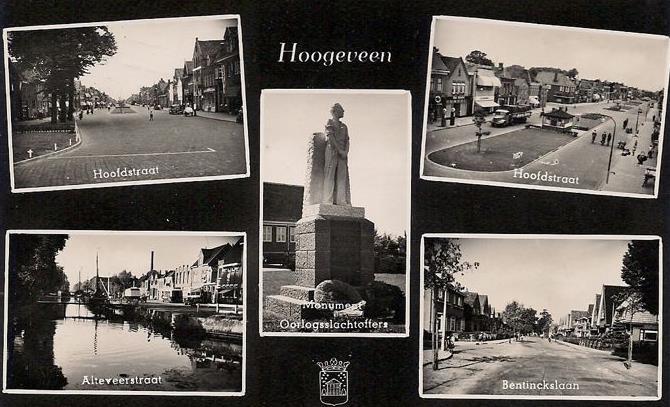
88 | Page
The home of the Smit family – Hoogeveen, Drenthe, Netherlands
The preparations were made to sell the items from our grocery store in New Amsterdam and we traveled back to Hoogeveen to farewell our family and friends. And so on the first day of August left Hoogeveen and headed to Rotterdam for the sea voyage to America.
Here we had to be inspected or examined and receive our ship papers or passports. We appeared before the Doctor with uncovered heads. One examined the head, the other our eyes. They eyes were given close inspection.
There was an old man who was turned down. You can imagine what this meant. Obviously he was expected by his children on the other shore. It could be detected that this man was a farmer. If he has chosen to travel 2nd class he would have made the trip. Second class passengers are not required to pass examination. Anyone who wishes to immigrate to America and has some physical deficiency does well to choose to travel 2nd class.
We stayed this night in a hotel operated by the shipping company. This hotel is available to anyone. At 8:30 the next morning we boarded ship. This is a tedious process. Anyone who takes such a trip must not be too much in a hurry.
When we left our birthplace a man said to us, “Listen friend, I’ll give you some good advice for the trip.” I said to him, that I would appreciate good advice for taking such a long trip.
He said, “Be lazy.” Now this was to our way of thinking strange advice. And should we give others this same advice to be lazy? But, this man’s purpose was genuine. Don’t go at such things hastily and don’t overdrive yourself and fret about such circumstances is what he meant. If we accept it this way, we consider it excellent advice.
After boarding, we shipped off in about 1 hour. What a number of people on the docks to bid us a last farewell. The tugboat Vlaardingen shoved the ship away from the dock. The music played the National Anthem, Wiens Neerlands Bloed17 . 17 https://www.youtube.com/watch?v=9ed_41T-07U
89 | Page
Wiens Neerlands Bloed
1. Whoever has Dutch blood flowing in their veins, Free of foreign blemishes;
Whose heart glows for king and country, Rejoice in song as we do!
He sings with us, united in purpose, At the top of his voice
This festive song, pleasing to God, For fatherland and king (2x)
2. The divinity on her heavenly throne
Serenaded and honoured
Favourably disposed to our sound Keeps the holy ear turned:
She sings first-rate, in conjunction with the heavenly choir
Operating on a higher plain
This full and hearty song
For King and fatherland (2x)
3. Pour out therefore, brethren, one in spirit, the far high heard cry;
He to God has a virtue less, Who forgets sovereign and country; He burns not for man and brother
In his unmoved chest, Who remains cool to prayer and song
For Fatherland and prince.
4. Our heart beats, swells our blood, When this hymn is raised: No other sound fills our minds, Our beating heart with such beauty:

90 | Page
Here melts the firstmost and dearest worth Of common wealth and weal Into a single feeling by common song For prince and Fatherland.
5. Protect, O God! guard the ground, Upon we breath; The place where our cradle stood, Where yet our grave will stand. We beg your father's hand, Stirred deep in chest, Conservation for the dear fatherland, For Fatherland and prince.
6. Protect him, God! guard his throne; Built on perpetual right; May his crown ever dazzle our eye Even more by virtue than gold!
Support the sceptre, which he bears, Guide it in his hand;
Inspire, O God! Preserve the prince, The prince and Fatherland.
7. Away! Away! Who forges plans for one of them alone: We feel, in weal and woe, that country and king are one.
O God! Do not hear upon the call of him who dares to separate them, But listen to our common song For Fatherland and prince.
91 | Page
8. May loudly, from our festive roar
This supplication enter your heaven
Preserve the monarch, preserve his House
And us, his family
Grant our wish by this very song
Preserve, oh Lord, for ever the King
And the dear fatherland (2x)
The cables were loosed and one could notice the movement of the colossus. The Captain was standing on the bridge looked about through his binoculars. All passengers were on deck. It was beautiful weather.
Slowly we moved on. We did see the disabled steamship Berlin because just when we passed the Hoek van Holland we were eating. The menu in 3rd class is good. Those who are accustomed to a common
18 https://www.hippostcard.com/listing/netherlands-rotterdam-oudehoofdplein-oude-hoofdplein-en-haringvliet-ships1908/15047029

92 | Page
1908 – What the skyline of Rotterdam looked like when the Smit family left the Ndetherlands18
laborers diet say themselves that the 3rd class menu is best: meat, butter, vegetables as much as you desire.
19
The sleeping places could be better (when it is cold there are not enough blankets). The space is also too crowded as Third class holds 2,300 people.
These are bunks which at 7 x 7 ft. where 4 persons (2 above each other must locate and above which their baggage must be stored). We couldn’t complain because I and my wife and sons (Jannes, Garret, Albert Jr.) and daughters (Susie, Alice, Helen) had a place to sleep.
It was nice weather the entire way. At 8 in the evening passed by Boulogne, France. This is a nice sight in good weather. On the right the coast of England and on the left hand France with its thousands of lights around the sea town of Boulogne.
The boat stopped momentarily and waited for a smaller boat. The music played the French Marseillaise.20
19 https://en.wikipedia.org/wiki/Royal_Netherlands_East_Indies_Army#/media/File:Isaac_Israels__Transport_of_colonial_soldiers_-_Google_Art_Project.jpg
20 https://www.youtube.com/watch?v=cBjS1oFLKOg
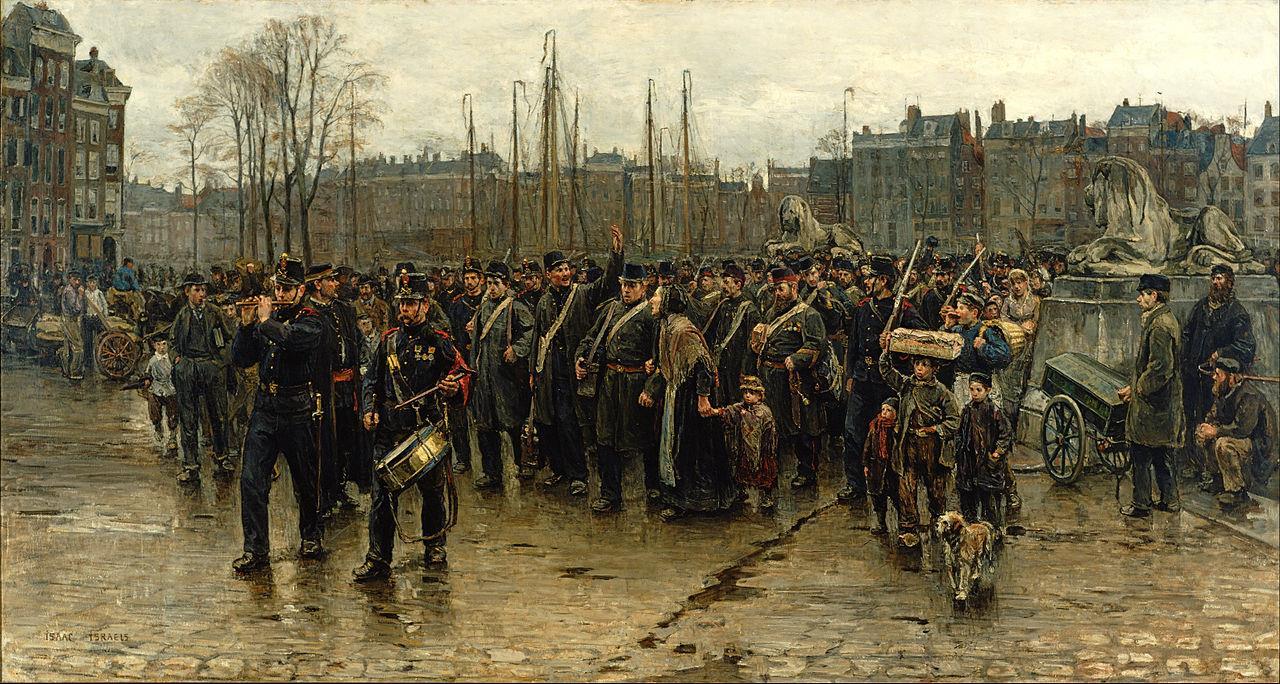
93 | Page
Recruits for the Royal Netherlands East Indies Army marching though Rotterdam
We must take on passengers. The little steamship came closer and lay still alongside the giant which would point itself to the ocean.
It appears that there is but 1 3rd class passenger, a French woman. The whistle blew, the small French boat left and the giant ship began to move. At 9 o’clock we went to bed.
It’s out of the question that we could sleep. The first night far from family and friends and unaccustomed movements of the ship, this all contributes to the problem of falling to sleep soon.
When you awoke, where am I now? One must first become accustomed to the noise and vibrations of the machinery. Children are exempted from this both. Our little boy slept well during the whole trip.
We awoke in the morning at 3:30. The following day, August 6, was clear and sunny. On our right hand and left hand we saw sail and steamships. Most of these travelled along the English and French coasts. The English coast could still be seen because of the clear weather.
We passed the tip of England and made our way to Liverpool to pick up passengers. On this day we were inoculated. This was an American law that all 3rd class passengers must be inoculated There was great reluctance among the 3rd class passengers, but to quibble about it did little good. 3rd class passengers must be inoculated. Without it you aren’t allowed to enter the USA
It appeared our daughter Helen had a case of pimples, which we did not know what they were. We got off the ship and saw health officials who made us stay in Liverpool for a couple of weeks. When it appeared, the pimples were noting serious, we had the opportunity to resume our voyage.
We boarded the S.S. Majestic on August 20 and soon were underway again on our voyage. The first day out on the open water Jentje was a little seasick today. Soon there were many sick. You do so quietly come to the great ocean, the Atlantic Ocean.
At 12 o’clock we had added had traveled 388 miles. There was a comparatively strong breeze. This accounted for the number who got seasick today. There just isn’t anything you can do about it. The best thing is to stay on deck in the fresh air and not down below where it is dark and stuffy.
94 | Page
The Dutch usually were on deck, but the Russians and the German Polish, this is different. These you usually find, under these conditions, down below. This type of people, according to our judgement makes the 3rd class worse. There are with exceptions, generally dirty and unkempt.
Every day the bunks and the rooms were cleaned. At such times you had to be on the deck if the weather at all permitted.
On August 21 it was nice weather. Early in the evening we saw on our right-hand side, this to the north of us, way in the distance a freighter whose course was easterly. Toward noon it all of a sudden became misty. At 12 noon we added another 374 miles.
A mist on land can be bad, but a mist at sea is worse. It was suddenly a thick mist so you couldn’t see ten meters ahead. The misthorn was heard at intervals of 2 minutes. This was of course for the purpose to minimize collision. Just imagine such a collision, which you read about in the papers occasionally. Such a large ship traveling at the speed of 16 miles per hour. Fortunately, the sky closed in the afternoon.
Every day we have music aboard and usually in the afternoon. This has a marked effect on the people. You also begin to find friends. The first and second day this doesn’t happen because there is much to see and hear. But when you are well along on the ocean and you don’t see anything but water on every side and the sky above, this changes. The Dutch stick by the Dutch, the Germans by the Germans, etc., etc.. One longs to make friends. This is as it was with us too.
Our first contact was with a man by the name of Kochoorn and his son from Grand Rapids, Michigan. They were returning from a pleasure trip to old Holland. The father was 70 years about and the son 45 years old. With these two we had considerable pleasure during the entire trip. Also, another couple whose name has escaped me was with us in the 3rd class. This couple came with their year-old child all the way from East Indies and so had already a 30- day sea trip back of them. The man’s parents were already in America. He had served in India with the Marechaussee Corp21 and was now traveling to the west to train for missionary [work]. With these people we in a close company on our trip to Amerika.
95 | Page
21 The Royal Netherlands Marechaussee is one of the four Services of the armed forces of the Netherlands. It is gendarmerie force performing military police and civil police duties.
August 22 was also a very misty day. The mile measure was 376 miles for this day and night. On this day we saw on our left, this would be south, in the very distance a sailing vessel whose course was to the east. At noon we saw a kudde [school of] bruinvipchen [porpoise] about a stone’s throw from the ship. Otherwise, nothing unusual. On this day our little Ruben [i.e. son Jacob] enjoyed playing on the deck with other children and threw his cap over the railing into the ocean, which we couldn’t retrieve.
On the 22nd and 23rd the wind blew very hard. Even though a ship is so large, yet we can be tossed about considerably. Most passengers became seasick and for this reason, my wife too stayed in her bunk the whole day. Today 350 miles. We saw on the north side of our boat a large freighter traveling in the same course as we to the west. Otherwise, nothing unusual. Always water on the right and left.
You begin to hope for land, but no land anywhere to be seen. The next day, August 24, was a bad day. North wind and a lot of rain. We had to hold on when we were on deck to keep from toppling over. 22 https://www.hollandamerica.com/blog/wp-content/uploads/2009/12/na-1906-3rd-class-web.jpg
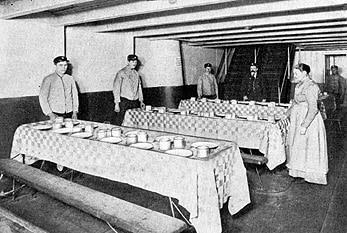
96 | Page
1908 - T.S.S. New Amsterdam I 3rd Class Dining Room where the Easter worship service took place22
Everywhere they had ropes installed, along the stairs below and to the bunks and along both stairs, which led to the dining room. What terrific jolts or rather swells. The sea appears like [a] terrain of hills. Now you see the prow of the ship high plowing into the waves soon to be dunked. Almost all the passengers were seasick. Especially the women personnel. The food remained untouched on the tables. Well still, travelled some 356 miles on this day. A beautiful invention, this Milemeter, and yet very simple.
On the rear of the ship is a sort of clock as large as a Dutch alarm clock. On this clock or rather Milemeter, is fastened a long towrope of approximately 200 meters length on which at the end a copper piece with fins like a fish. When the ship goes forward, the copper piece turns and so the rope turns and inside the clock turns a rod. This rod in turn turns another rod which is attached to the end of the meter. The faster the ship goes forward the faster the rope turns on which is fastened the copper piece. You can tell this way exactly how many miles you’ve travelled. At 12 o’clock the miles are recorded for the entire day. Everyday this is recorded in the dining area for the passengers so that anyone taking the trouble to read this can know how many miles were traveled that day.
On this day we received word from New York about a fire in Boston. This is sent by wireless telegraph. You are about 2 or 3 days from shore so about in the middle of the ocean and there you receive word all the way from New York.
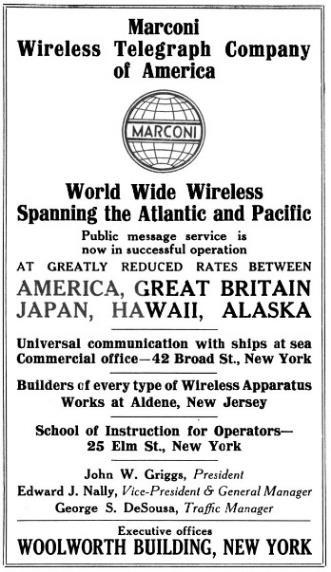
The storm subsided in the afternoon and the sky cleared completely. The day following, April 18, it was nice weather. We discovered in the north on the horizon, smoke. This was believed also to be a passenger boat though we couldn’t determine this through a telescope, which one of the passengers had brought along. We travelled only 342 miles this day.
And yet the sea was not overturning. This must be explained by the strong current which was against us all day. The next day, April 18, it was nice fresh weather, yet a bit cold so that it froze. It was Sunday (Easter). On board we could not tell it was Sunday. Also, there was no worship service aboard the Nieuw Amsterdam, at least not this trip.
97 | Page
My friend, which I spoke about at the beginning, the one from India, asked me if we as Hollanders together wouldn’t have a service. I said to him (my judgement) that we could, but we would have to ask permission first. This was then permitted. We could use the dining room for this purpose. There were around 40 persons who took part in it. So, this day ended. We travelled 370 miles this day.
The other day, April 20, we looked eagerly for land. After 9 days of seeing almost nothing but water and sky one begins to look for land. We were up early in the morning because this was to be the day of arrival. There was little sleeping that last night.
We dropped ourselves over the railing and peered longingly toward the horizon if soon land might be in sight. Finally, yes, the shout is made. Land!
Every eye directed itself to the place pointed out. Is that really land? A dark black spot on the horizon, not more.
We steamed further and further and then truly this is finally land. The land, our place of destination. Now it is all commotion. Everyone is looking over the rail. Women hold their children high because these must see the land also. We are coming closer. Everything is beginning to look plainer. Here too we see more shipping. Sail and steamships right and left. In the distance comes the tugboat. This officer must bring us to harbor.
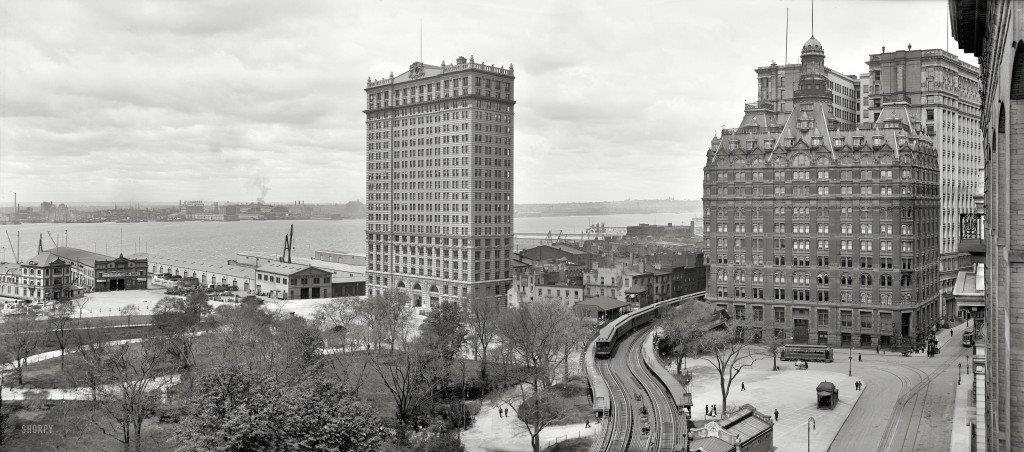
98 | Page
1908 – New York Harbor from the Battery (Public Domain)
He is brought aboard in a boat by two sailors. We are learning ahead is now clear. A beautiful sight over the water. How too bad that we as 3rdclass passengers could not see much of this. We were all locked up in the dining hall where we couldn’t see much. They say this is also an American law that before docking all 3rd class passengers must remain below. Finally, we could feel that the boat had stopped.
We are undoubtedly not yet at the place we should be. The Doctor was put aboard. For this we had to pass by with bare heads. When this is finished and the Doctor has left, the ship again began to move. Slowly we proceed. Every one now is on deck. It was twilight, about 8 P.M.
What a sea of lights to the right and left. Giant buildings, electrically lighted, beautiful Salons (stores), costly lighted, were all ahead and behind. Finally, the New Amsterdam lay still, close to the dock (Holland American Line we read). There we must be. 3 motorboats push the big ship to its berth. We are at land.
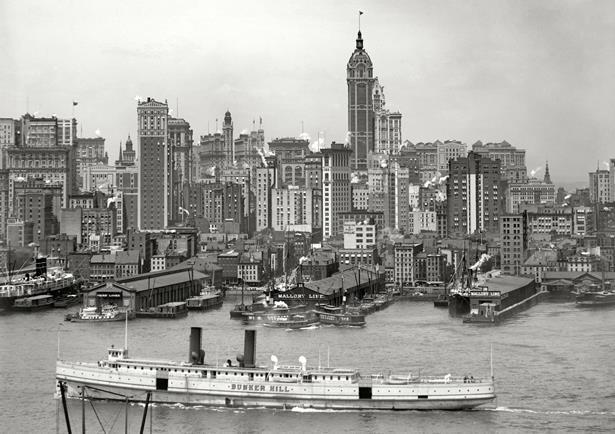
99 | Page
1908 - New York City skyline23 2323 http://www.shorpy.com/node/9457?size=_original
The 1st and 2nd class passengers may disembark immediately. But we 3rd class passengers must remain on board until morning. This night something happened which was of some interest to tell. It was around 10 o’clock, we were not yet to bed because a person is not sleepy on such nights. One finds on such steamships fire alarms. By every exit is a glass case with a fire alarm inside. When someone discovers fire, he breaks the glass and presses a button inside the alarm. This alarm is connected to the cabin of the captain, the 1st and 2nd pilot, yes, all the officers.
Now there was one of the passengers who had loosened the screws on the glass case and pressed the button of the alarm. Everything in turmoil. The captain, the pilots, the officers, the sailors, all on deck because there was a fire according to their thinking. This appeared not to be true. It was sort of a joke. The night advance without incident. We had gone 373 miles the last day (20th April).
The following morning, April 21, we awoke very early. It was beautiful weather. We packed our belongings and left the boat around 9 o’clock. First our baggage and luggage had to be inspected. This is quite a chore. Everything must be opened. Every [one] who travels to America is advised to securely seal all their baggage. We saw baggage that had been completely broken. Now this operation ended [and] we were taken by boat to Ellis Island. This was the worst day of the whole trip. We came there about 11 A.M. Not to leave this building until 6 P.M. Here we had to be approved again.
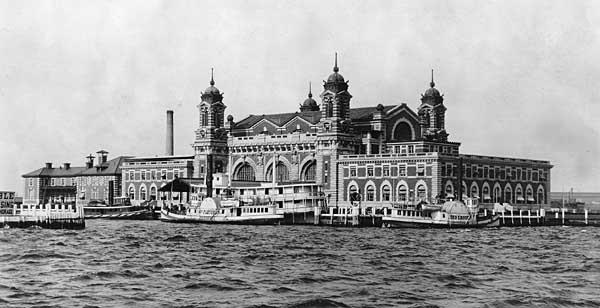
100 | Page
1908 – Immigrants process though Ellis Island24 24 https://archhistdaily.wordpress.com/tag/ellis-island/
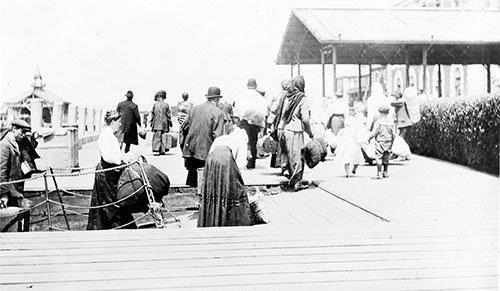

101 | Page
– Immigrants disembarking the
to enter the
Island25 1907 – Immigrants line up at Ellis Island26 25 https://www.gjenvick.com/Immigration/EllisIsland/1908-04-TheImmigrantProcessingAtEllisIsland.html 26 https://archhistdaily.wordpress.com/tag/ellis-island/
1908
boat
buildings at Ellis
The eyes, the passenger’s papers inspected, the baggage again inspected, etc. etc. too numerous to mention. We were visited here in this building by Dr. Van den Heuvel with two elders. These are at present there to help Dutch immigrants. There was one family from Zeeland who had lost their ticket. The man
27 https://www.gjenvick.com/Immigration/EllisIsland/1908-04-TheImmigrantProcessingAtEllisIsland.html
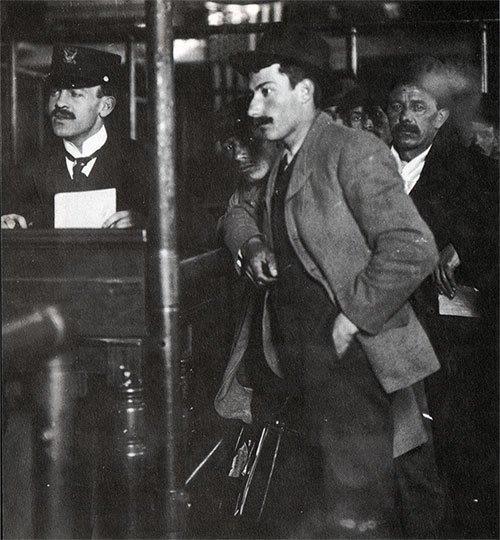
102 | Page
1908 – An immigrant answering questions at the Inspector’s Desk at Ellis Island27
was nearly overcome with fear. Because the ship brought him no further than New York. Through intervention of Dr. Van den Heuvel and helpers they were fortunate to be able to help them.
The Immigrants were divided here into different groups. One had to go to Chicago. The other to Iowa (Orange City), a third to Holland, Michigan, a fourth to Kalamazoo, Michigan, etc. So that we had to shake hands with our good friends who had to go in an entirely different direction than we. A family from Deventer, a woman and children, the oldest child around 18 and the youngest around 2 years old, were in our group to go to Kalamazoo, Michigan.
28 https://www.gjenvick.com/Immigration/EllisIsland/1908-04-TheImmigrantProcessingAtEllisIsland.html

103 | Page
1908 – Doctor examining the eyes of a female immigrant at Ellis Island28
April 11, 1908 – T. S.S. Nieuw Amsterdam I Rotterdam Ship Manifest
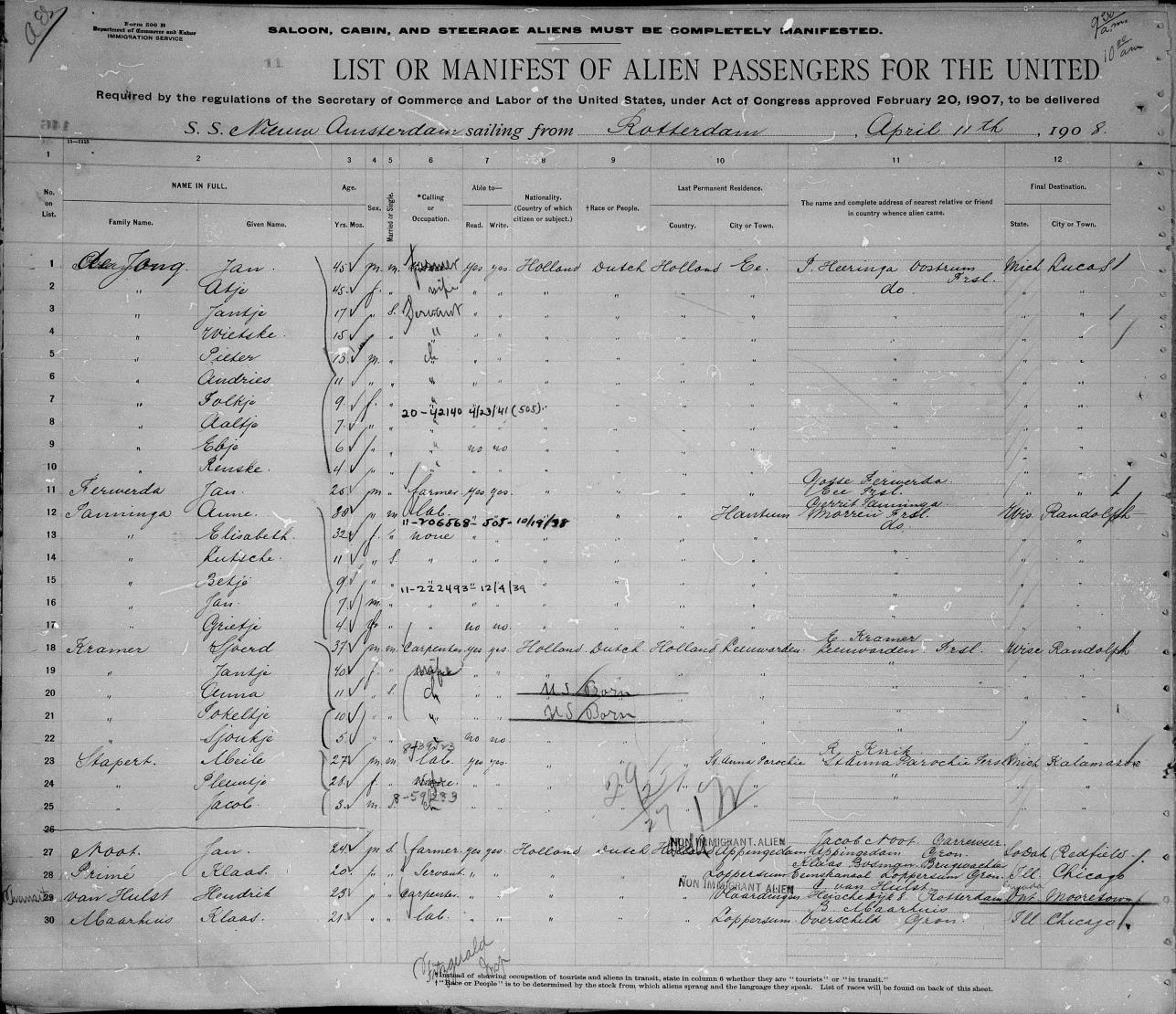
A friend, Charley from Patterson, New Jersey was present in this building, but would not allow be allowed to see us 3rd class passengers. Finally, around 6 o’clock in the afternoon we might leave.
[Editor’s note – Although this story does not mention the Statue of Liberty, it is very likely that the Smit family saw the Statute of Liberty while they were at Ellis Island.]
104 | Page

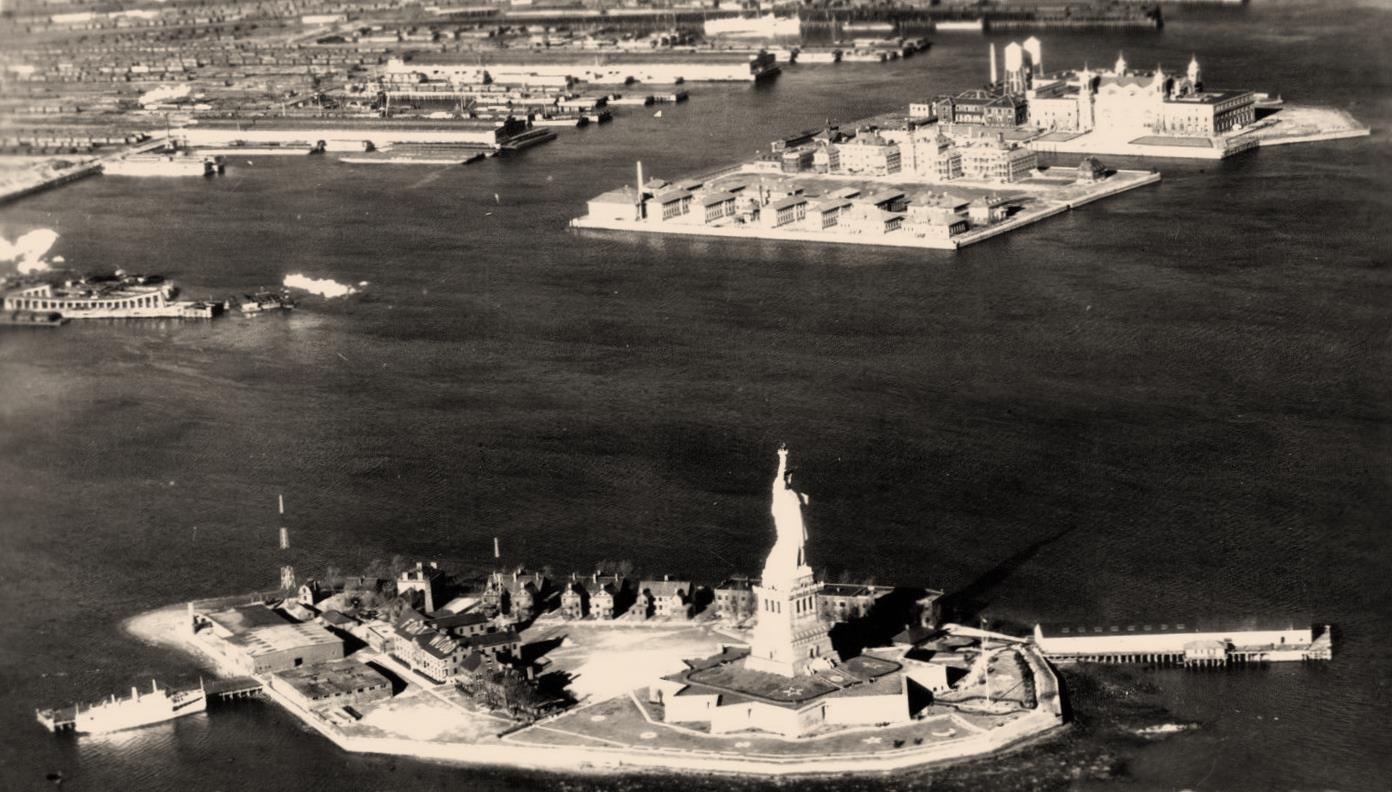
105 | Page 1877 - Immigrants in European dress on the
of a
see the Statue of Liberty29 Statue of Liberty on Bedloe’s Island, Ellis Island, New York Bay30 29 https://www.familysearch.org/wiki/en/File:Immigrants_Behold_the_Statue_of_Liberty.jpg 30 https://picclick.com/Statue-of-Liberty-New-York-Bay-NYC-RPPC-263244648578.html#&gid=1&pid=1
deck
ship
We were transported by steamship to the station. Over there, we were taken by wagon [to the train]. Around 7 P.M. the train began to move. Praises and thanks to God we said to each other, we are riding. We had brought along some food so that for the present we wouldn’t have to go hungry. At Ellis Island you could buy a box of food for $1.0031, but this seemed too expensive to us. We sped joyfully and healthy toward the west.
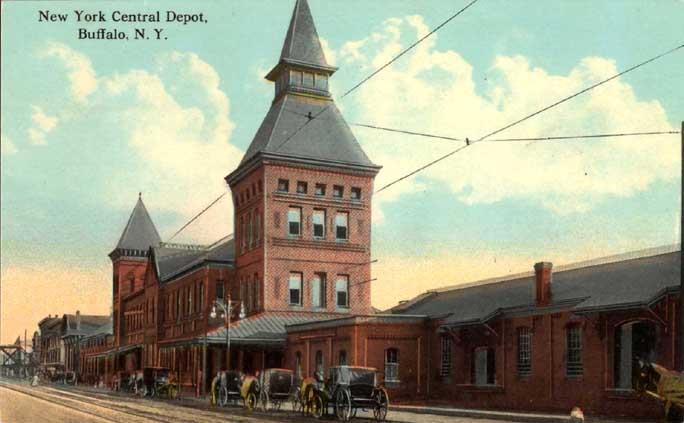
The trains in America are better equipped than in the Netherlands. Each car is equipped with a toilet and drinking fountain, etc. and usually a dining car. The seats are fine. No wooden benches, but soft cushions making rest easy. The trains go faster than in the Netherlands. This is because the distances are so great between stops. Sometimes you speed for 2 to 3 hours in one stretch before stopping.
32
The next morning we arrived in Buffalo after an entire night riding. It was now 7 o’clock in the morning. Here we had to get out. A conductor led us to a sort of waiting room. There we sat again. We didn’t know for how long. When we had waited for about 2 hours we thought to get information when we would again
31 $1.00 in 1908 is the equivalent of $27.50 in 2018 dollars.
32 http://buffaloah.com/h/nycent/depot.jpg
106 | Page
Train station in Buffalo, New York
leave. But since no one could understand us because we were Hollanders and couldn’t speak English, till finally a conductor appeared in the waiting room and asked for our ticket. Now having seen this he indicated on his watch that we didn’t have to wait until 2 P.M. From 7 A.M. to 2 P.M. means something, especially since you can’t speak with anyone. Luckily, we were together as Hollanders.
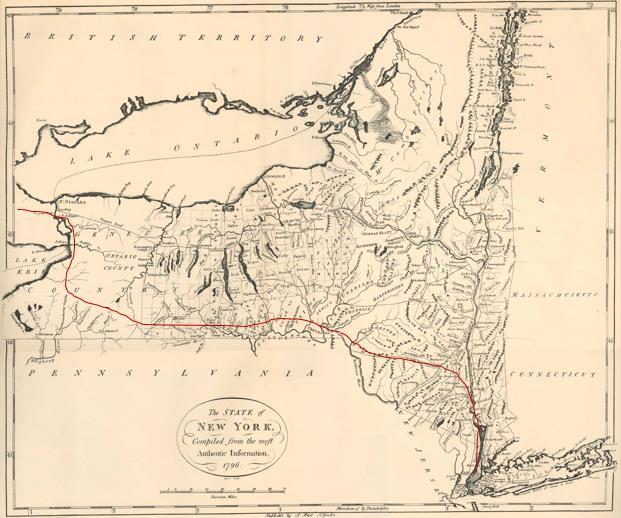
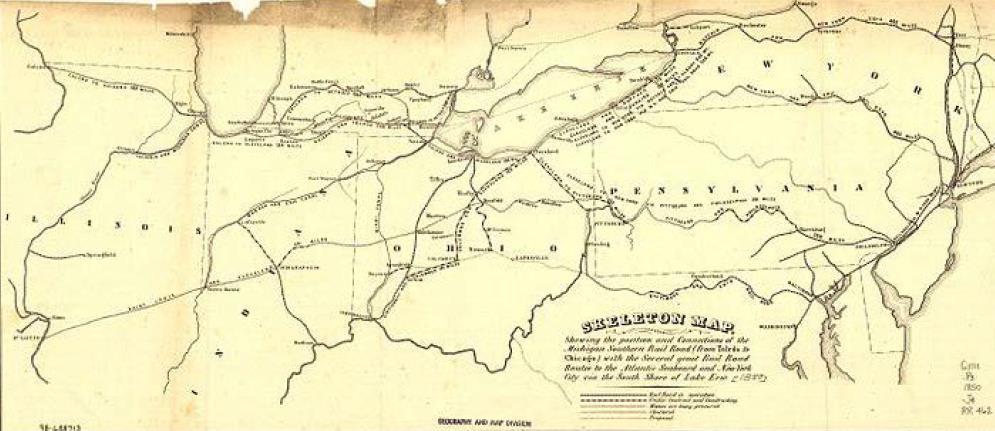
107 | Page
1850 - Railroads in the United States ( Route the Stapert’s took)
1796 – New York State Map ( Route the Stapert’s took)
Buffalo Niagara Falls
Kalamazoo o
Finally then, because the time doesn’t stand still in Amerika either, it was 2 o’clock. They didn’t forget us on the train. At 10:30 I had sent a telegram to my brother in Kalamazoo. I did this in view of our arrival in Kalamazoo so that they could pick us up at the station. This process was difficult.
We could locate the telegraph office because we could read that, almost exactly as in Dutch. But how to proceed from there. We could talk to anyone. Accidently I spoke to a conductor who could speak German and could understand what we wanted. He went to the telegraph office with us and directed us how to proceed. It read in English, “Arrival in Kalamazoo at 8:02 A.M. Pick us up at the station.” How this telegram proved to be in error. It should have read 2:08 instead of 8:02.
Our intention was to arrive in the morning at 8:02 in Kalamazoo and so we boarded the train again at 2 P.M. in Buffalo. Toward the west, always toward the west through hill and dale, fruitful and worthless ground. At around 6 P.M. we came to Niagara Falls. The train stopped here for 5 minutes, primarily to allow passengers to see it. We could leave the train for 5 minutes. I also did this. This is a beautiful showplace. The water dashes down some hundred feet to the bottom with a thundering roar. The sun throws its rays upon the descending water. A beautiful majestic showpiece.
Again we travelled west. We rode through Canada. An immigration official stepped on the train and marked our baggage with a blue card. Now we can travel uninterrupted through the English country of Canada.

108 | Page
1908 Niagara Falls Postcard
If we were Canadian immigrants, our baggage would have been inspected, not now. We had to go farther. The night approaches, it is eventually night. We fell asleep from the tiredness, till finally a conductor awoke us and said, “Kalamazoo.”
Quickly we got our things together and followed the conductor, still thinking that we must get out to transfer to Kalamazoo. It was now 2 o’clock at night. How puzzled we looked when at some distance we saw brother and wife waiting for us. They didn’t recognize us anymore. We hadn’t seen each other for 17 years. I recognized him immediately and also his wife. It was the shout, “How are things with you?” And I grabbed his hand. What a meeting and so unprepared. We came sleeping into Kalamazoo. Instead of 8:02 in the morning it was 2:08 in the night. Fortunately, everyone was feeling healthy and happy. We were received with joy.
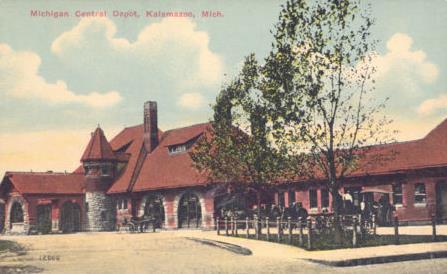
109 | Page
Kalamazoo Michigan Central Railroad Train Station Postcard
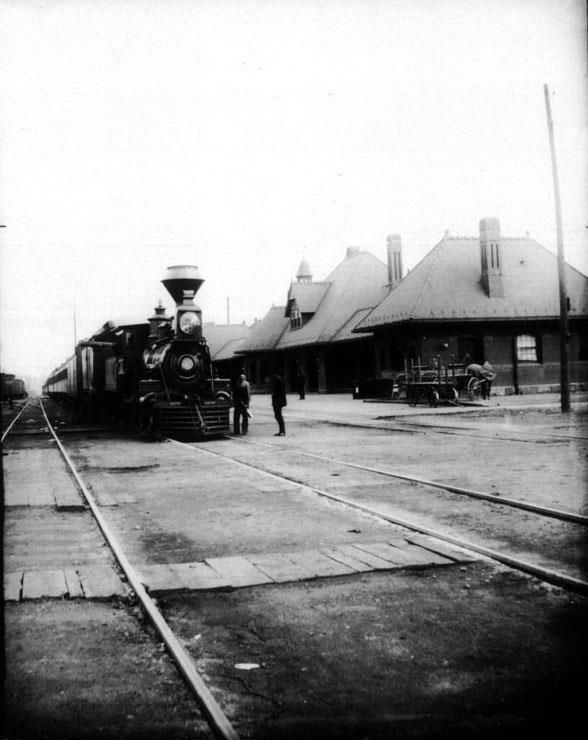
110 | Page
1887 – Train arrives at the Kalamazoo Michigan Central Railroad Train Station
How much my brother had to tell and how much we had to inform them of. Happily we saw our family again in good health.
God led through rough waters
And broad streams, a path for us.
[From Jesaja 43:2a, “Wanneer gij zult gaan door het water, Ik zal bij u zijn, en door de rivieren, zij zullen u niet overstromen.” - Dutch States Bible
[From Isaiah 43:2a, “When thou passest through the waters, I will be with thee, and through the floods, that they do not overflow thee.” – 1599 Geneva Bible]
This is a short sketch of what the Smit’s trip from the Netherlands to Kalamazoo, Michigan was likely like!
NOTE: The Majestic ship was built by Harland & Wolff Limited, Belfast, Ireland, 1890. 9,965 gross tons; 582 (bp) feet long; 58 feet wide. Steam triple expansion engines, twin screw. Service speed 20 knots. 1,490 passengers (300 first class, 190 second class, 1,000 third class). Two funnels and three masts, 1903 masts reduced to two. It was built for White Star Line, British flag, in 1890 and named S.S. Majestic 1 (1890). Liverpool and Queenstown to New York service. It was a sister ship of to the Teutonic.
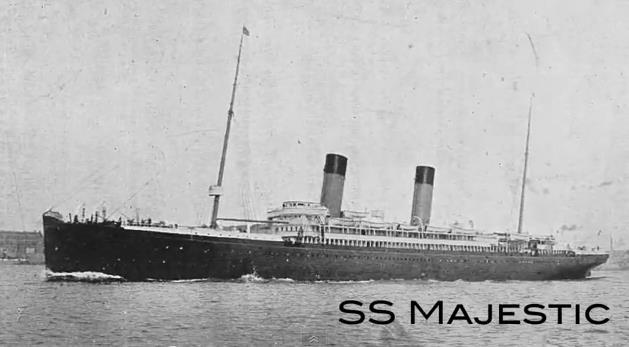

111 | Page
http://www.youtube.com/watch?v=VP46USxORgQ
Video of the S.S. Majestic (2) in New York City
It was noted in Ellis Island that Albert was 5’ 5 ½” and weighted just 125 lbs. He had light brown hair and blue eyes.

Albert and Jentje Smit and family initially lived with their son John who had come over in 1901. He lived at 1516 Kooley (Cooley) (Street) Drive, Kalamazoo, Michigan.
Eventually, Albert and Jentje bought a house on Winslow Ave. (now Woodward Ave.) in Kalamazoo, Michigan. The house the Smit family moved into on Winslow Ave. was right near the railroad tracks. As the trains passed by the house, it felt like the train was entering the home. After they lived there for a while, the landlord told them about a new home, two blocks to the north on the same street that had not yet been lived in. It also came with a garden and so the Smits moved.
It was a wonderful home with a large kitchen, dining room, living room and downstairs bedroom along
33 Ellis Island Web Site http://www.ellisisland.org/search/passRecord.asp?MID=18910013820881091776&LNM=SMIT&PLNM=SMIT&bSYR=1893&bEYR =1907&first_kind=1&last_kind=0&RF=385&pID=102778090450&
112 | Page
Ellis Island Web Site33
with three bedrooms upstairs. In the backyard it had wood shed that the kids also played in. They soon added a chicken coop. Nearby was a hill the children could go sliding on in the winter.34
A year after they lived in the new home, another Dutch family, the Stapert family moved next door.35 The Stapert’s had a daughter Winifred who later married Sam Smith and had a daughter Barb who married Charles Micheals, the great-grandson of Albert and Jentje Smit and who is the author of this book.
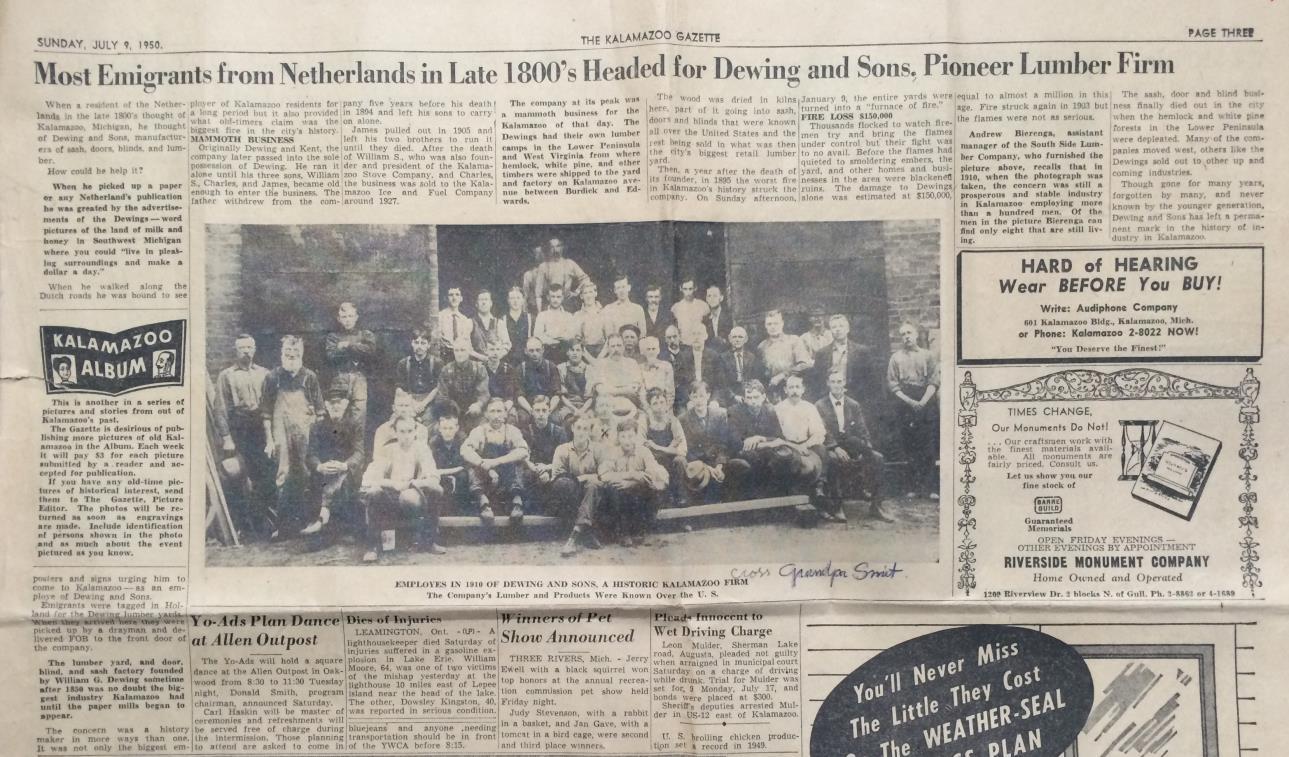
Albert first took on a job in Kalamazoo digging trenches for the city sewer. He eventually found a job at the Dewing and Sons (also known as Dewing Brothers), a pioneer lumber yard that recruited many Dutch immigrants. Albert liked the work at the Dewing company.36
34 Alice (Smit) Meyer’s diary, page 3.
35 Alice (Smit) Meyer’s diary, page 4
36 Alice (Smit) Meyer’s diary, page 3.
113 | Page
Albert Smit (marked with x) worked for Dewing and Sons (From the Kalamazoo Gazette on July 9, 1950)

114 | Page
Albert Smit (marked with x) works for Dewing and Sons (From the Kalamazoo Gazette on July 9, 1950)
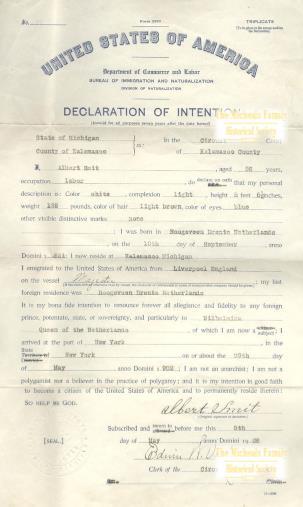
115 | Page
Albert becoming an American Citizen (Photo courtesy of Charles Micheals)
On September 17, 1908, Alice’s sister Susie married Jannes (John) Mejeur who also attended Second Christian Reformed Church. John and Susie Mejeur first rented a house on North Church Street in Kalamazoo, Michigan. John eventually built a house one block away from where the Albert and Jentje Smits lived at 1507 Clark Ave (Now Princeton Ave).
In 1909 Alice Smit’s brother Garret married Johannah Weenink and in 1910 Alice’s brother Jannes (James) was courting Al Meyer’s sister Anna.
In 1910, Al Meyer from Kalamazoo and Garret Smit, who both attended Second Christian Reformed Church, heard about work on a farm in Sioux Center, Iowa, as Al Meyer’s sister Anna described in her autobiography as the “great farms in the far west. With the promise of wide-open fields and steady work, the two young men left Kalamazoo on March 21, 1910.38
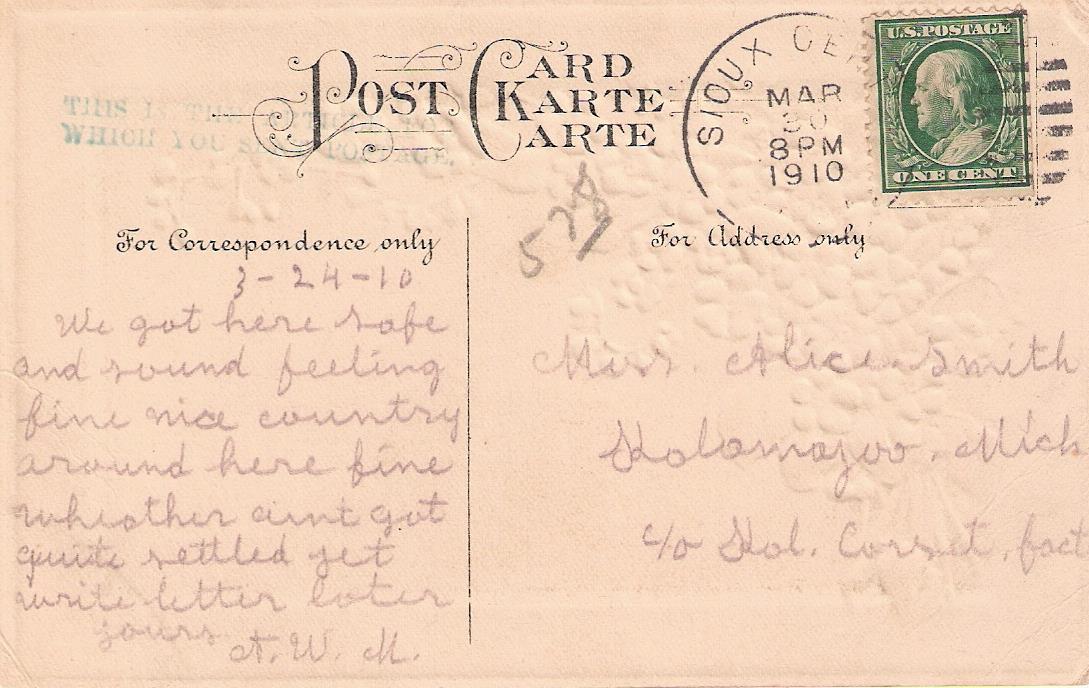
37 Note – It was common for immigrants to ‘Anglicize’ names and it is likely that for some time Alice Smit used the last name of “Smith.”
38 Anna (Meyer) Smit’s Diary, page 6
116 | Page
March 20, 1910 – Al Meyer’s postcard to Alice Smith send to her via the Kalamazoo Corset Factory37 (Photo courtesy of Charles Micheals)
During this time, Garret and Al began correspondence with Alice Smit because they were lonesome. Garret didn’t stay in Iowa long and he returned to Kalamazoo. However, Al stayed in Iowa for nine months, but he too came home to Kalamazoo when Al’s father became ill. That was when Al and Alice began courting.

117 | Page
1909 - Postcard of the Christian Reformed Church in Sioux Center, Iowa (Public Domain)
39
39 Alice (Smit) Meyer’s Diary, page 4.
1905 – Kalamazoo, Michigan City Directory – Albert and Jennie Smit lived at 1321 Winslow Ave. (now Woodward Ave.), Kalamazoo, Michigan
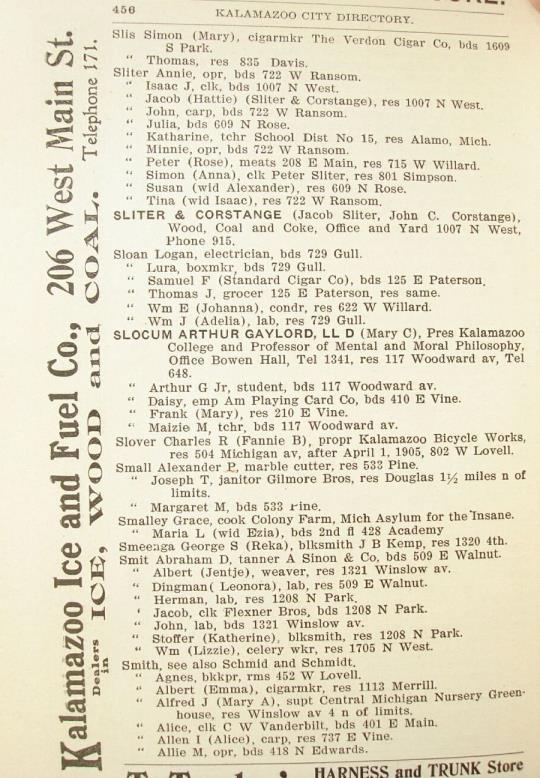
After John Mejeur had married Susie Smit he saw an advertisement in the Christian Reformed Church publication, The Watcher, that land was for sale at bargain prices in the Birnamwood, Wisconsin area. It stated that the other Dutch families living there wanted families who had emigrated from the Netherlands to move there.
In March 1910, Albert and Jennie Smit and three of their children Alice, Albert Jr. and Helen, John and Susie Mejeur and their new baby Uko move to Birnamwood, Wisconsin Albert and Jentje’s oldest son John and his wife Anna Smit who had been living in Kalamazoo, but moved to Denver, CO with their four children also moved to Birnamwood.
118 | Page
In Birnamwood, Wisconsin, Albert and Jentje Smit, John and Anna Smit and John and Susie Mejeur all went together and purchased 80 acres They all joined the Birnamwood Christian Reformed Church and found many friends there.
Albert and Jentje Smit’s Birnamwood Christian Reformed Church records 1911 and 1922 (Public Domain)
They stayed there for a few years and for unknown reasons decided to move back to Kalamazoo. What exact work Albert did when the family moving back to Kalamazoo is unknown.

119 | Page
After moving back to Kalamazoo Albert’s wife, Jentje died. After her death, he and John and Susie Mejeur decided to move back to Birnamwood. They rejoined the Birnamwood Christian Reformed Church they were members of back in 1910. Susie Mejeur was pregnant when they moved. They took up farming again and sad news followed them to Wisconsin.
It was there that Albert received the news that his second oldest son, Jannes (James) Mejeur, living in Kalamazoo had caught what was likely the Spanish flu. He developed pneumonia from that and died on February 26, 1920. That left his wife Anna with three little children.

120 | Page
Jentje Smit’s Death Certificate (Photo courtesy of the Kalamazoo County Court House)
Work progressed at the home in Wisconsin and it seemed as if sorrow had left them because on September 24, 1920, Susie Mejeur gave birth to a beautiful baby girl “Alberdina Mejeur” (this baby was unofficially called “Sue” after she was born, but her name was not officially changed until November 4, 1947 or just before Sue Mejeur married Frank Micheals. At that time, her name was changed to “Sue Alberdean Mejeur”). Soon after the birth, however, Susie took a turn for the worst and became sick with a blood infection likely caused by a bacteria. She died in Marathon Country, Norrie Township, Hatley, Wisconsin on October 2, 1920 and was buried in the Forestville, Cemetery.
According to Birnamwood CRC membership records, Albert Smit left again for Kalamazoo on April 23, 1922 and the Mejeur family soon followed him. They left for Kalamazoo on May 30, 1922. John Mejeur’s brother Henry stayed in Birnamwood as did the Smit’s youngest daughter Helen. Those two had been courting and would soon be married.

121 | Page
Birnamwood Christian Reformed Church (Photo courtesy of Harvey and Ardythe Ouwinga)
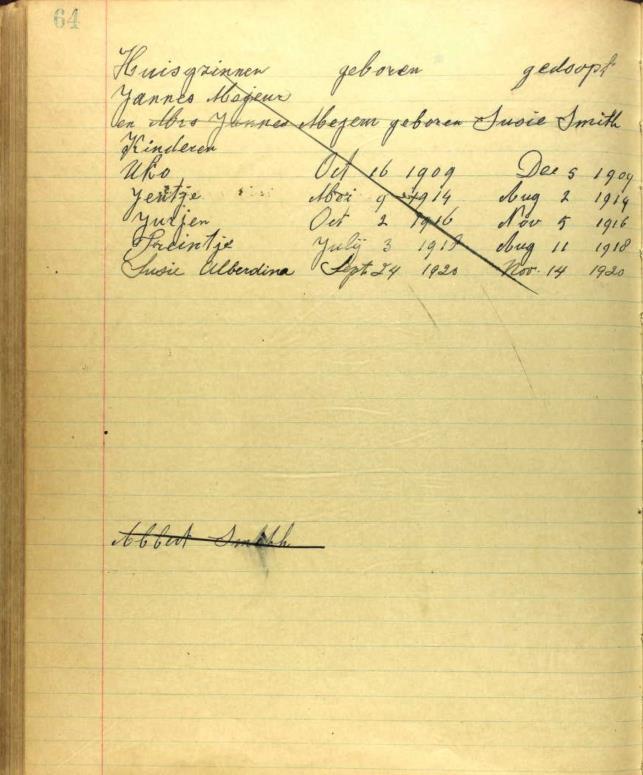
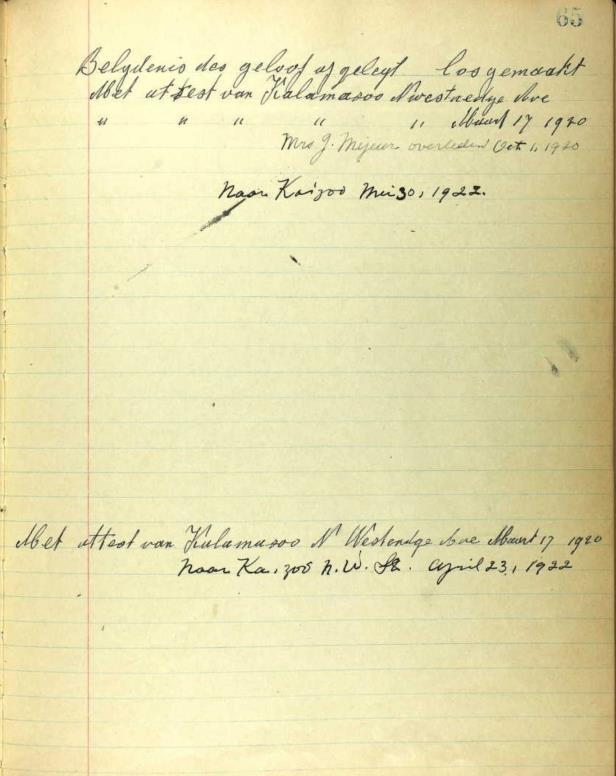
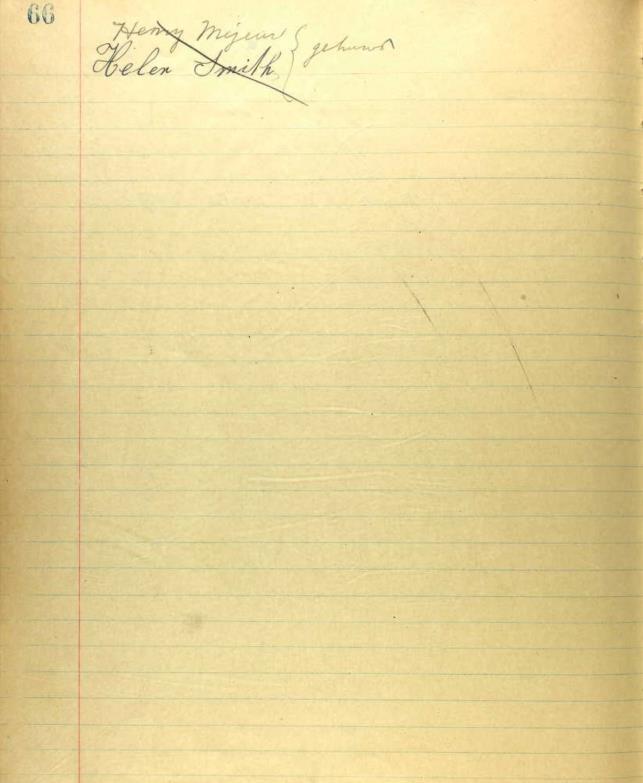
122 | Page
Albert and Jentje Smit’s Birnamwood Christian Reformed Church records in 1922 (Public Domain)
Henry Mejeur and Helen Smit’s Birnamwood Christian Reformed Church records in 1922 (Public Domain)
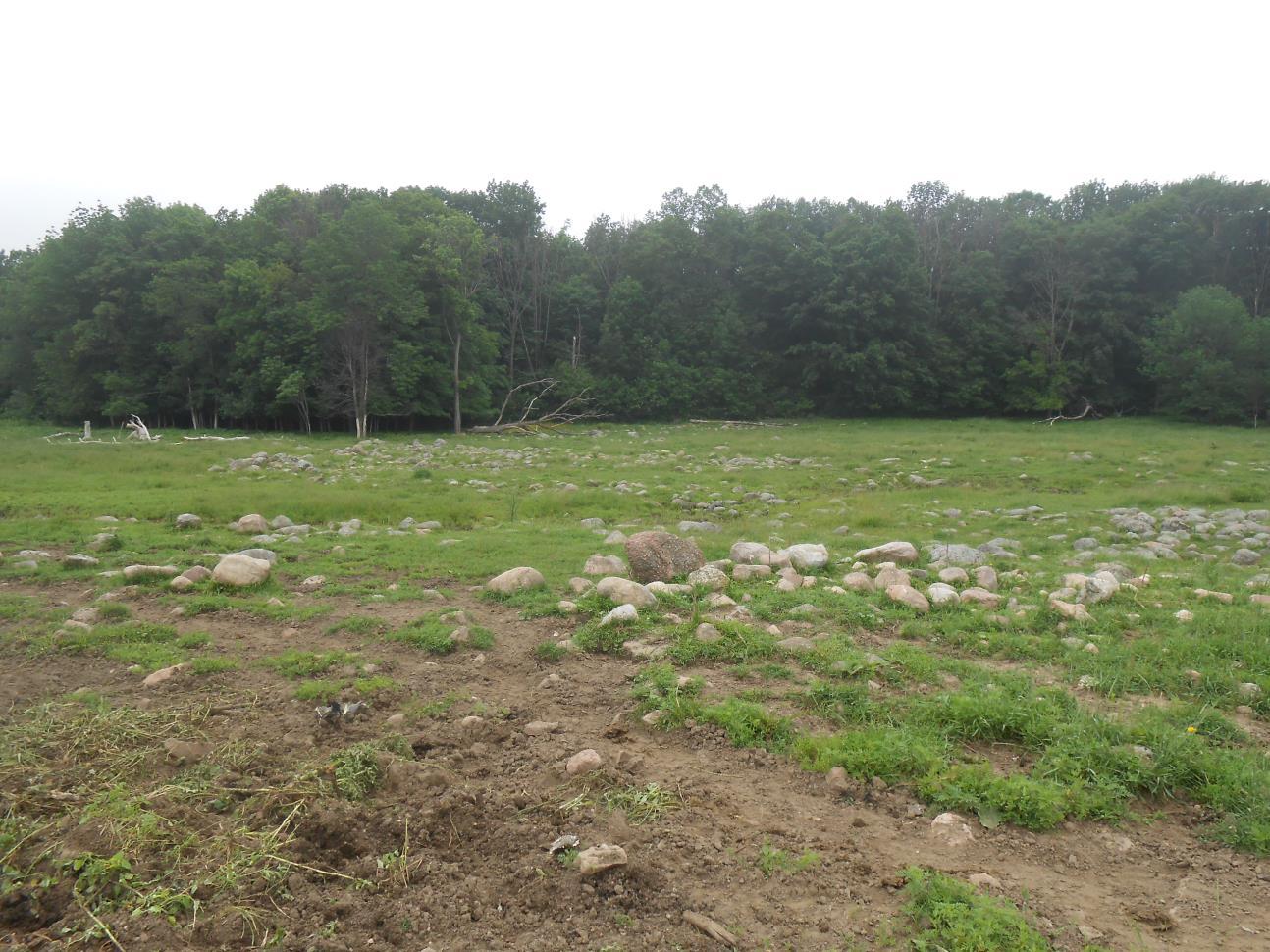


123 | Page
Birnamwood, Wisconsin “Farm Land” (Photos courtesy of Charles Micheals)
1957 - Birnamwood Christian Reformed Church
2013 - Now a private home
(Photo courtesy of Harvey Ouwinga)
(Photo courtesy of Charles Micheals)
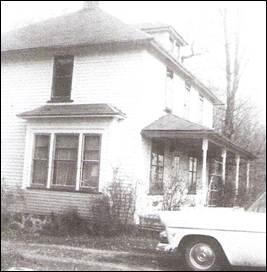
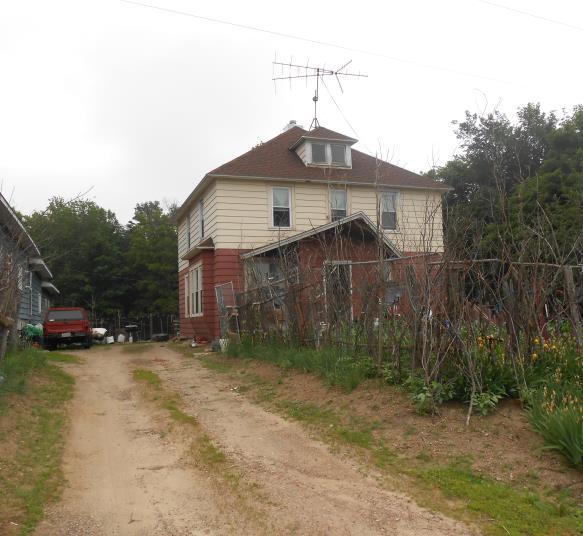
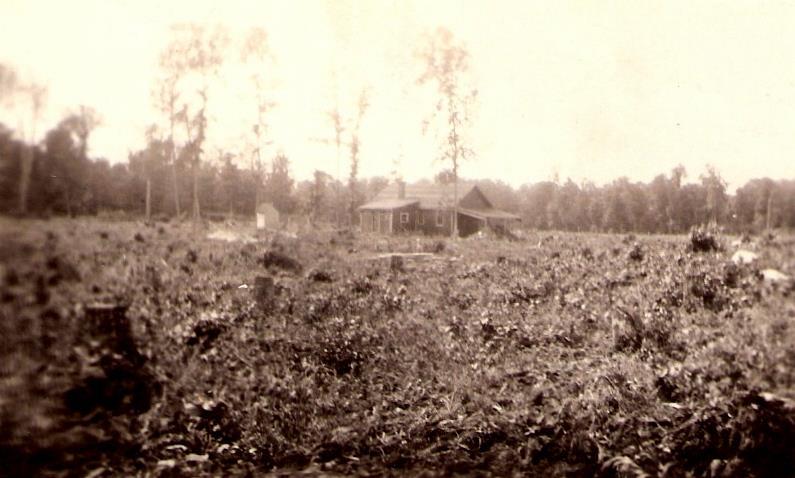
124 | Page
1957 - Birnamwood Christian Reformed Church Parsonage 2013 – Now a private home (Photo courtesy of Harvey Ouwinga)
(Photo courtesy of Charles Micheals)
Al and Alice Meyer’s house in Birnamwood, Wisconsin (Photo courtesy of Charles Micheals)
About The Author

Charles Micheals is a native of Michigan and lived the first thirty years of his life there, eventually working in the grocery industry. In 1985, Charles, his wife Barbara and their four small children joined Wycliffe Bible Translators and moved to the country of Papua New Guinea (PNG) where they worked with the internationally known non-profit linguistic organization, SIL International (formerly the Summer Institute of Linguistics). Charles served in a variety of administrative roles in PNG, including several years as the Chairman of the SIL PNG Job Evaluation and Wage Review Committee and on the SIL PNG Executive Committee.
During their 15 years of service in PNG, Bible translation work was completed in 67 languages and over 100 additional Bible translation projects were started. Today, almost 180 language communities, representing 1.8 million people in PNG have access to the Scriptures in their own languages.
In 2000, Charles and Barbara moved back to the USA and Charles served for several years as the Regional Director for Recruitment for Wycliffe, living in the Chicago, Illinois area. In 2004 they moved to Orlando, Florida where Charles served for six and one half years as the Vice President for Recruitment Ministries for Wycliffe. He currently heads up Wycliffe’s Management Recruitment and Professional Department and speaks at various mission conferences and colleges each year. Barbara coordinates several Wycliffe short term mission trips each year.
Charles holds a BS degree in Food Distribution from Western Michigan University and a MA degree in Organization Management from Dallas Baptist University. He served on the Board of Directors for The Finishers Project, a non-profit mission dedicated to helping people in the second half of life find places to serve in missions. He has also been involved in helping create and develop Mission Teach, a ministry dedicated to helping place teachers in MK (Missionary Kid) mission schools around the world and Military
125 | Page
Believer, a growing ministry dedicated to helping military personnel who are leaving the military, find opportunities for service in global missions.
Charles has also authored a number of articles about the work of SIL in PNG and other historical articles about life in the Aiyura Valley in PNG. (http://issuu.com/cbmicheals/docs)
Both Charles and Barbara are members of Saint Andrew’s Chapel in Sanford, FL and are involved in a variety of church activities there. Charles serves as an elder at the church. However, they are still members of Second Christian Reformed Church, in Kalamazoo, Michigan which is the church that commissioned them for their work with Wycliffe. All four of their children are actively supporting missions and church ministry work. Two of their four children are serving with Wycliffe around the world.
126 | Page
127 | Page
Back Cover – Jans Pieter Smit
(Photo courtesy of Charles Micheals)
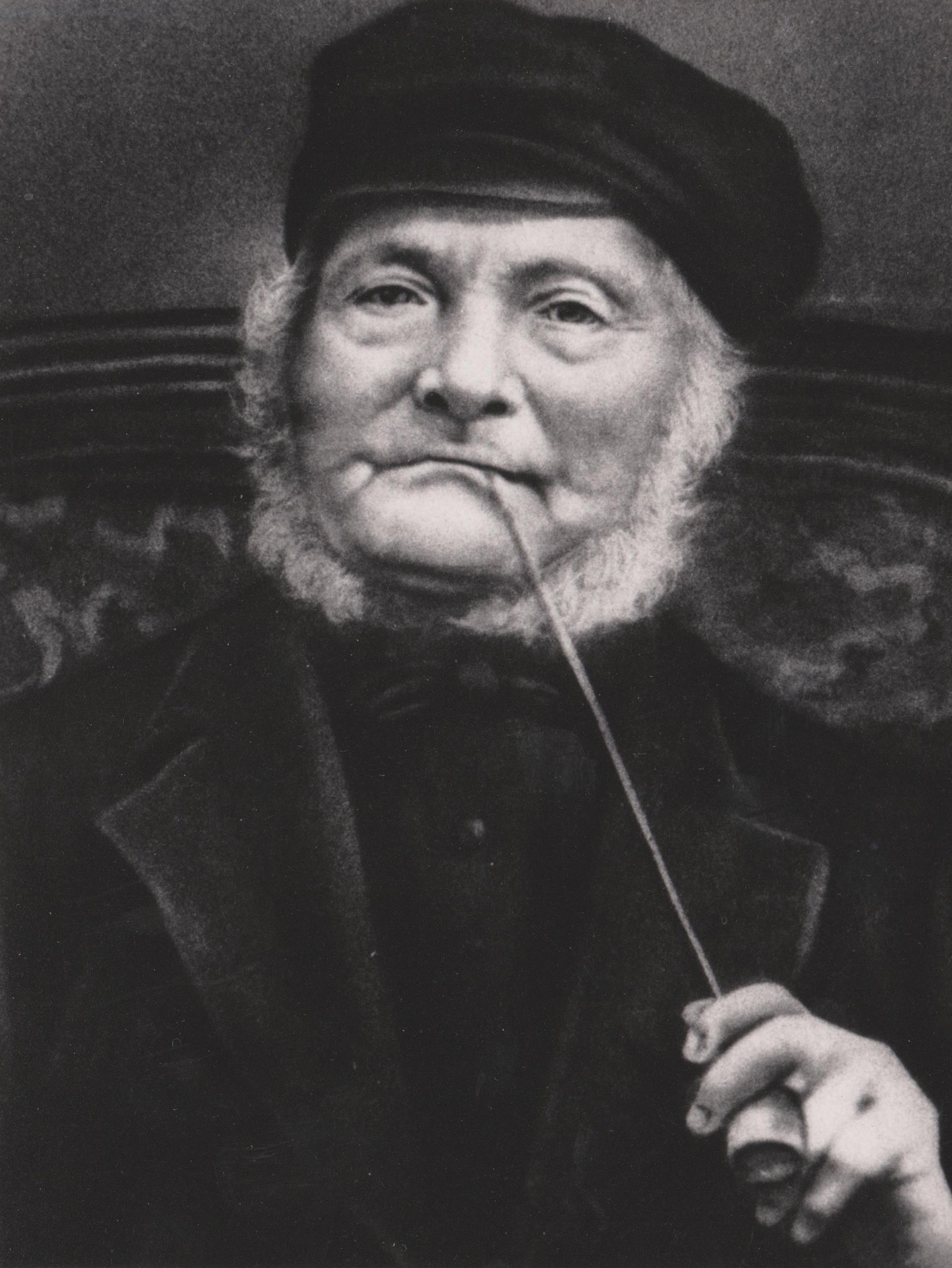








 By Charles Micheals
By Charles Micheals



































































































